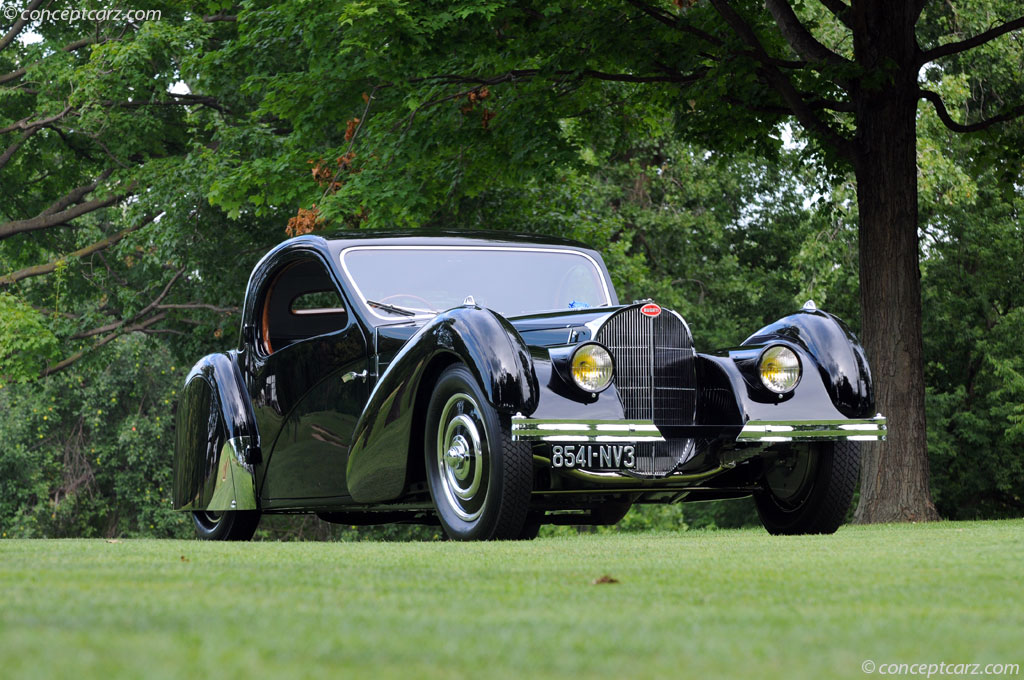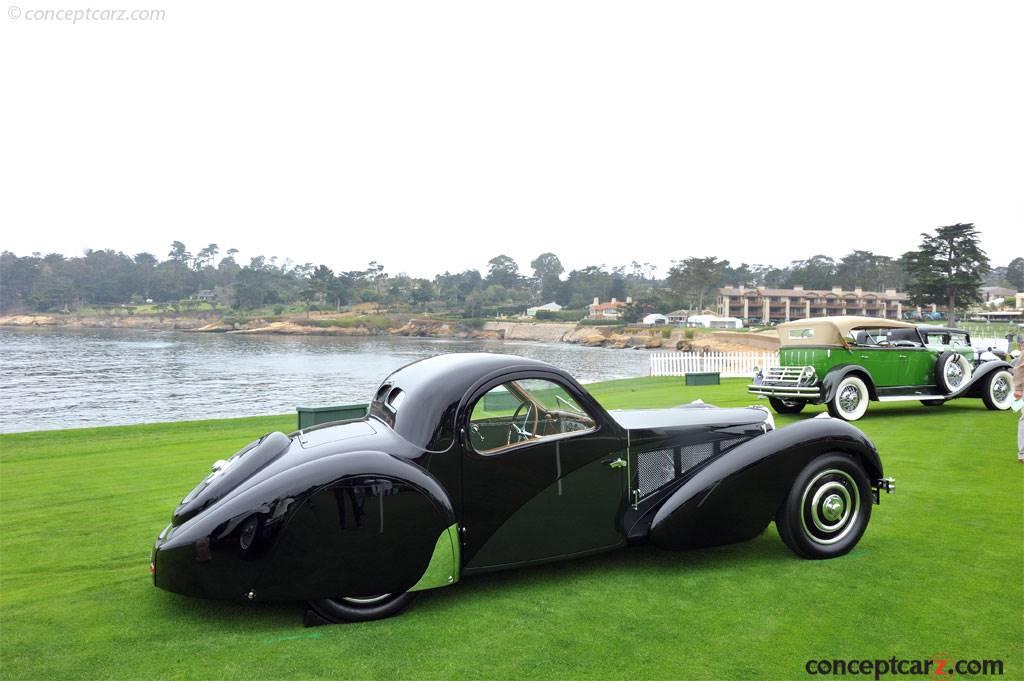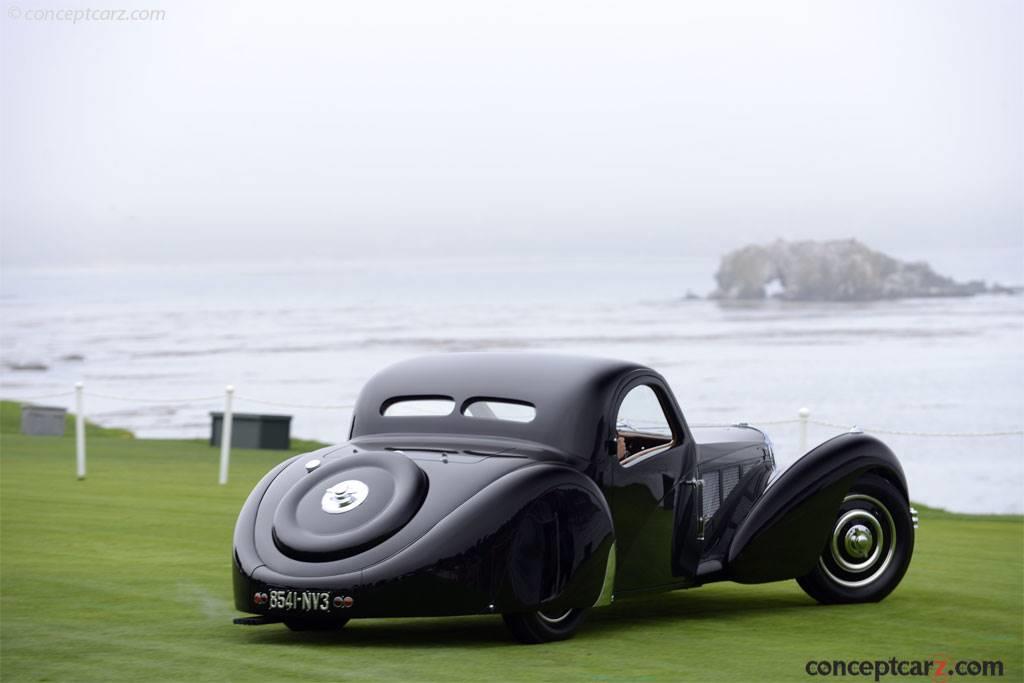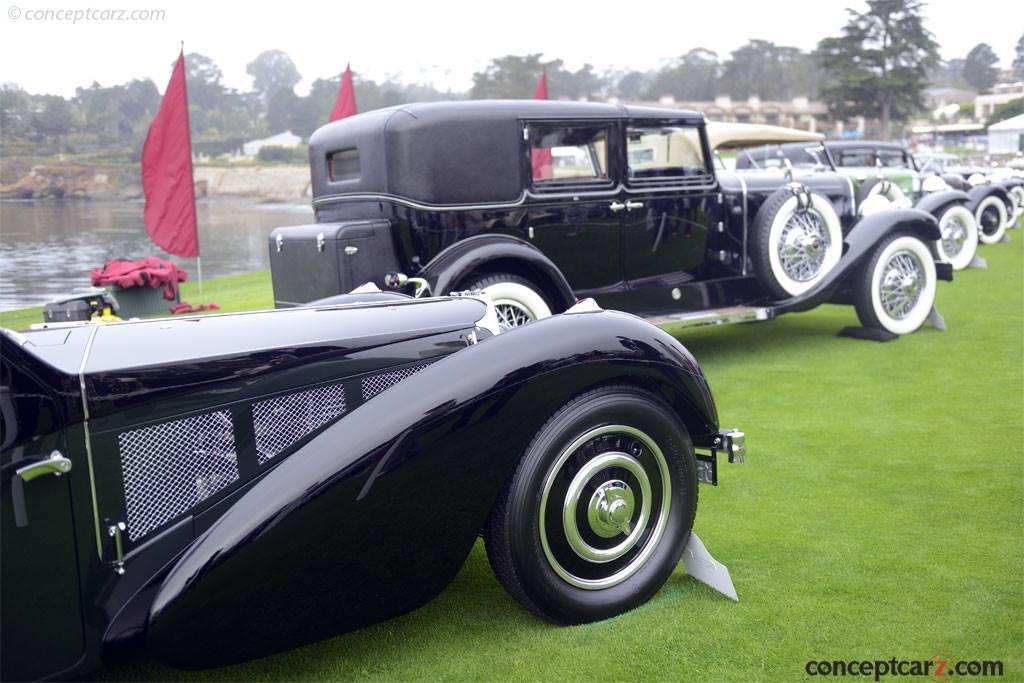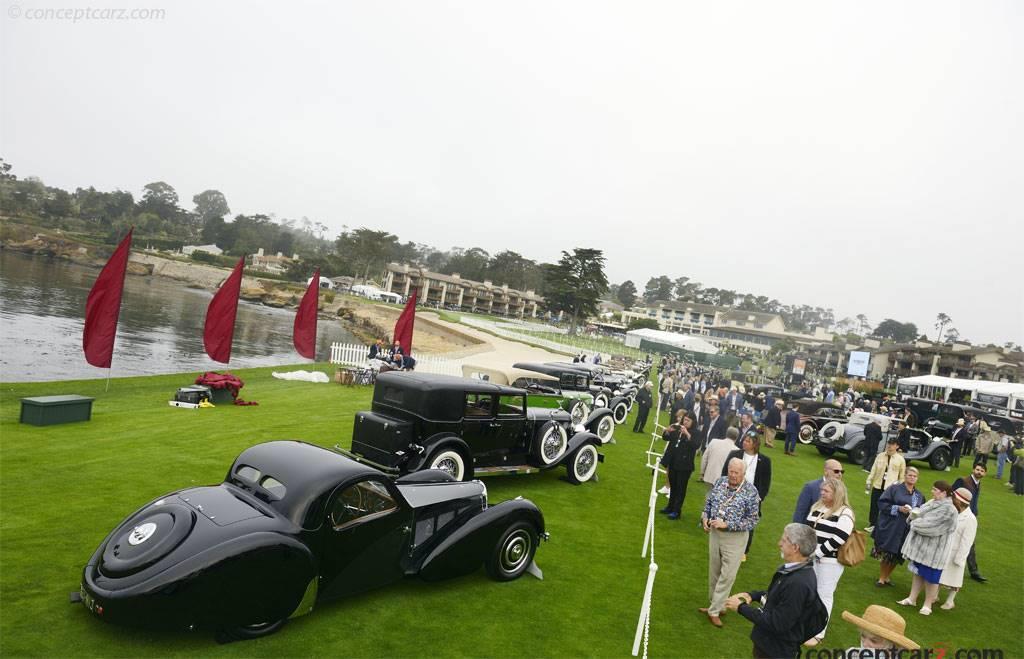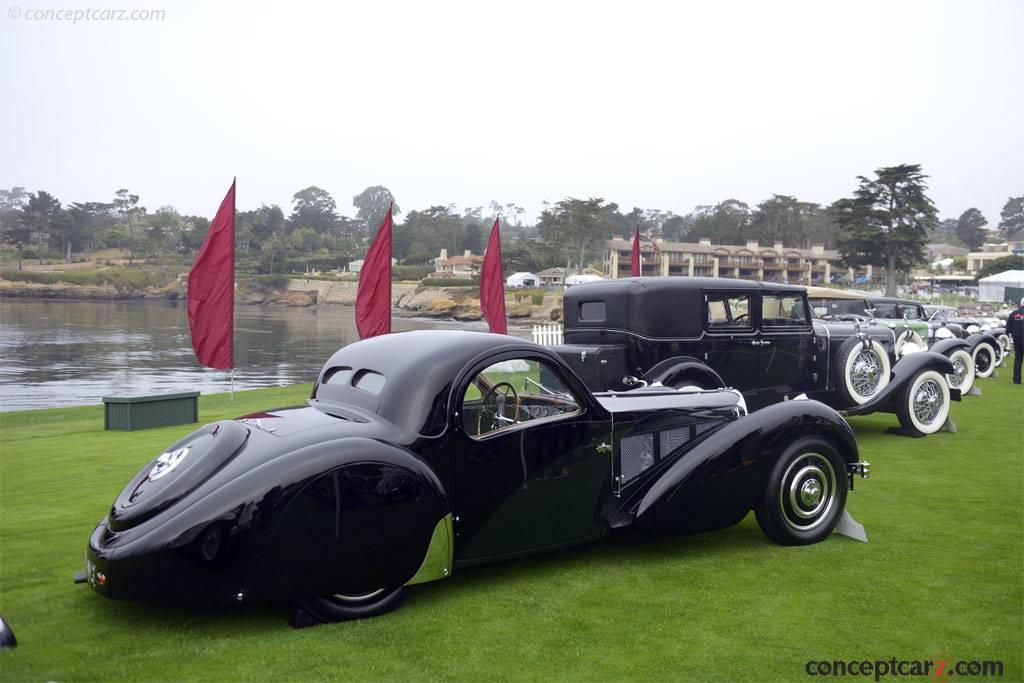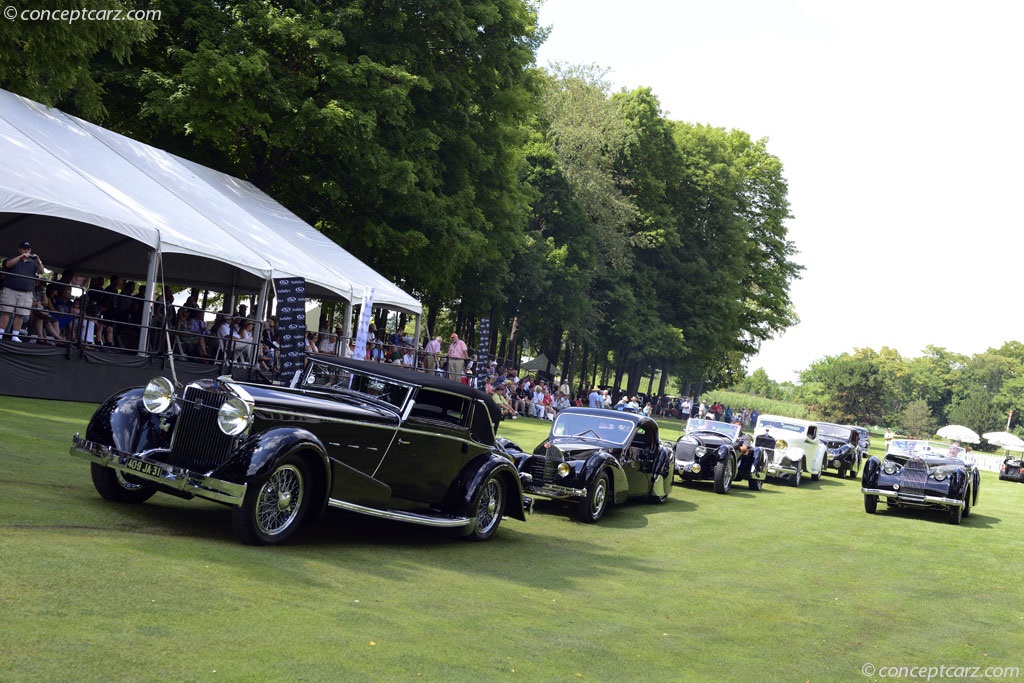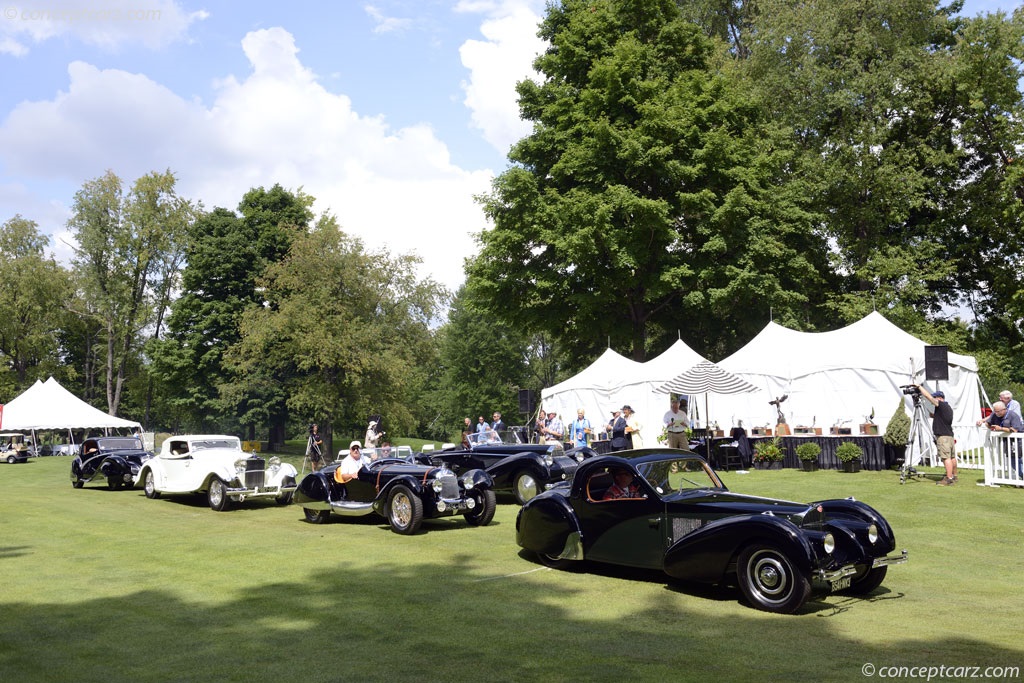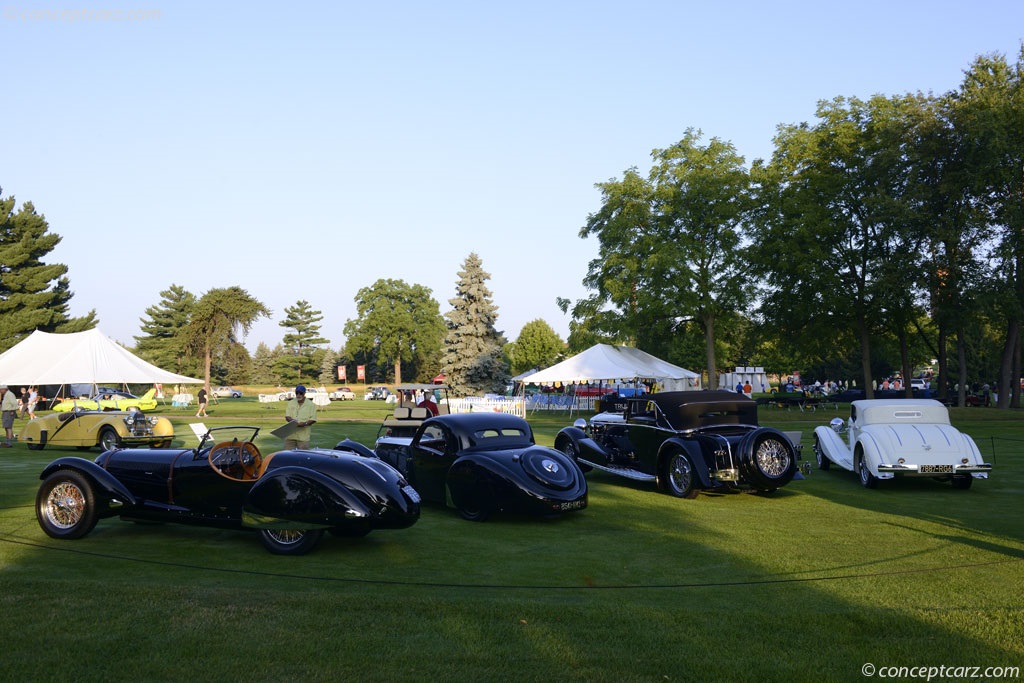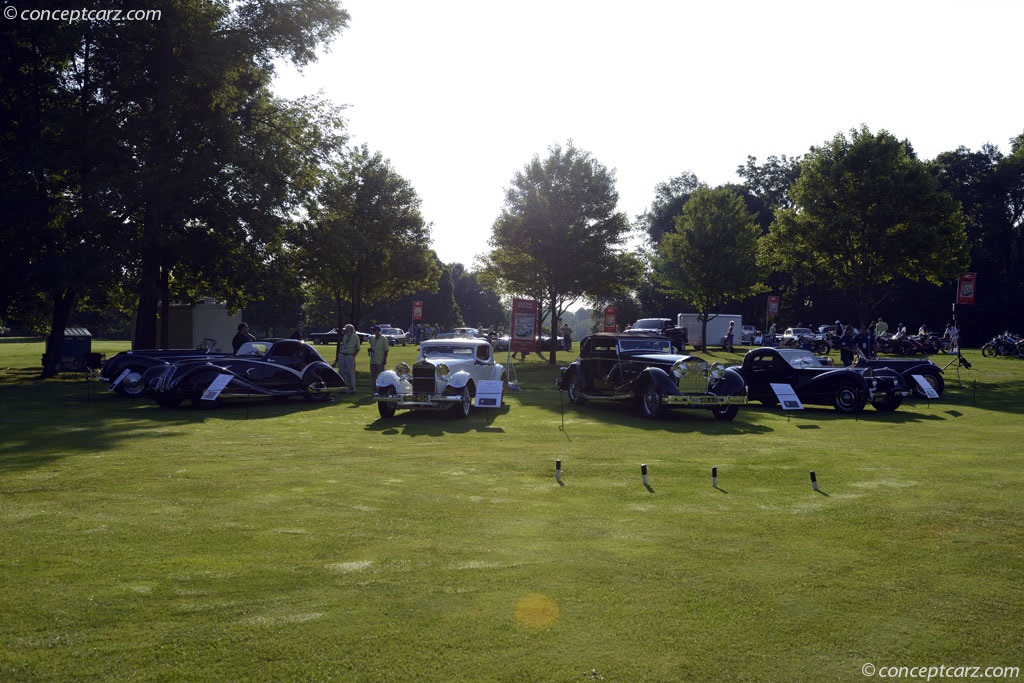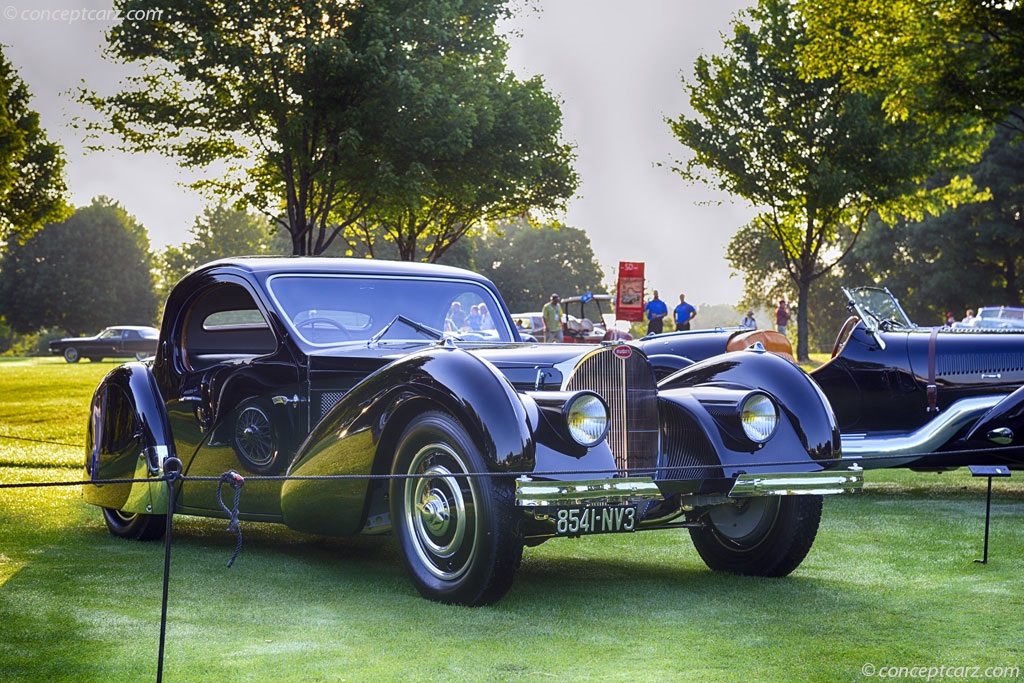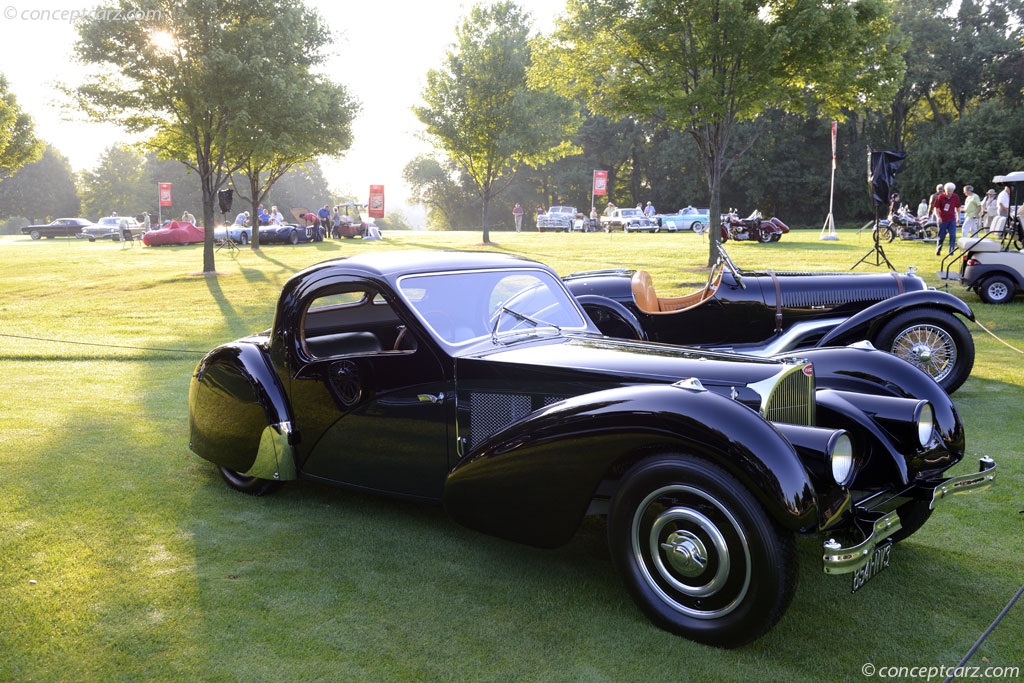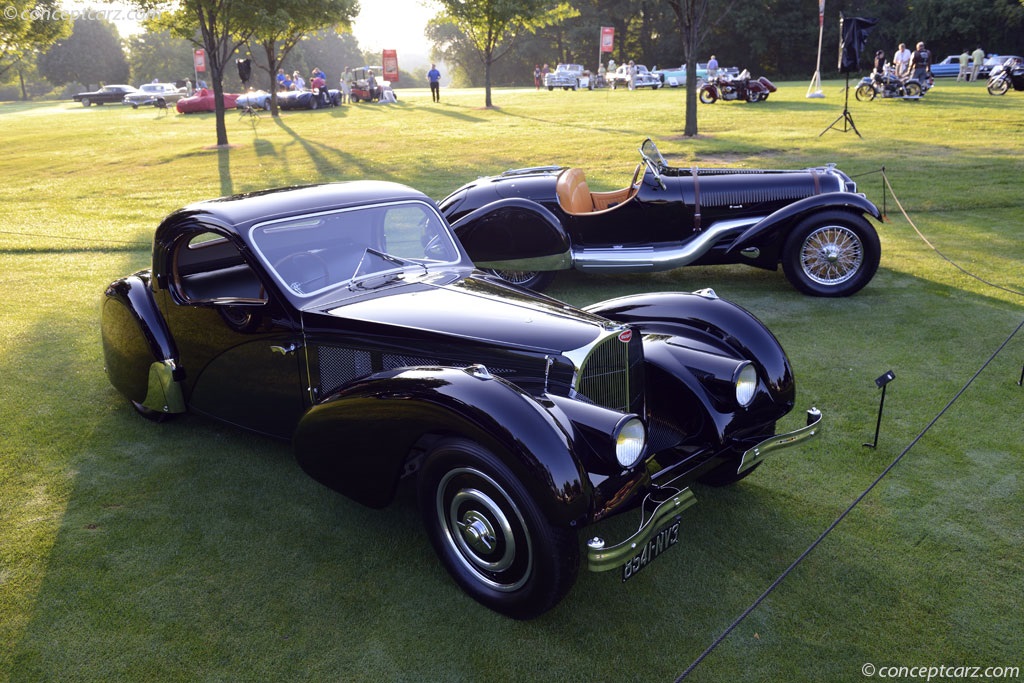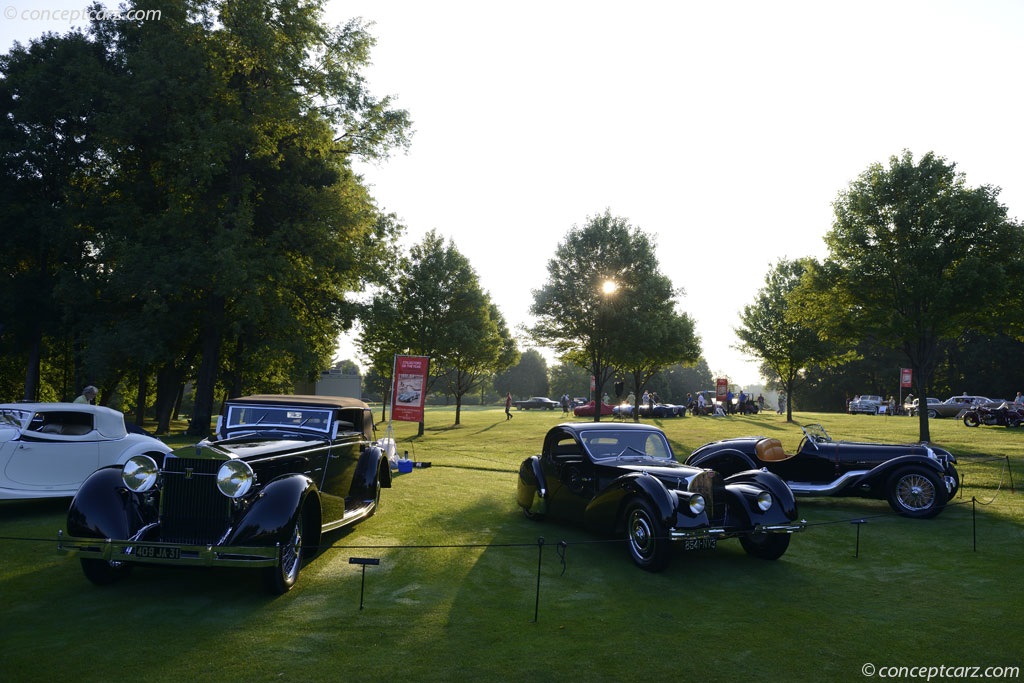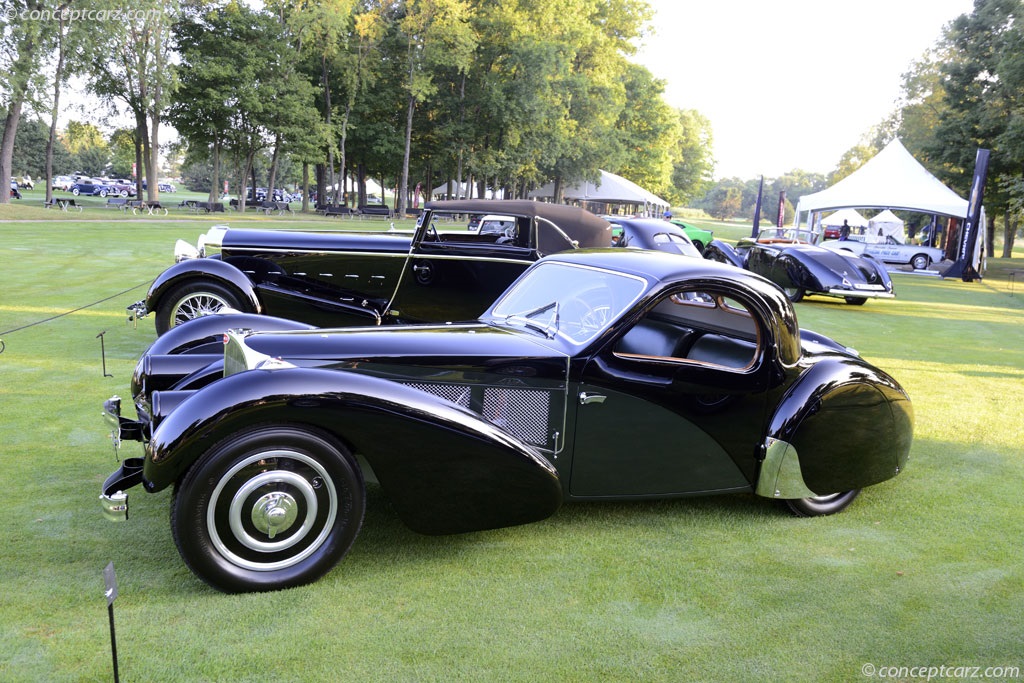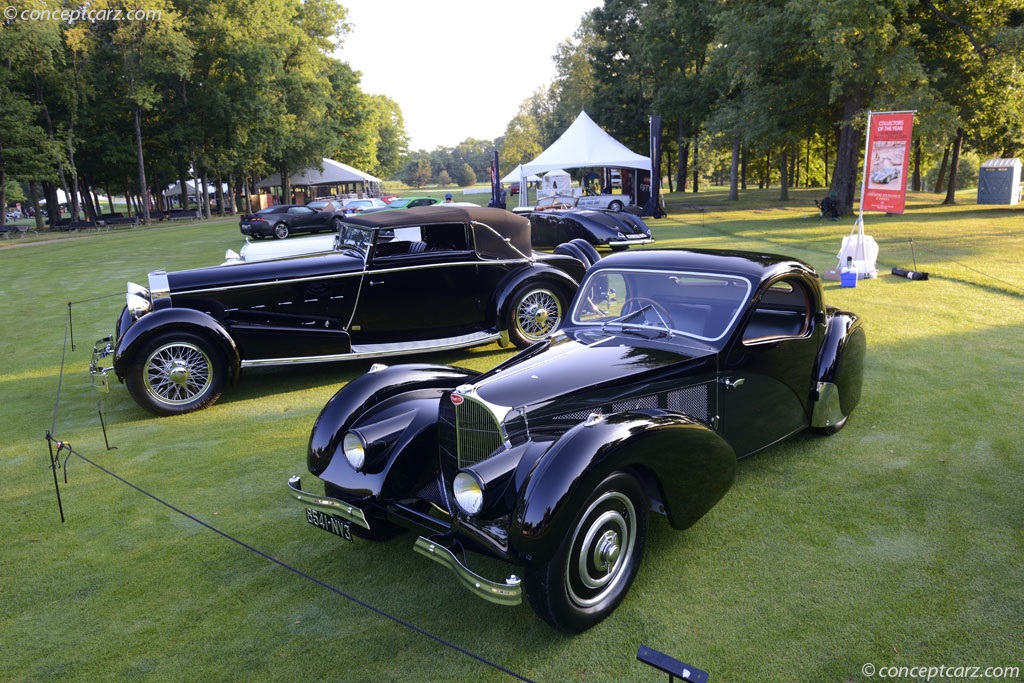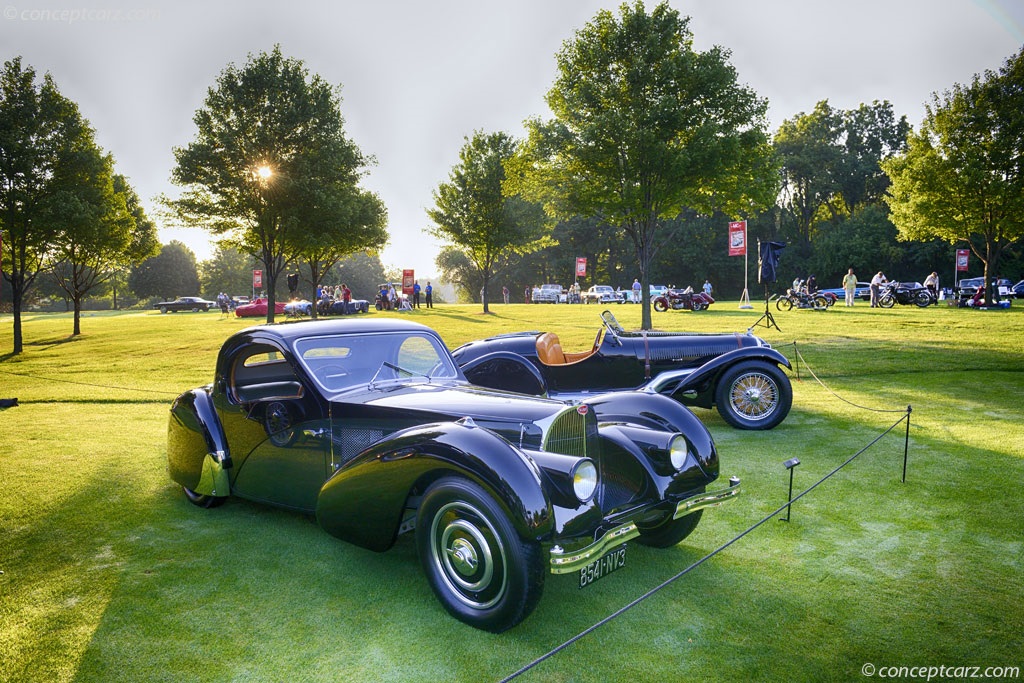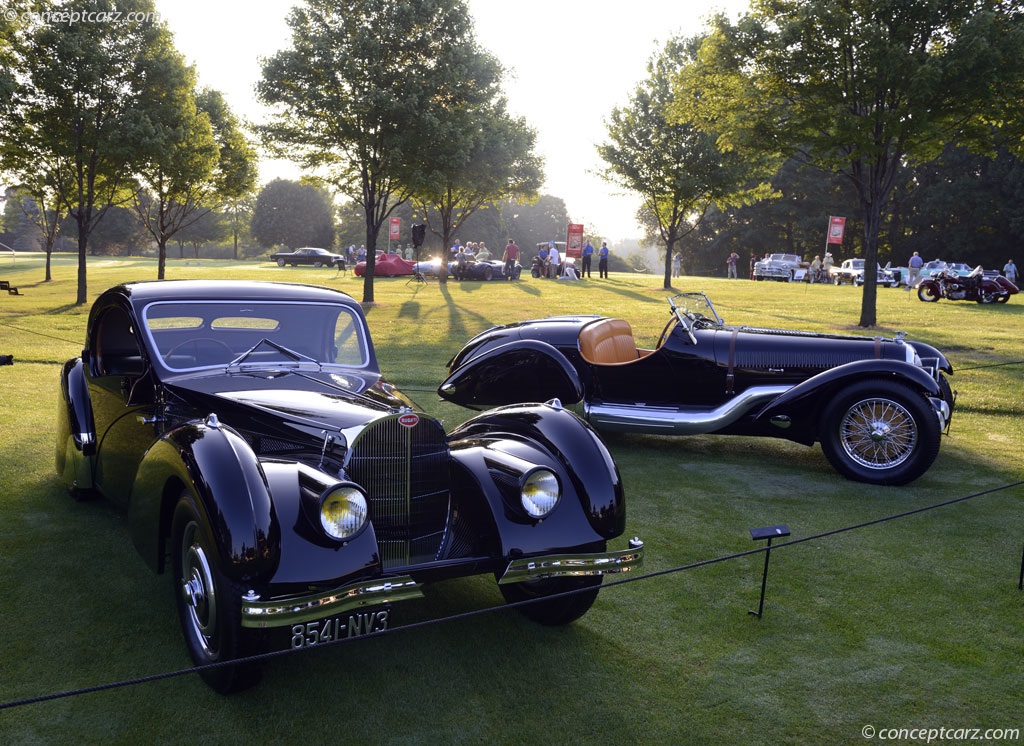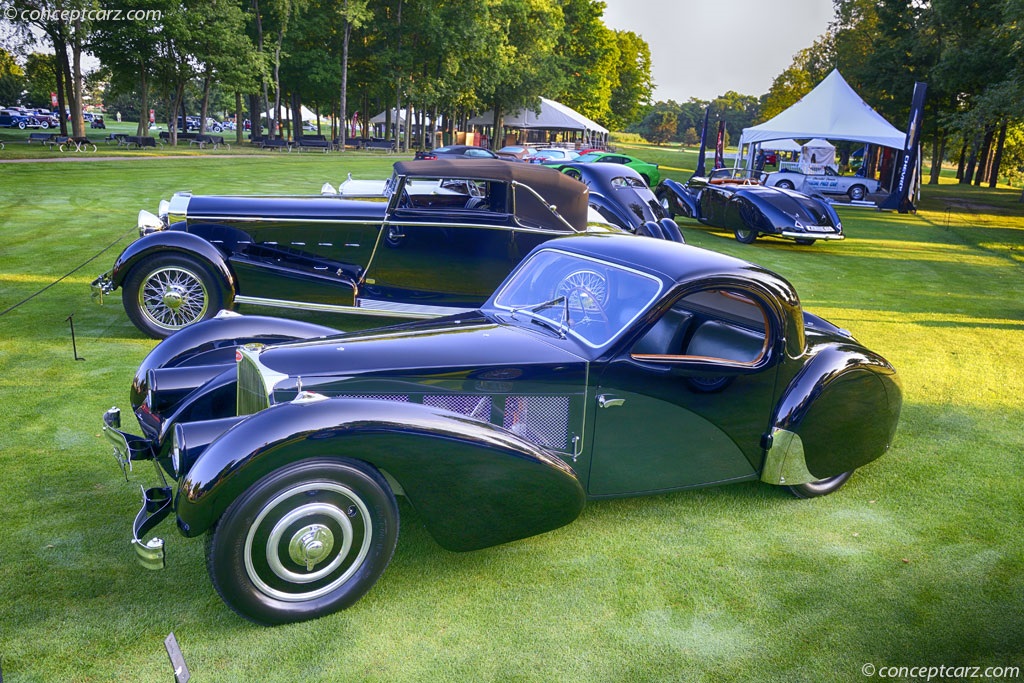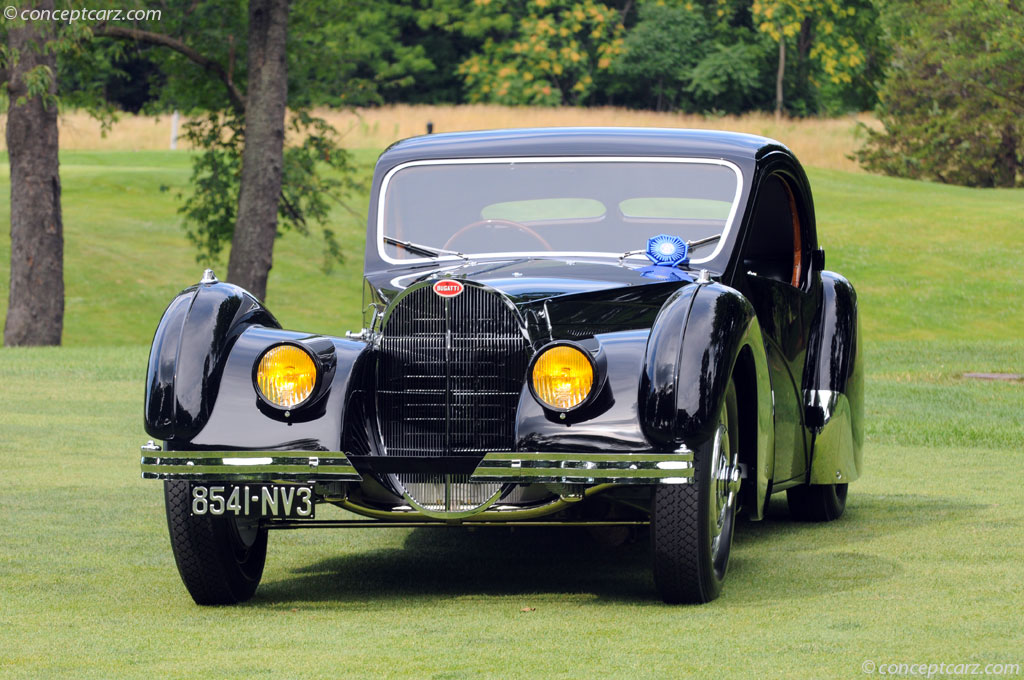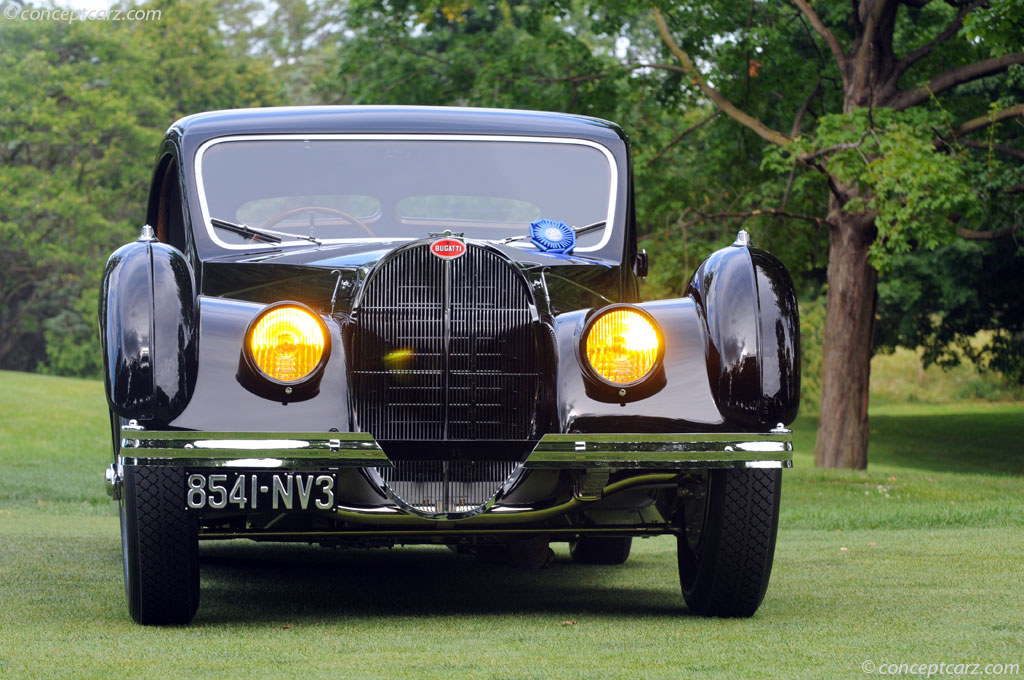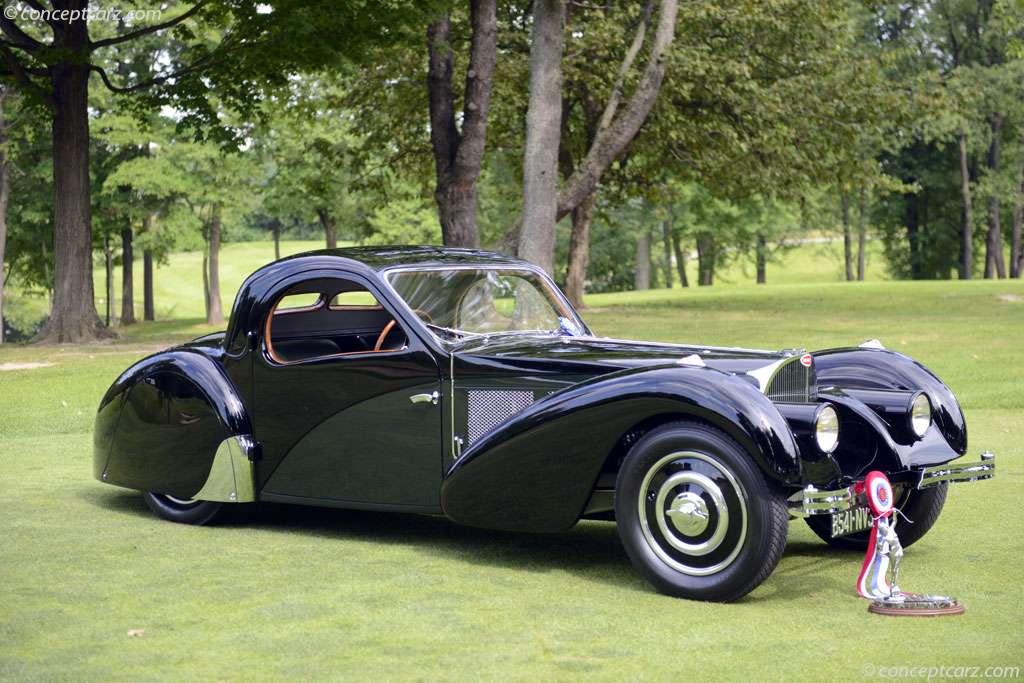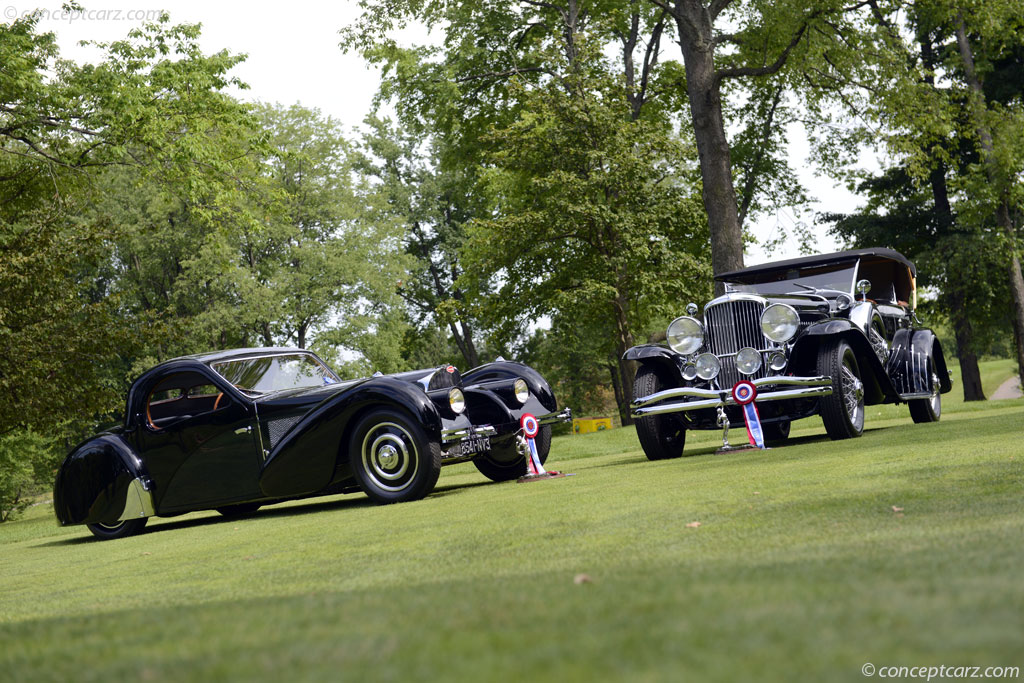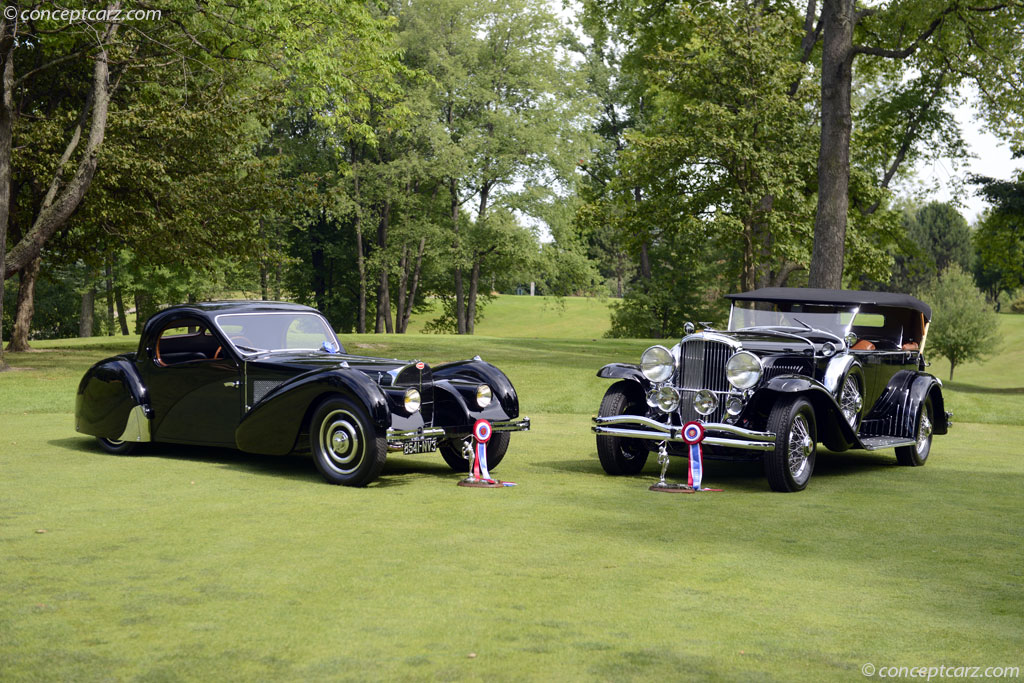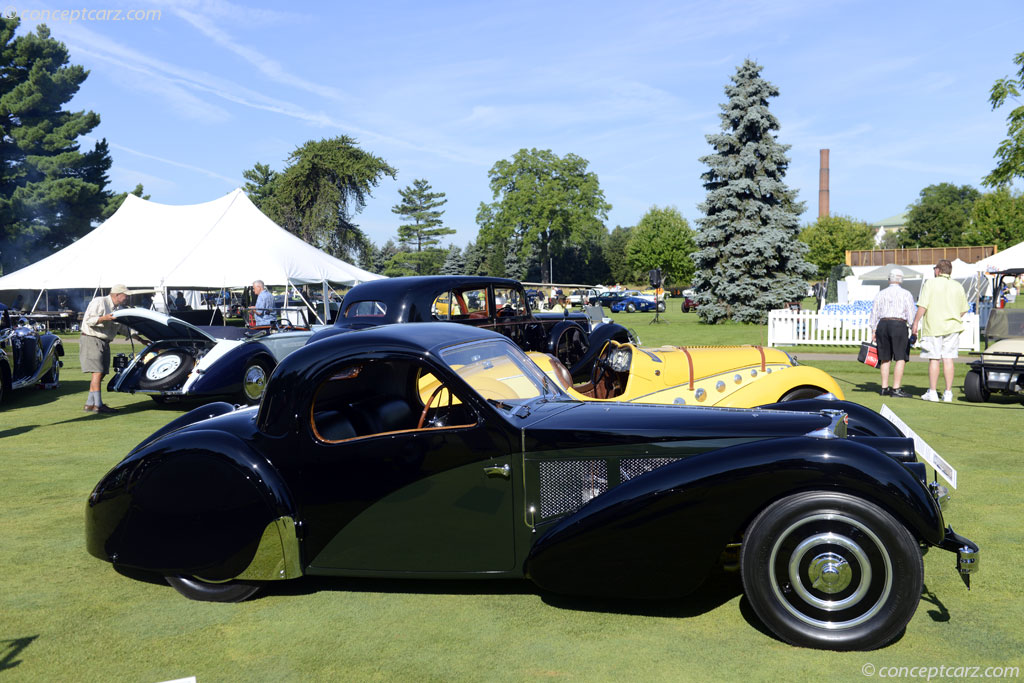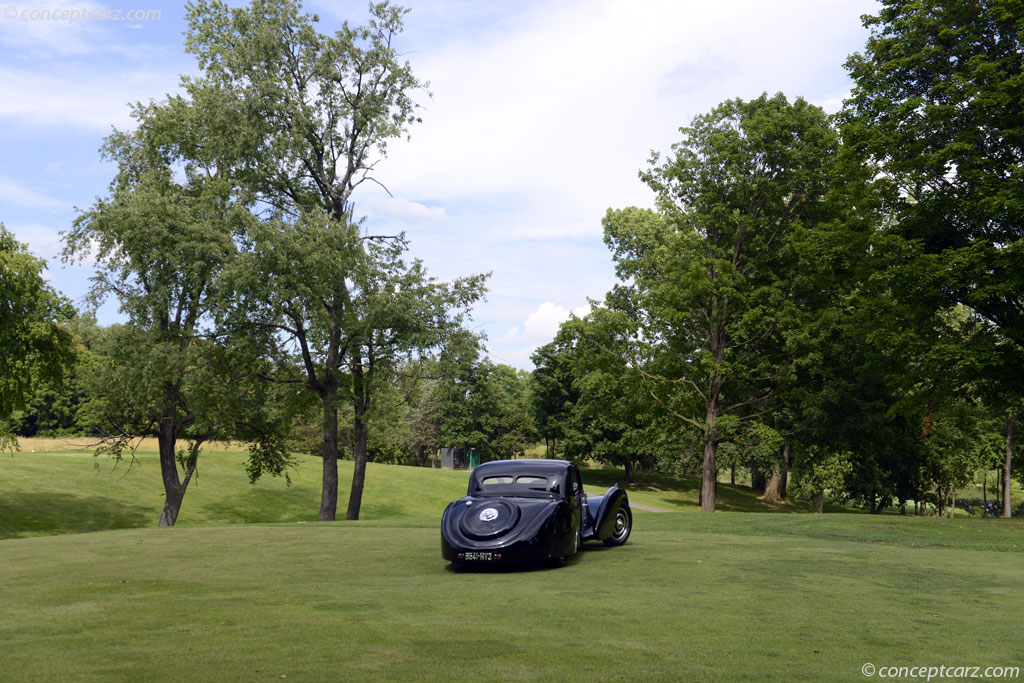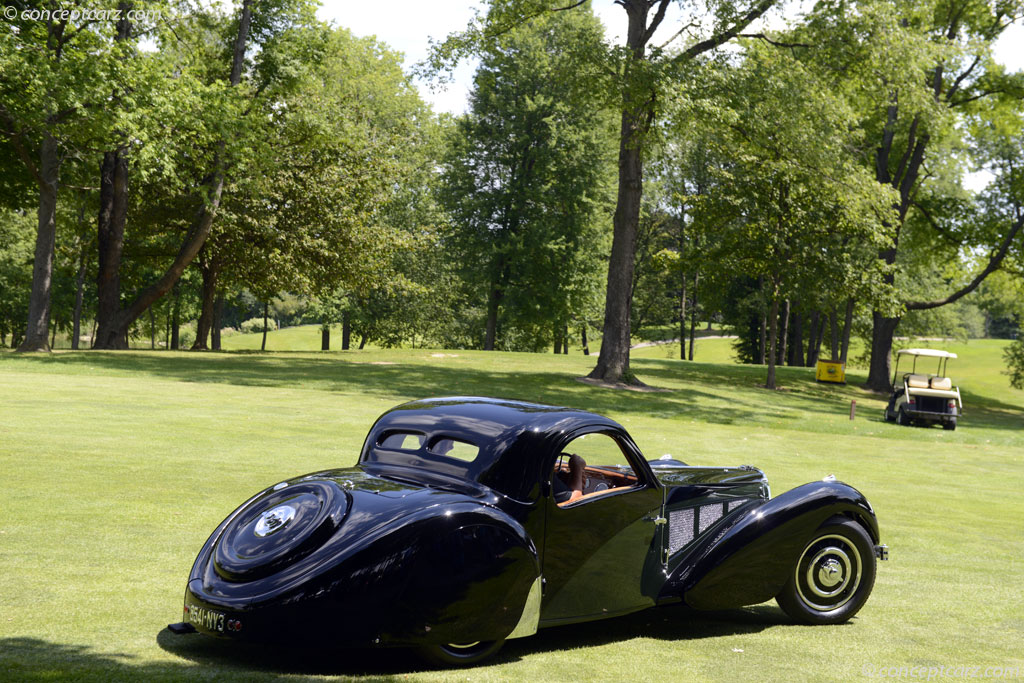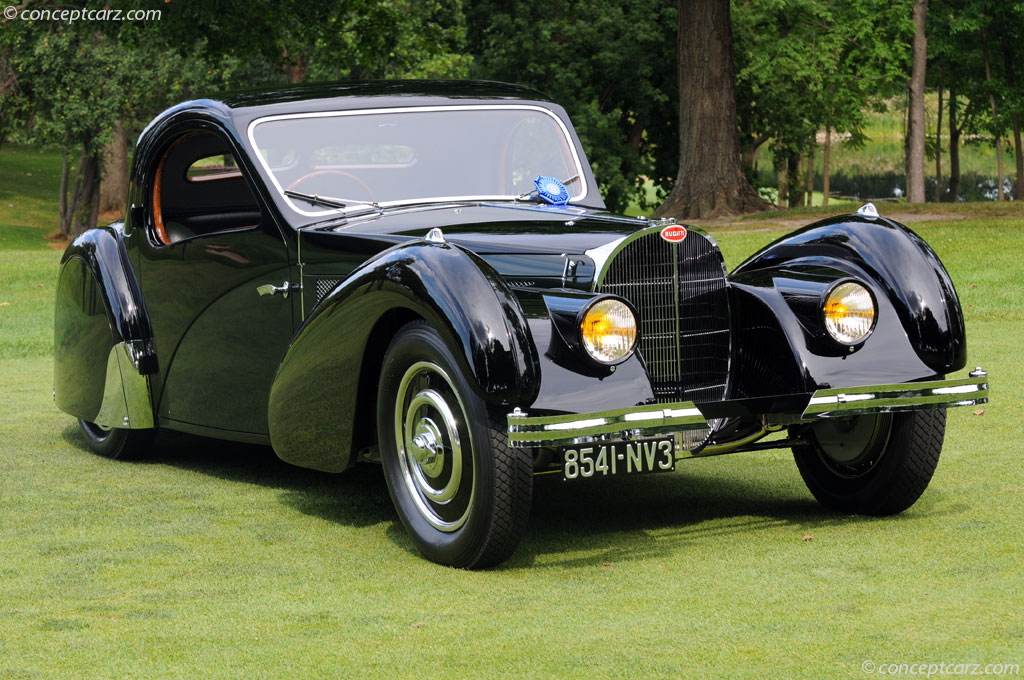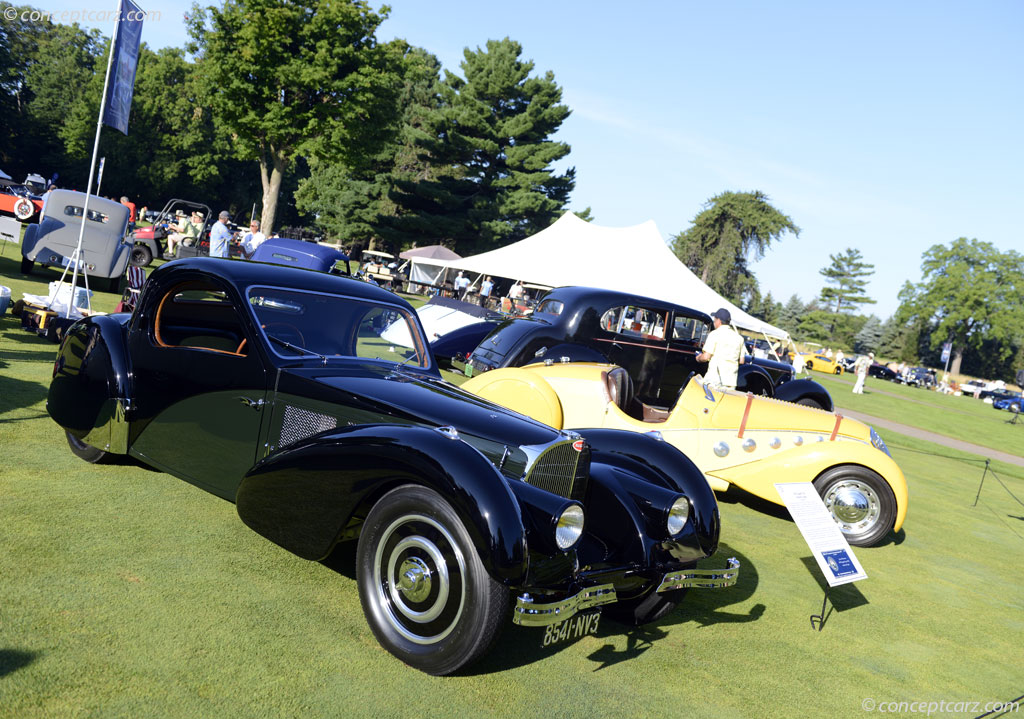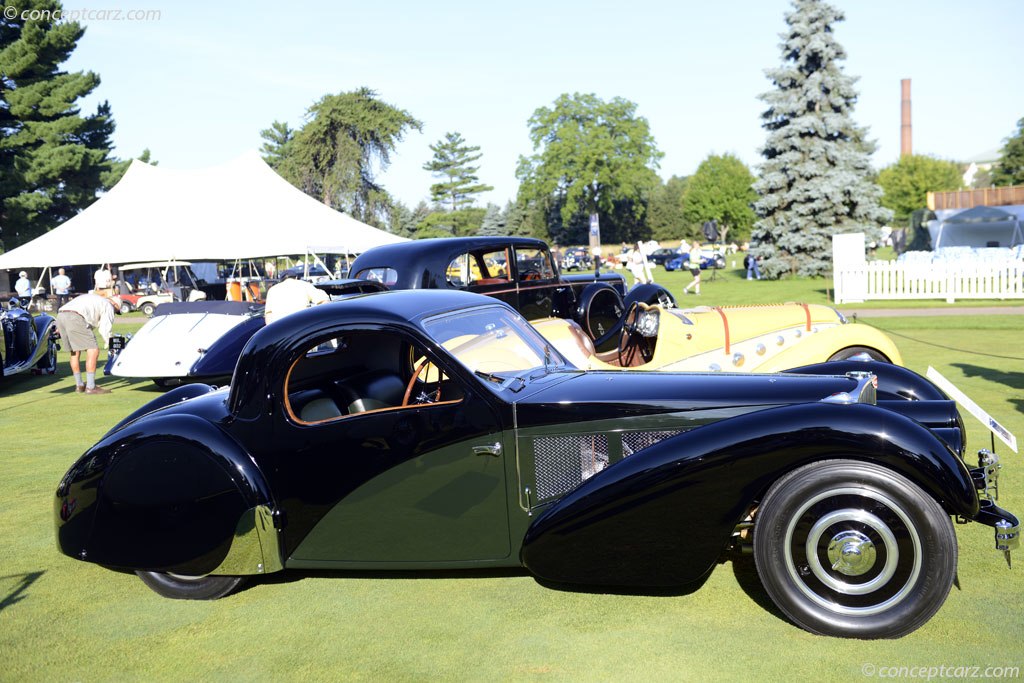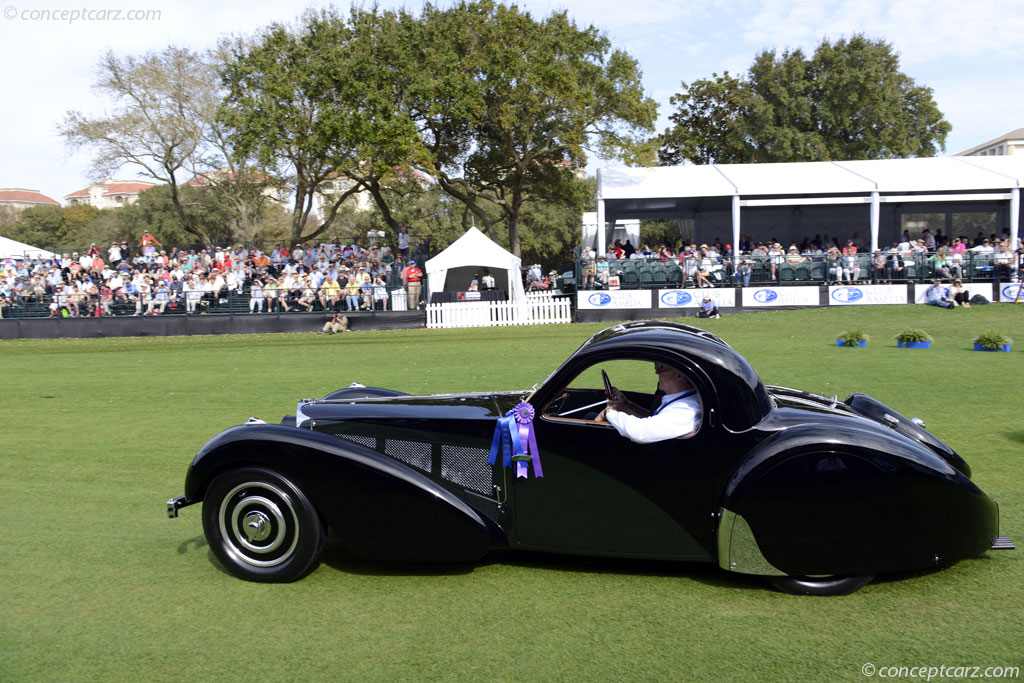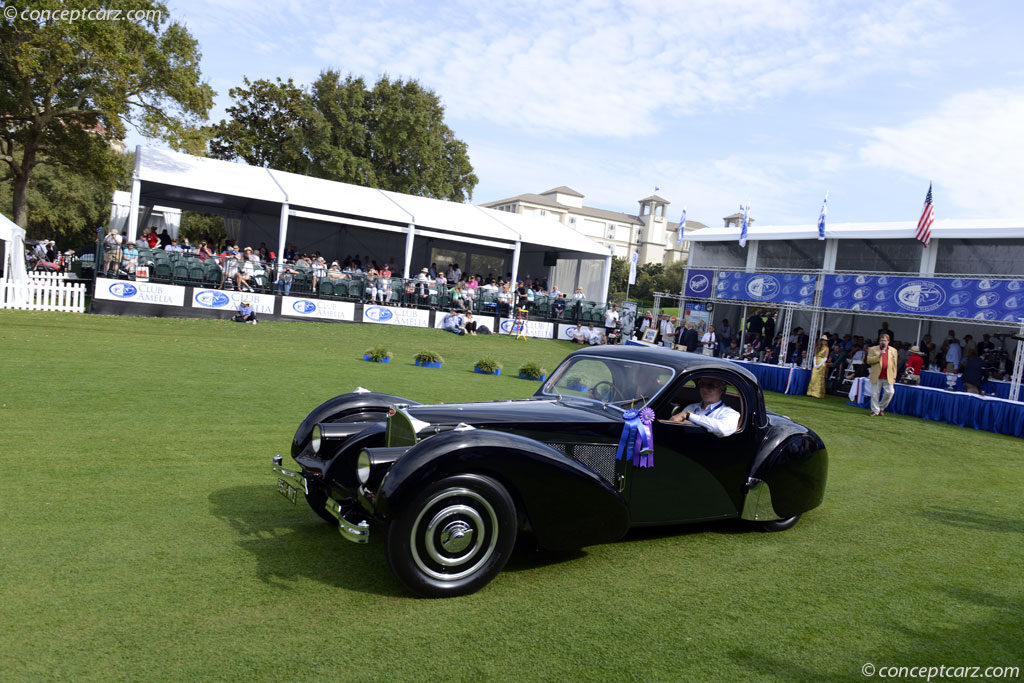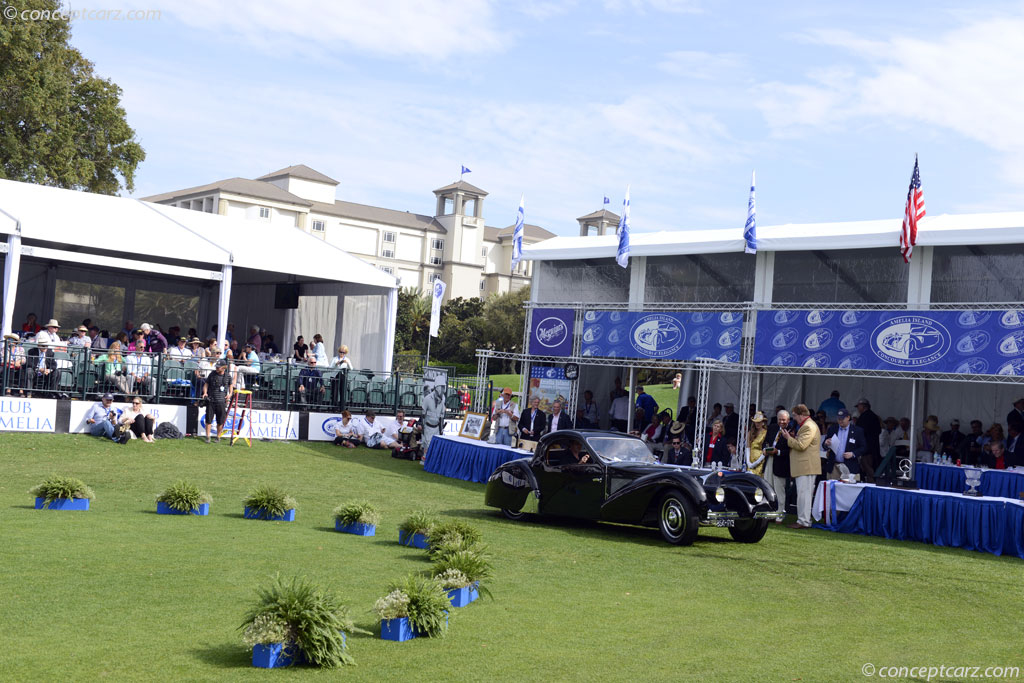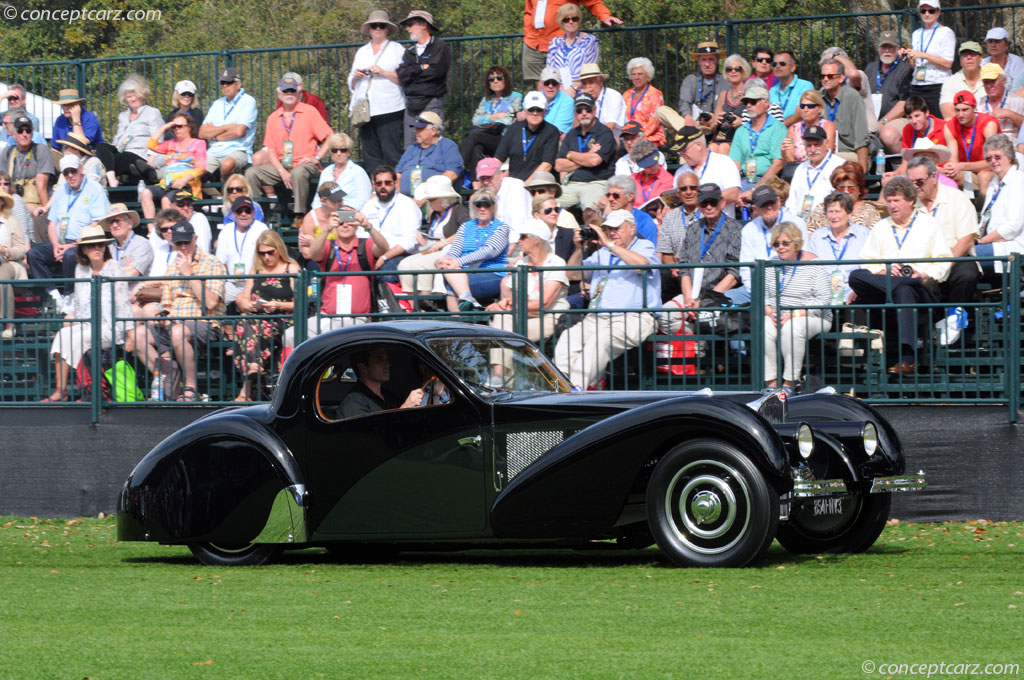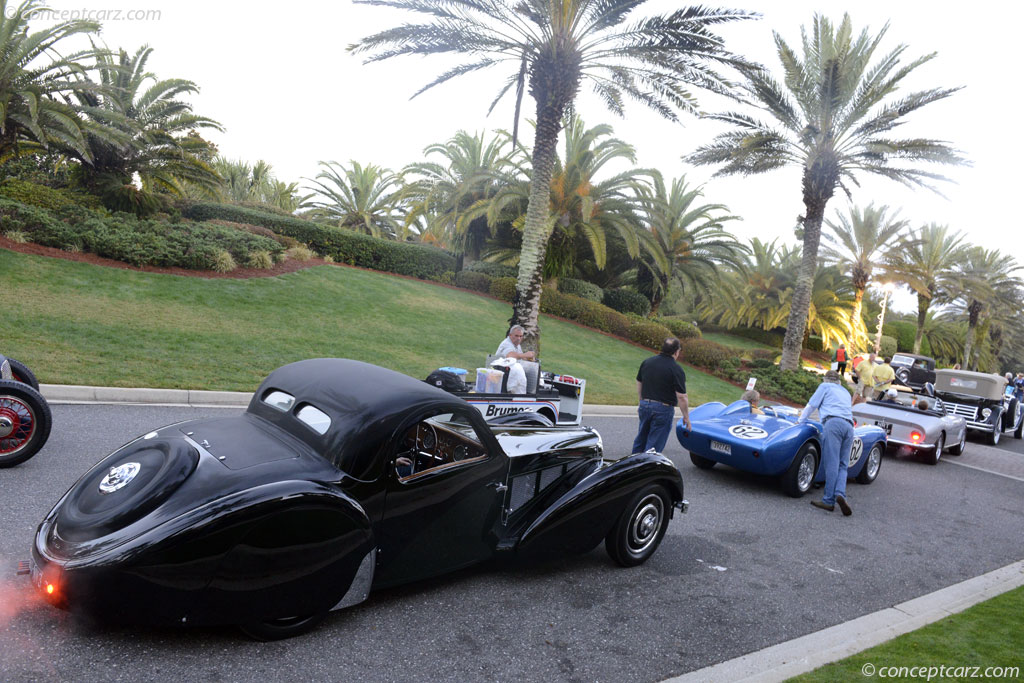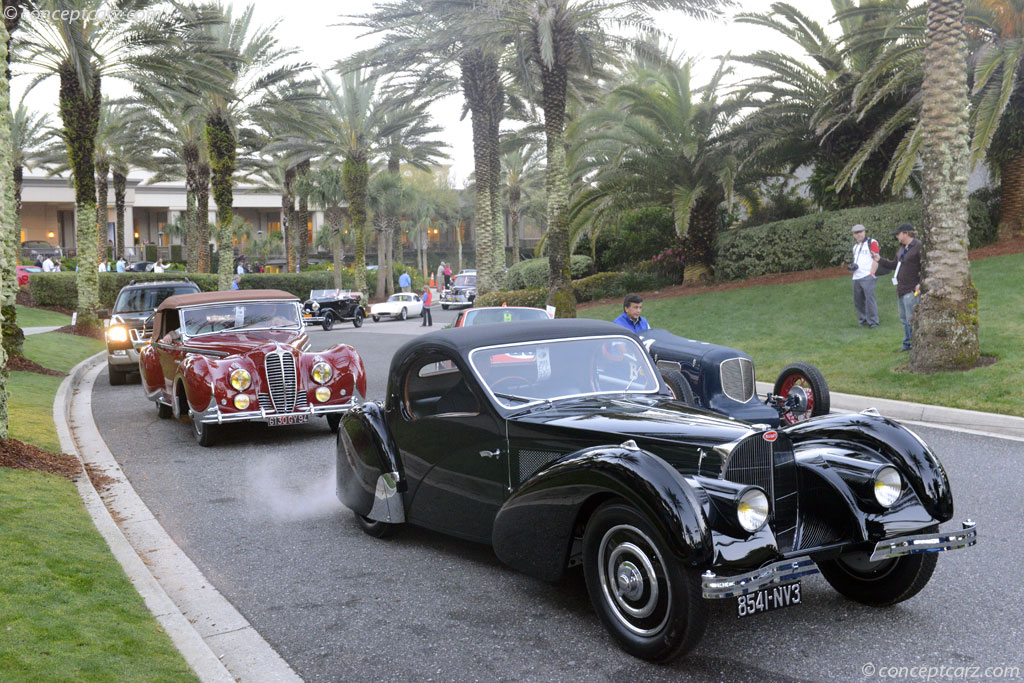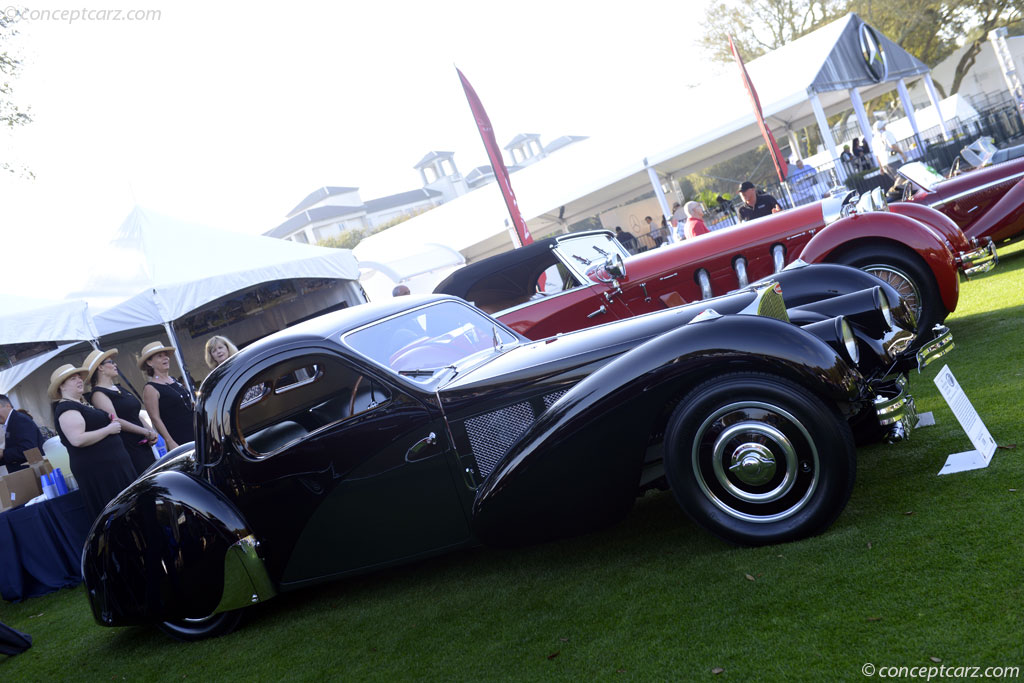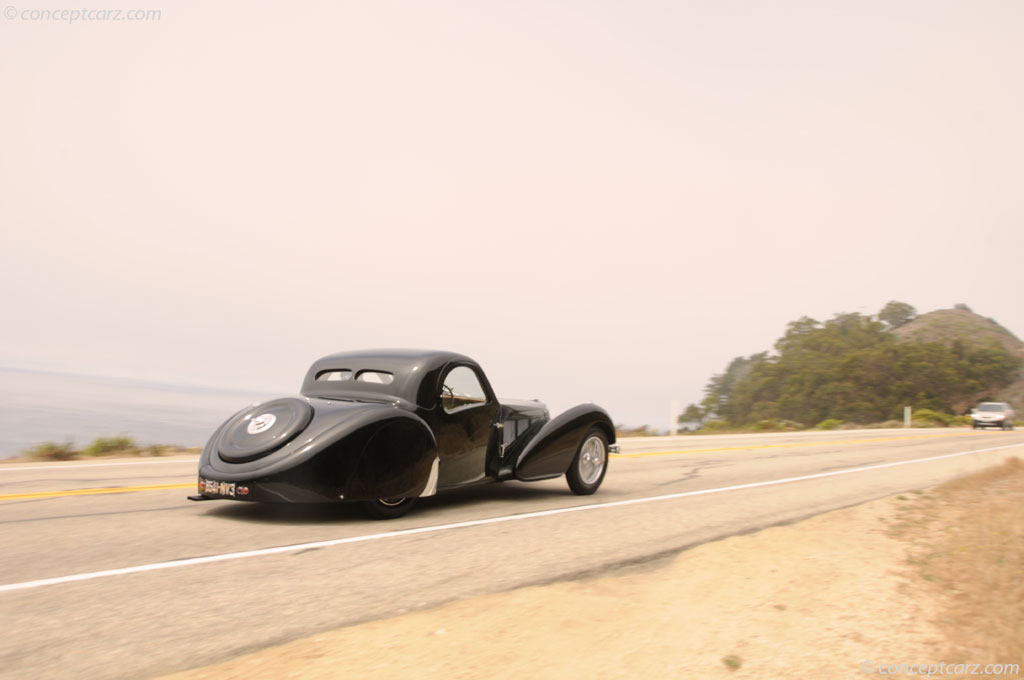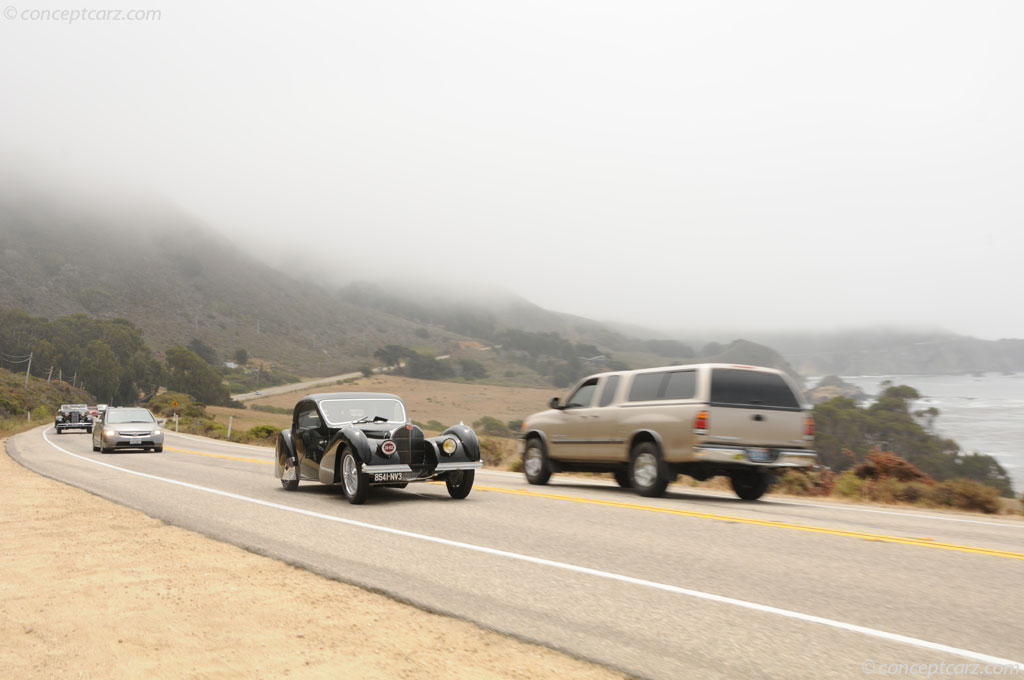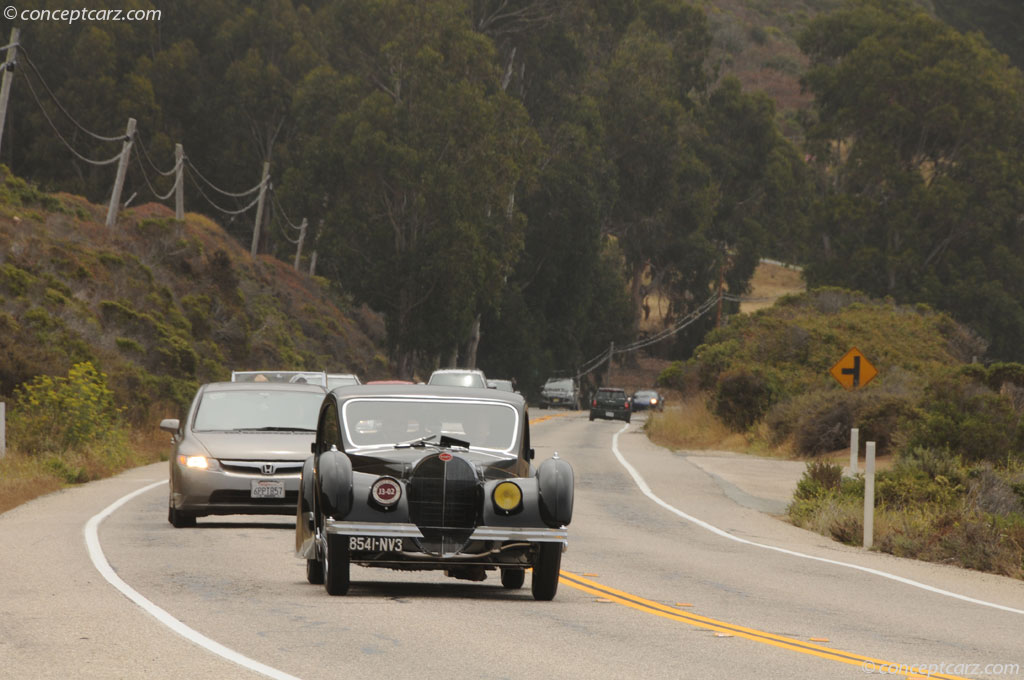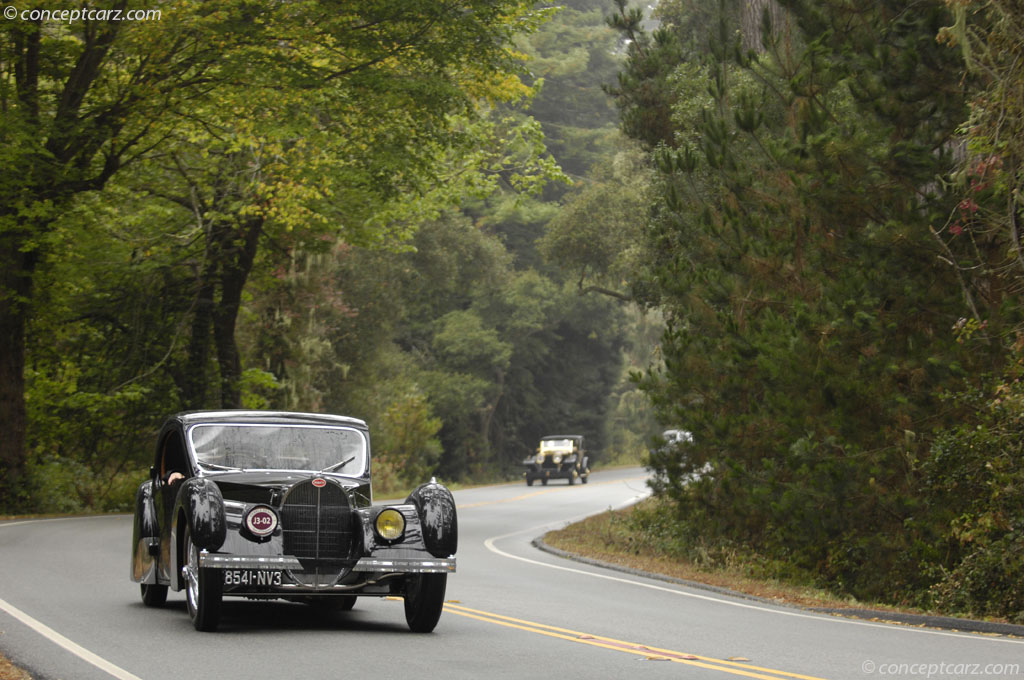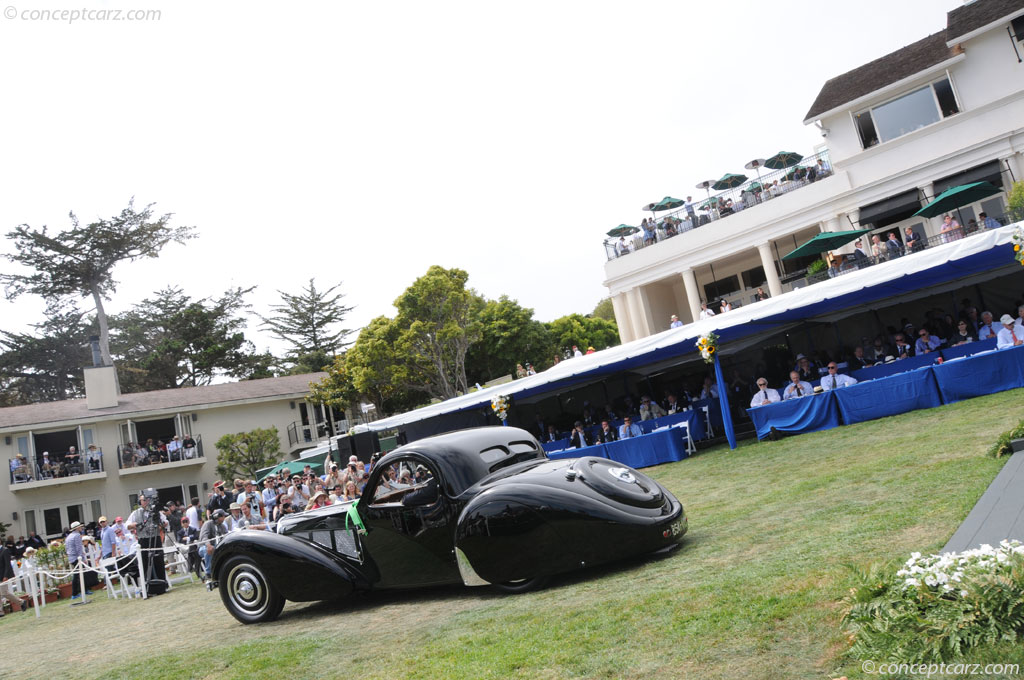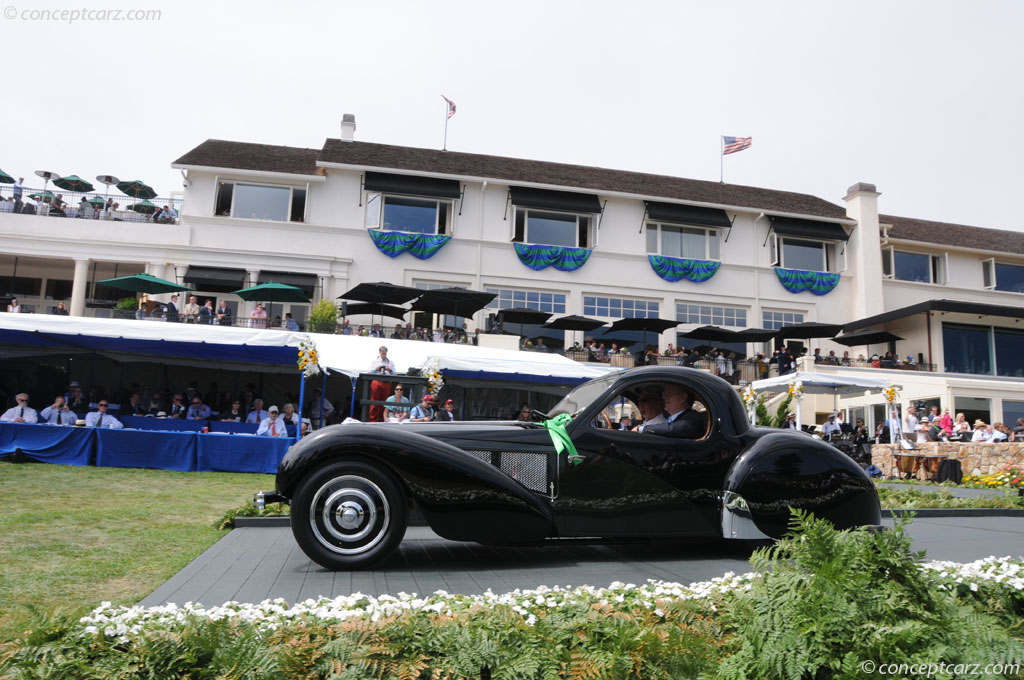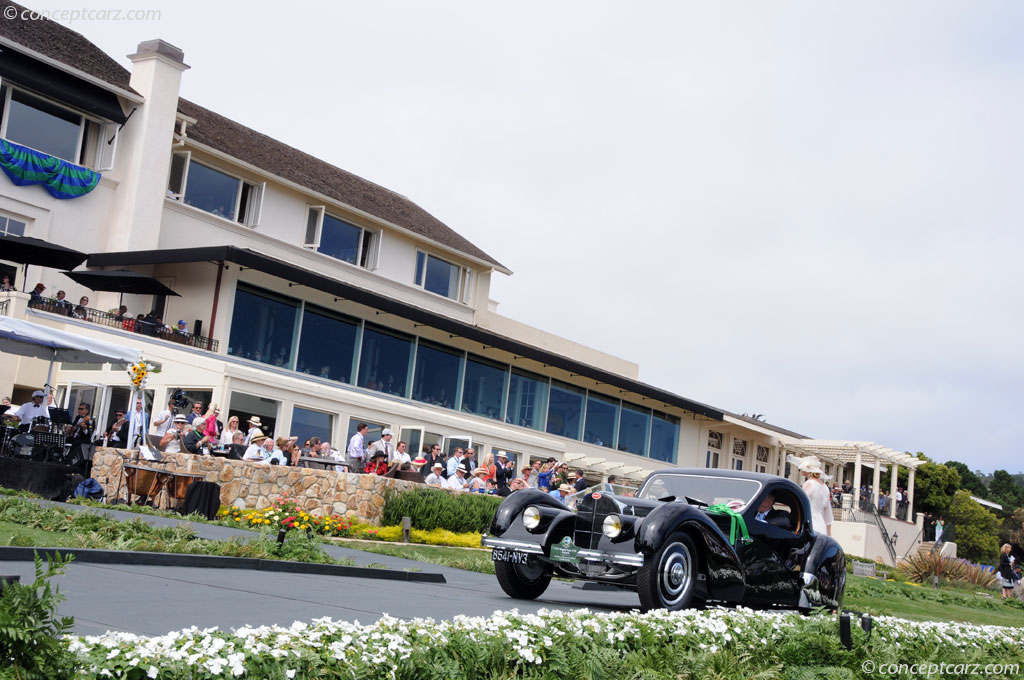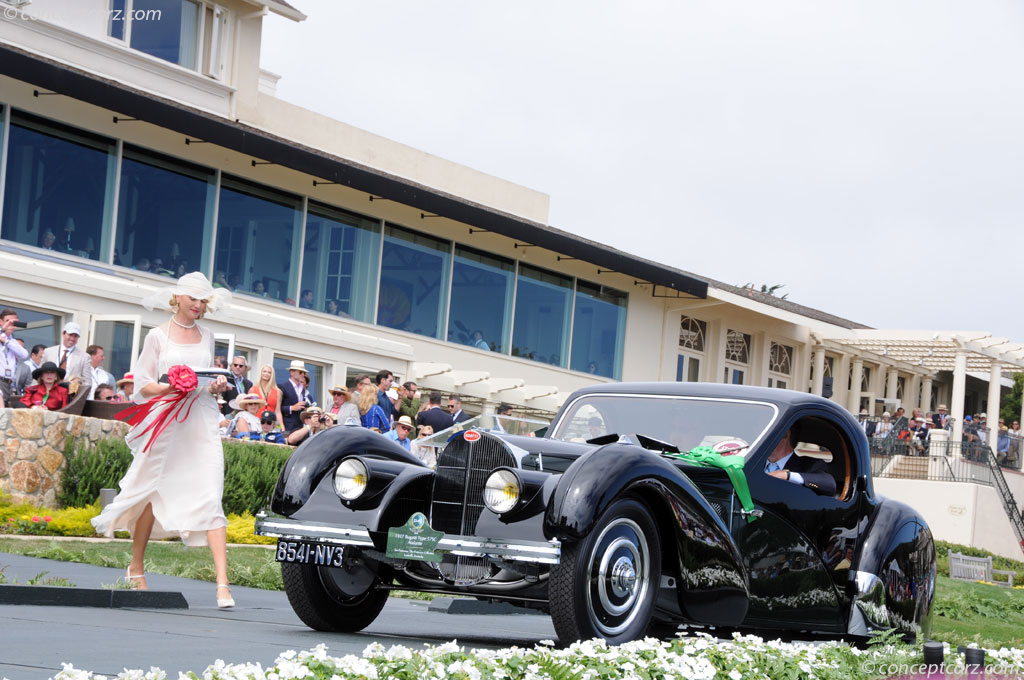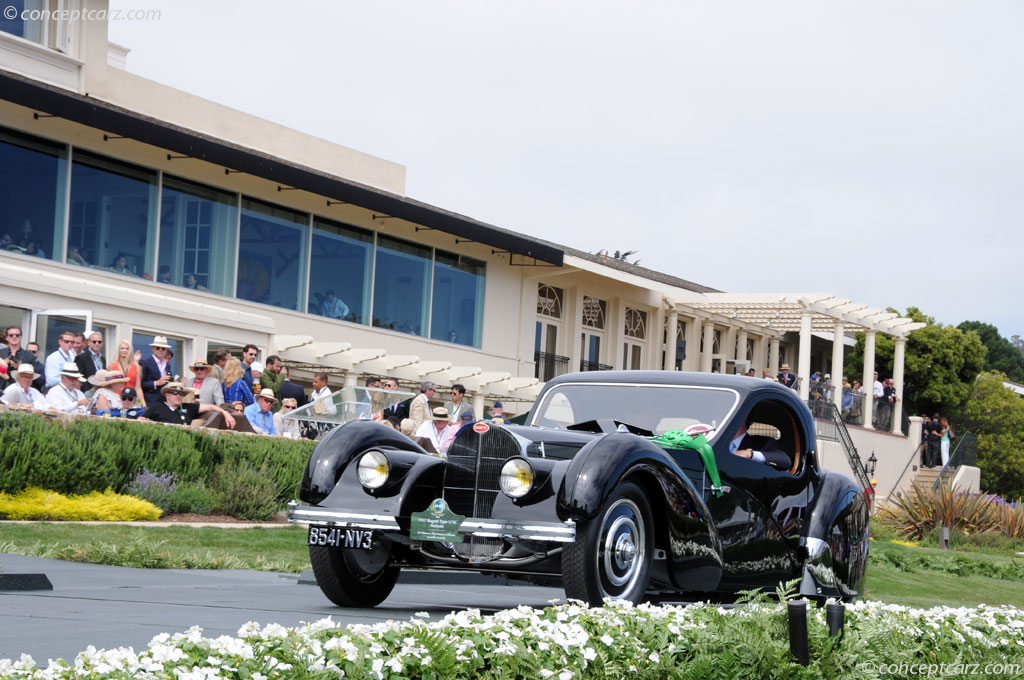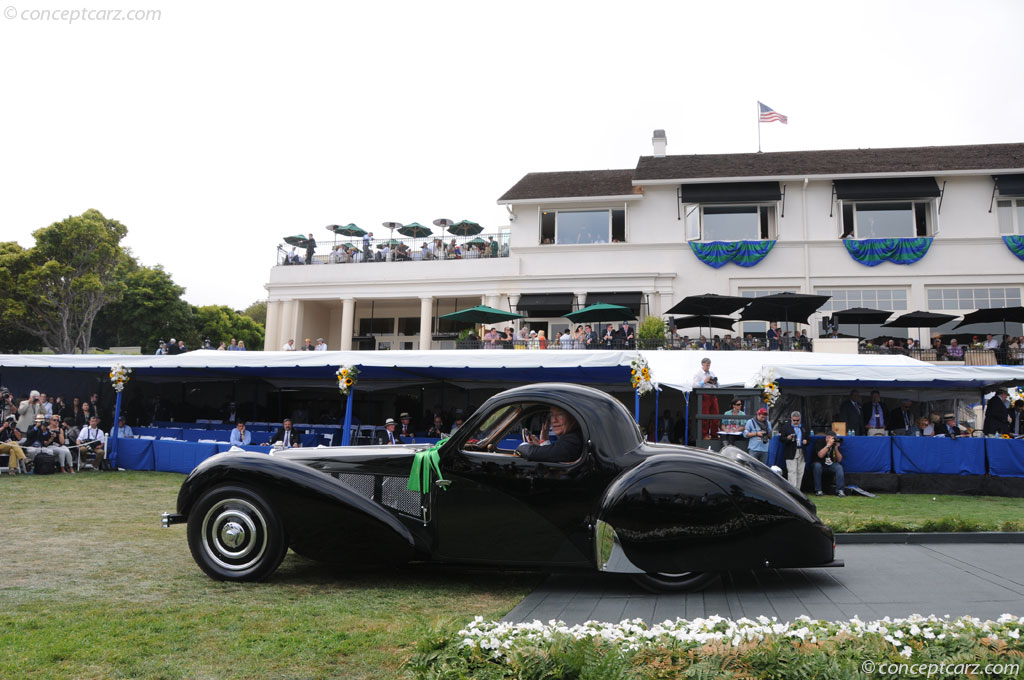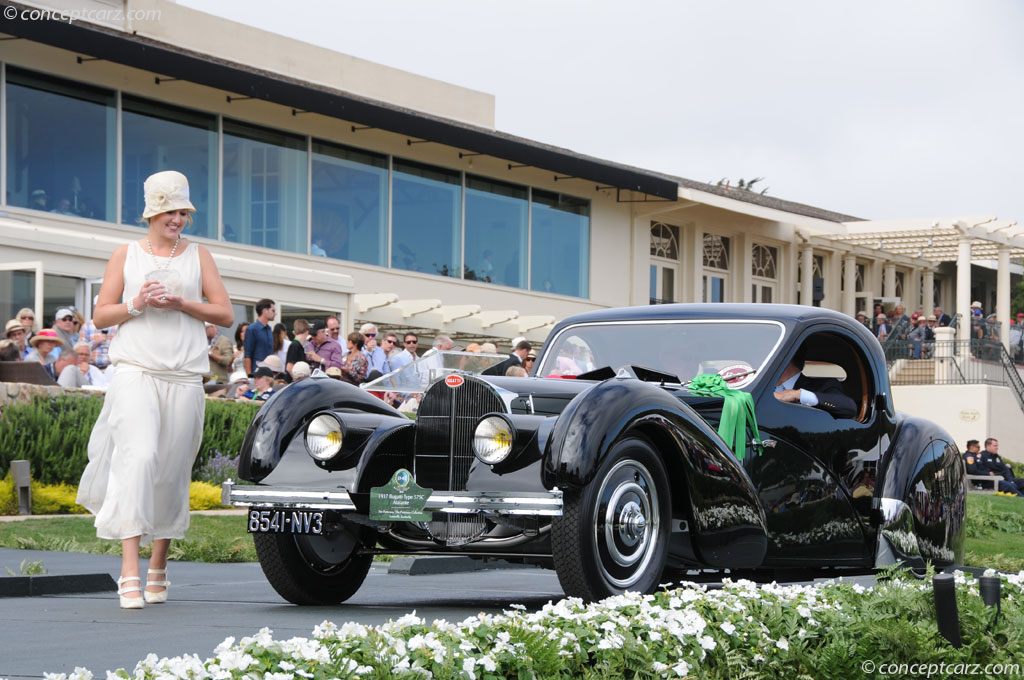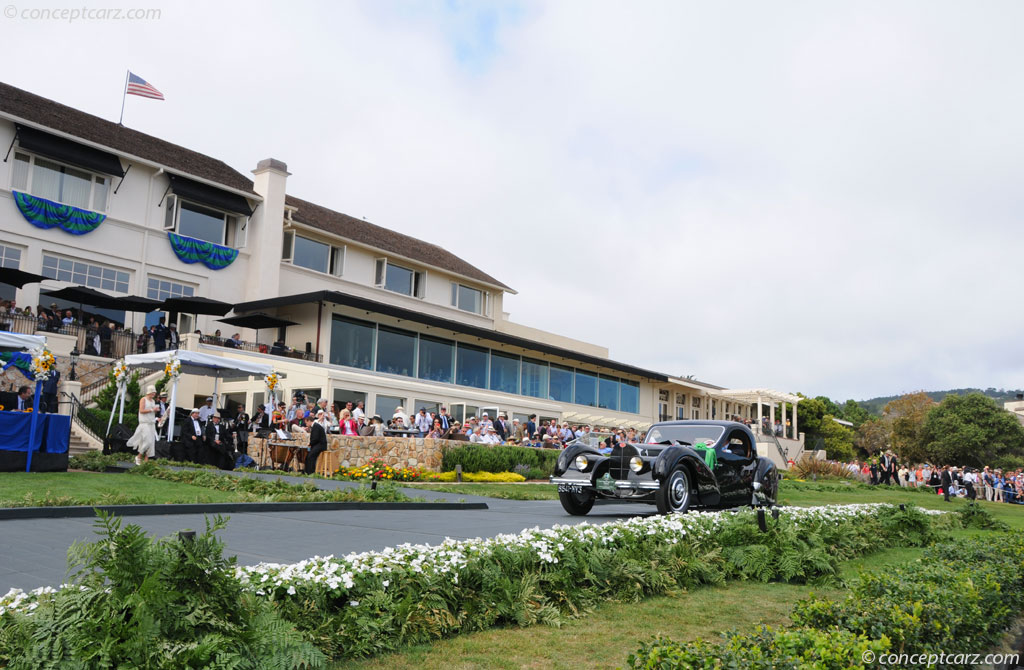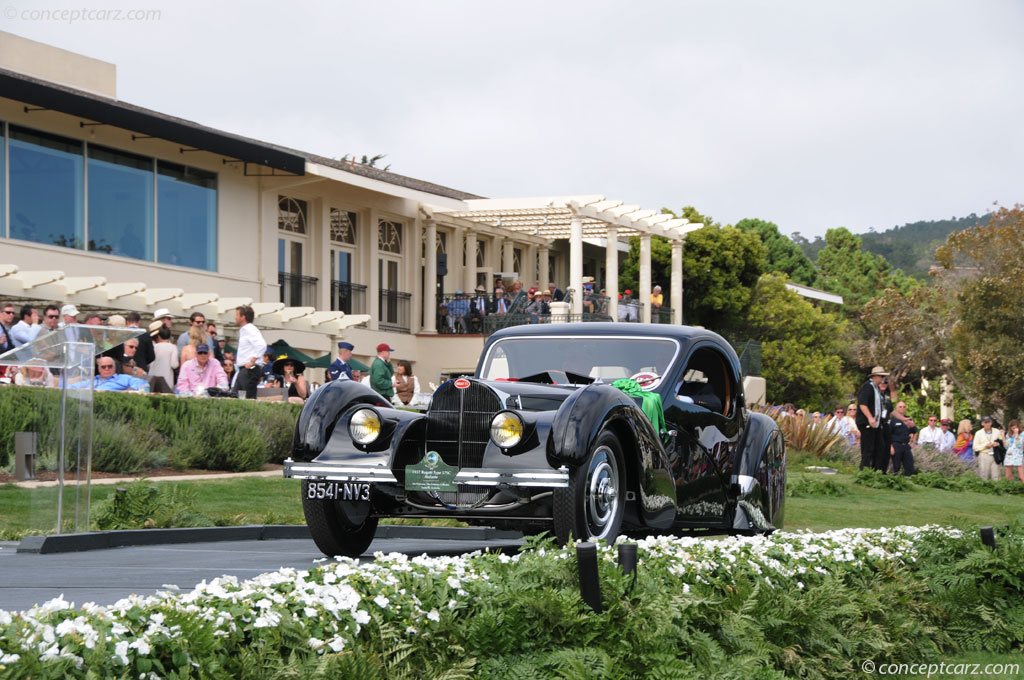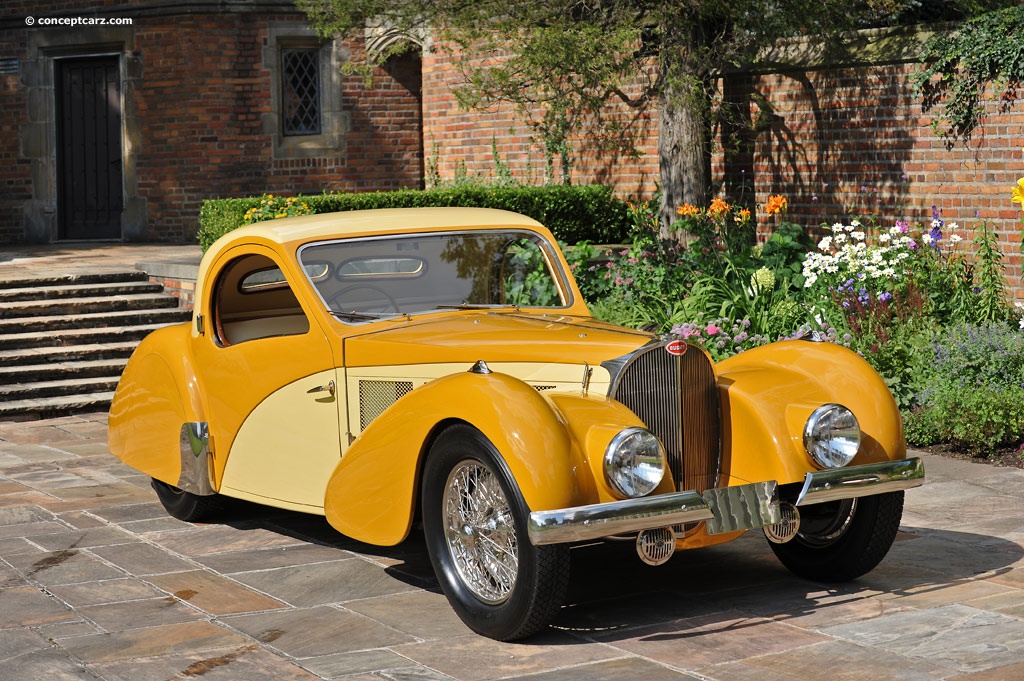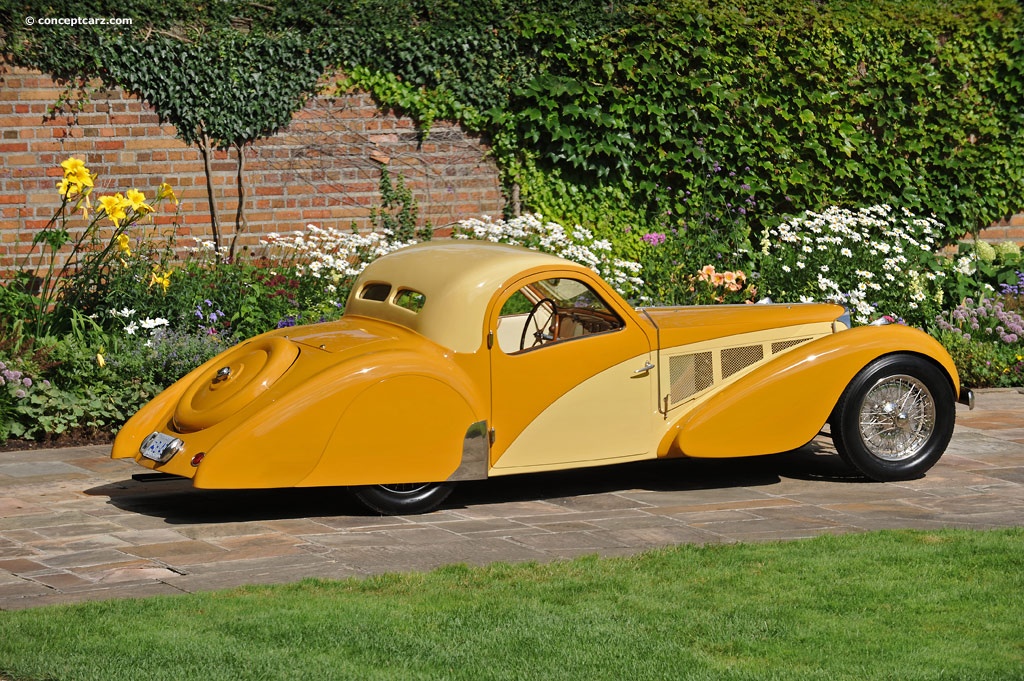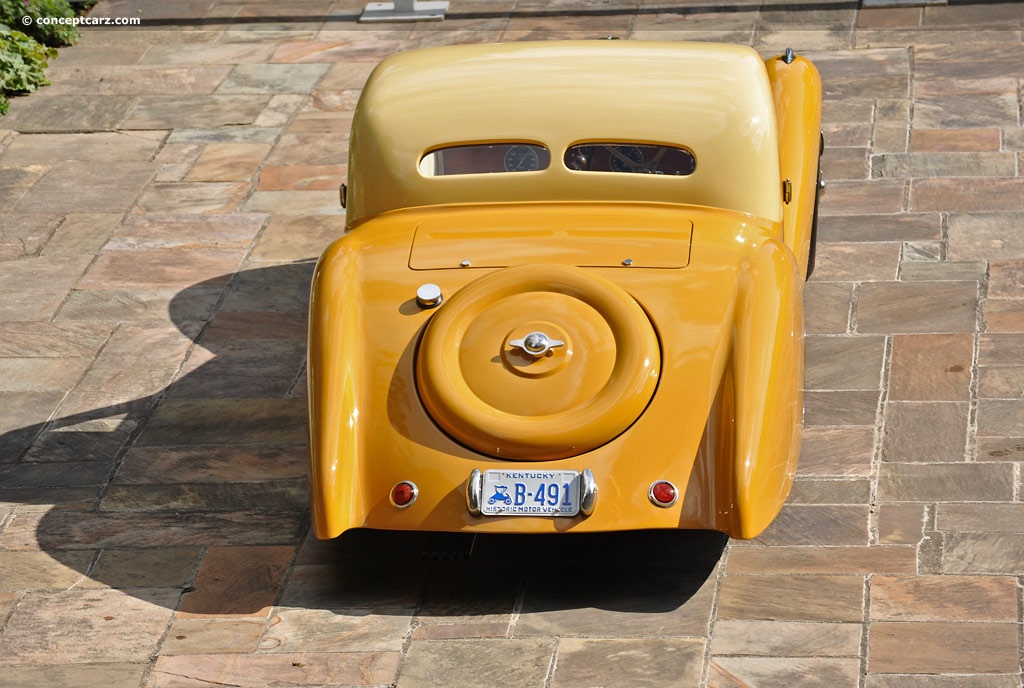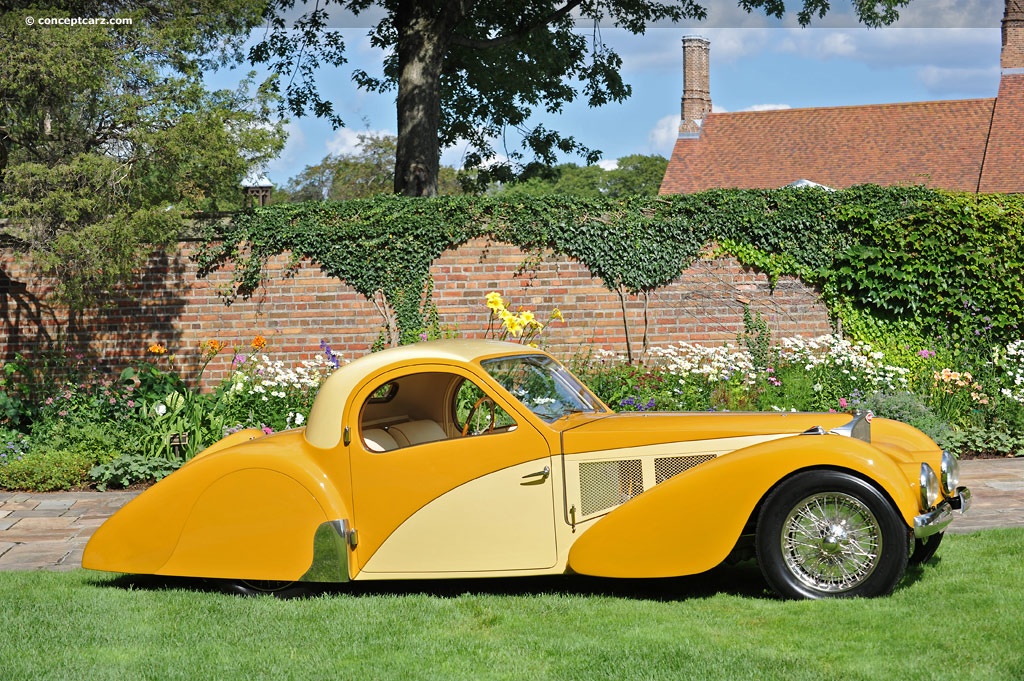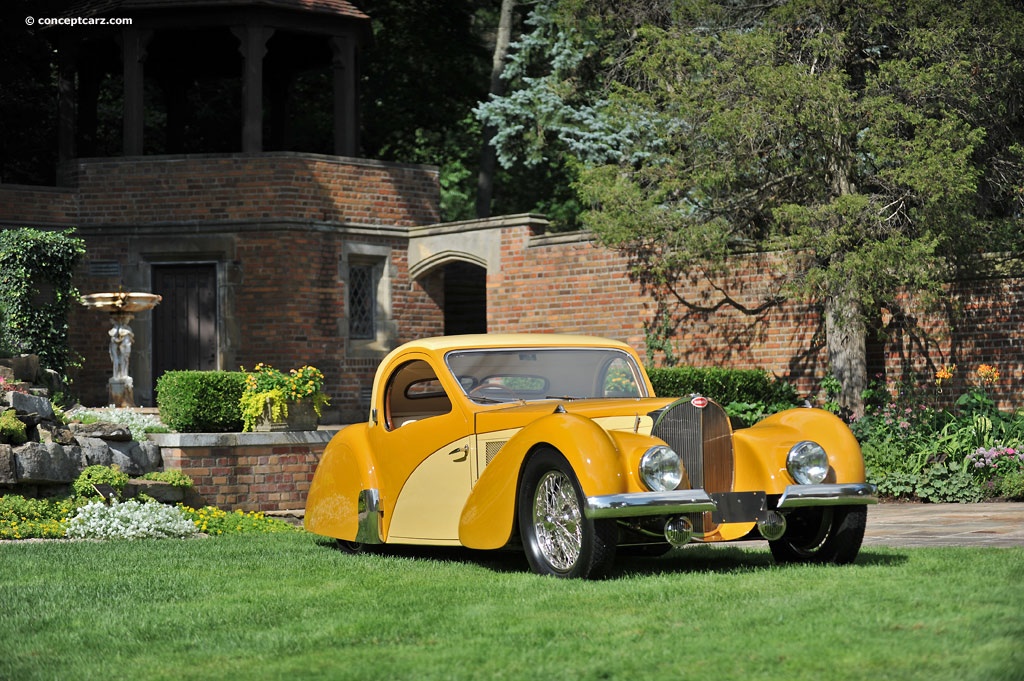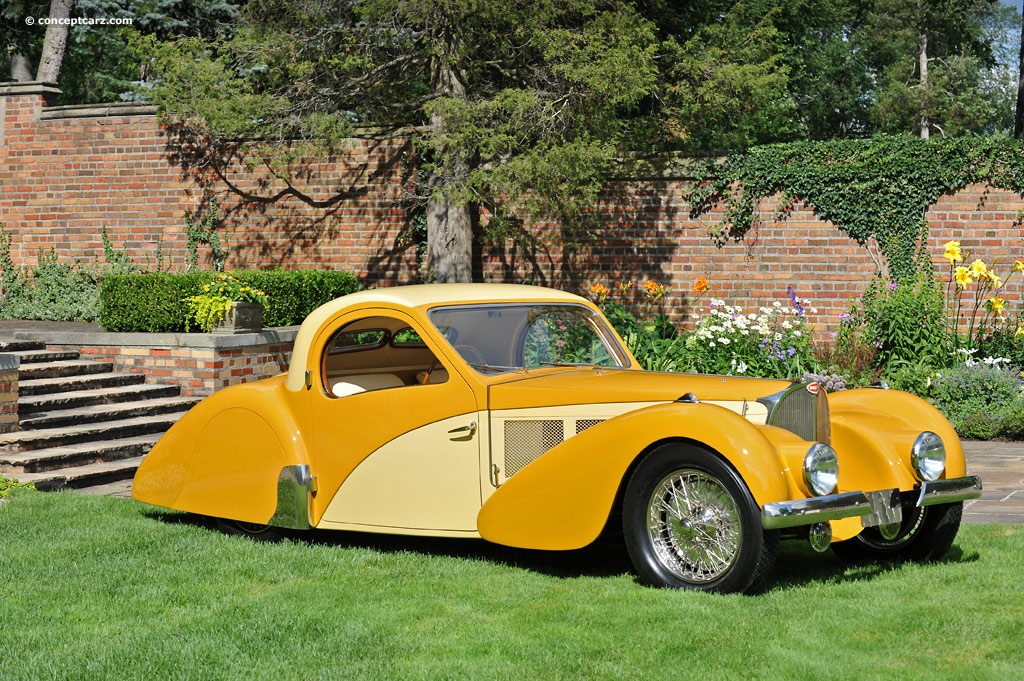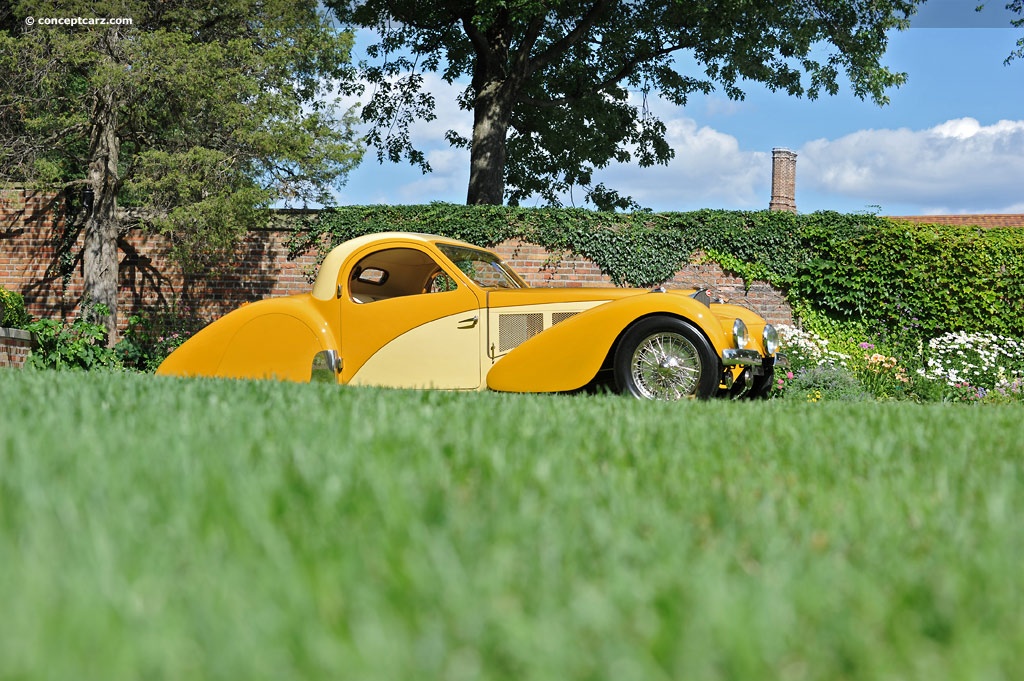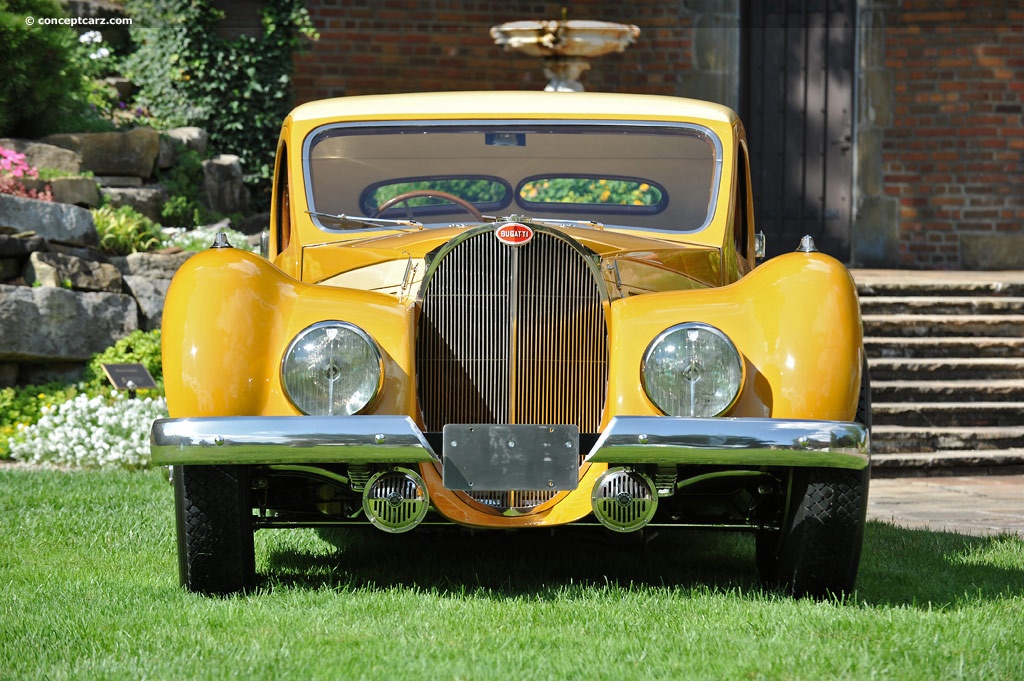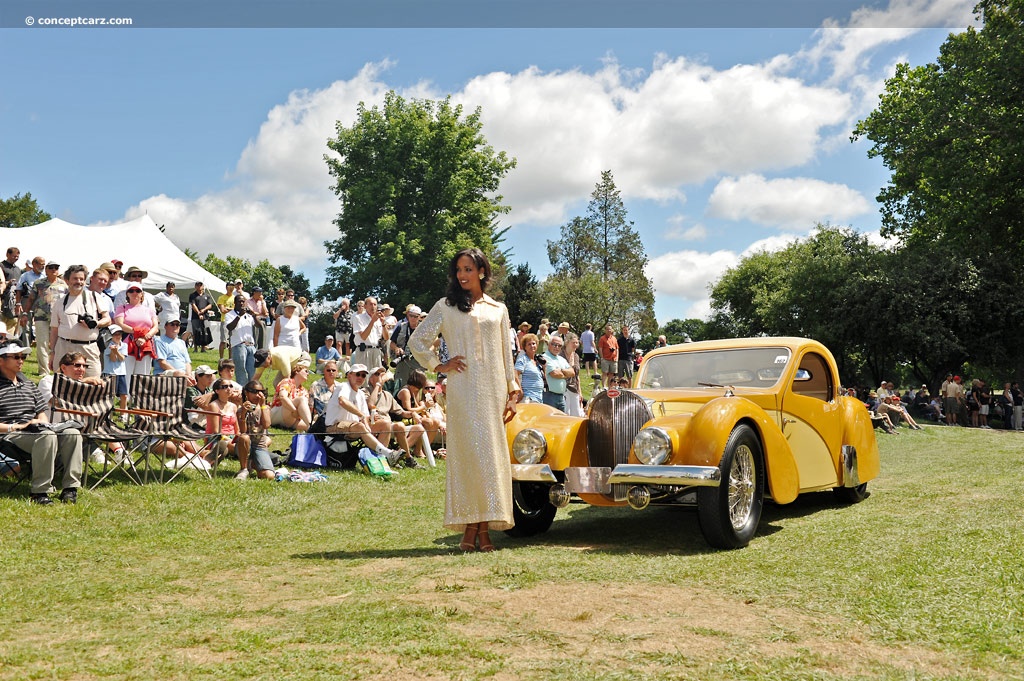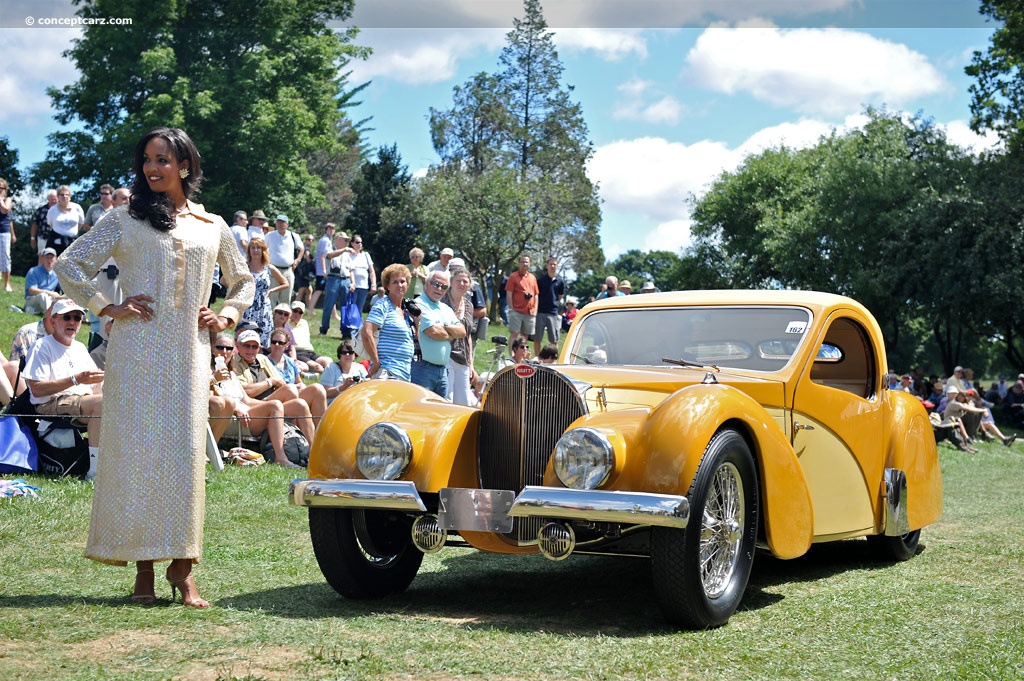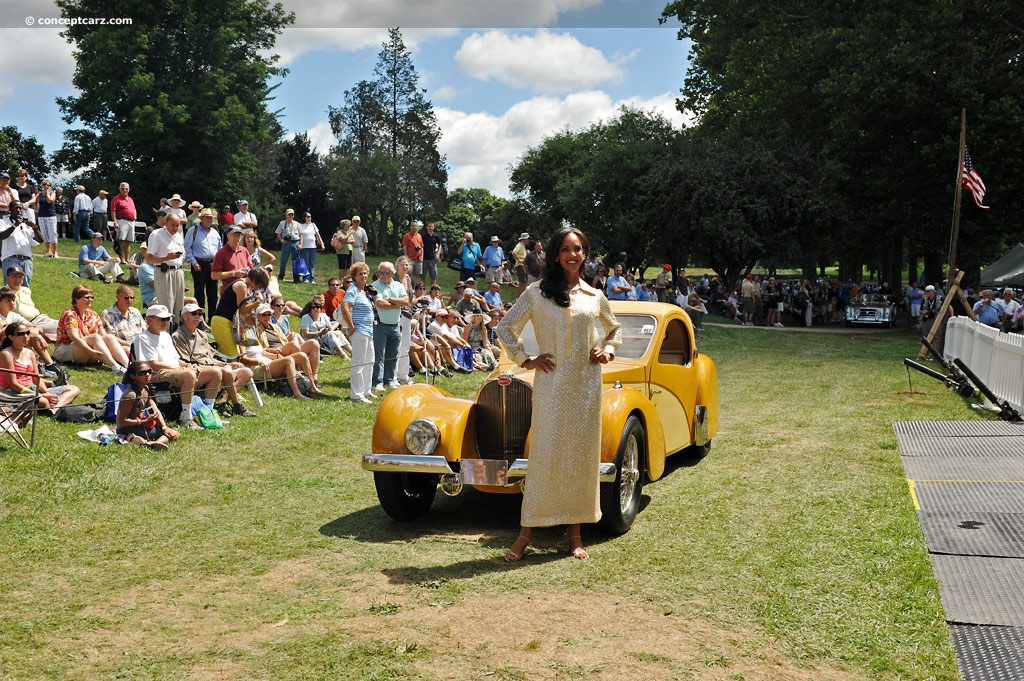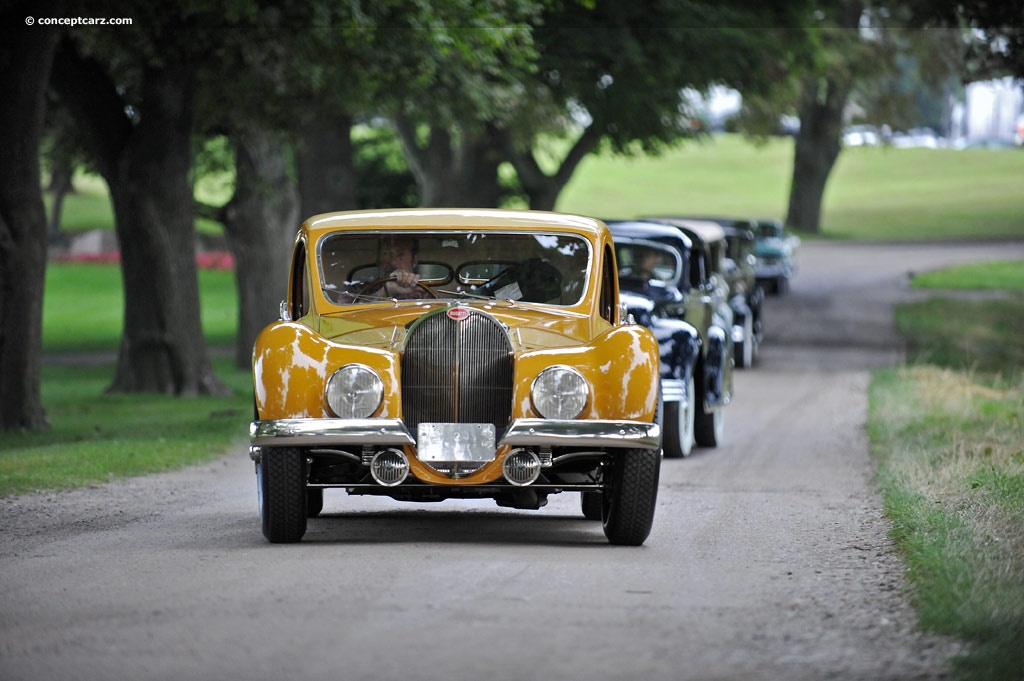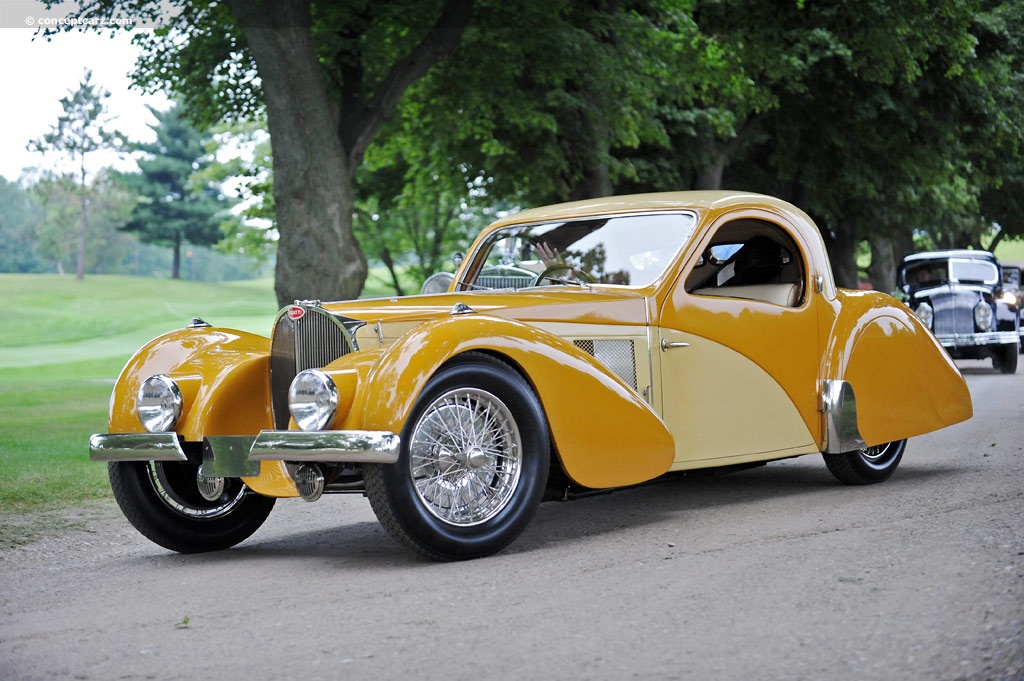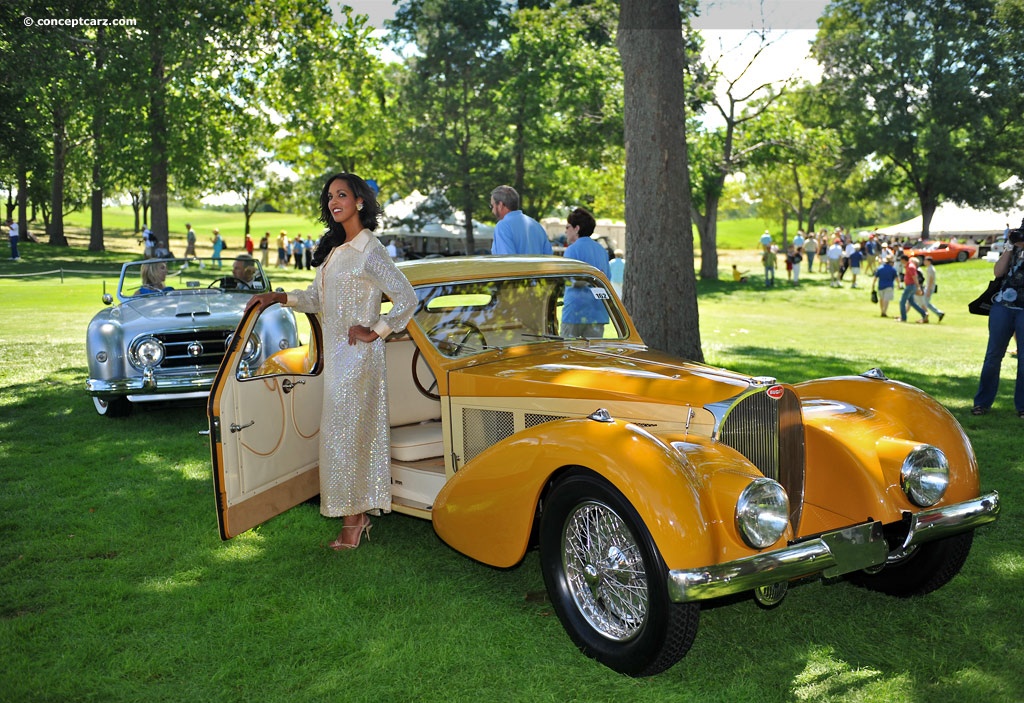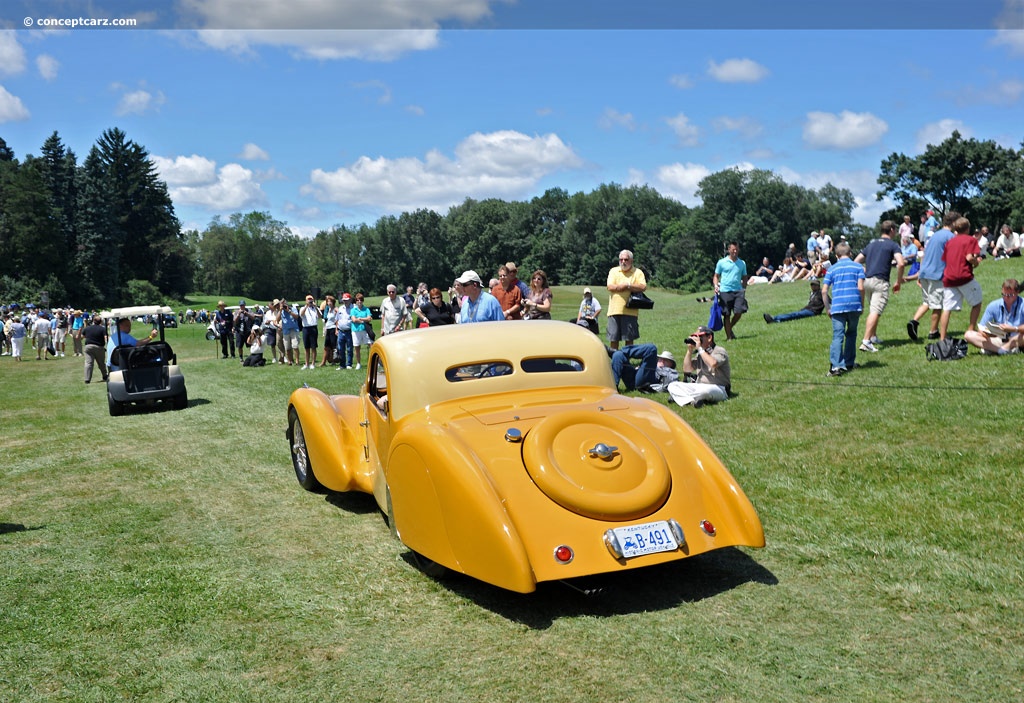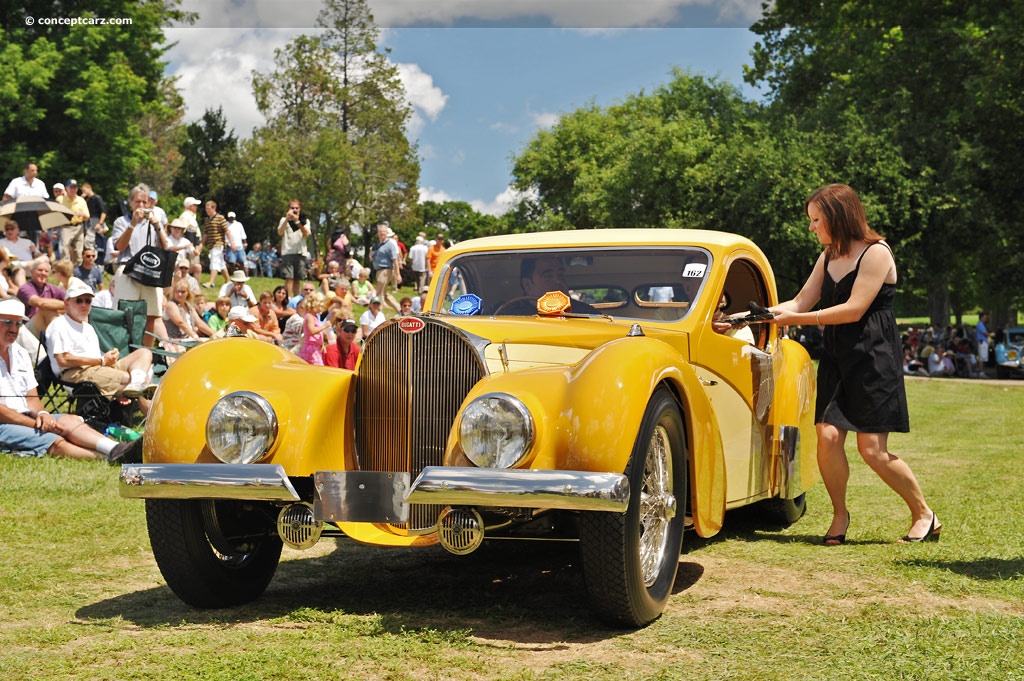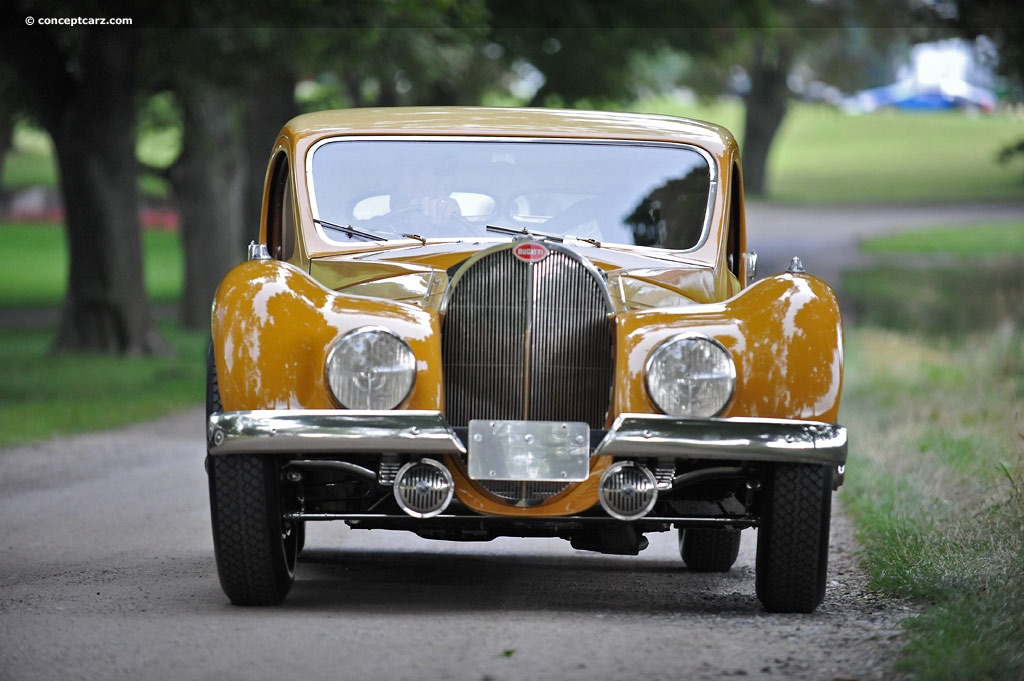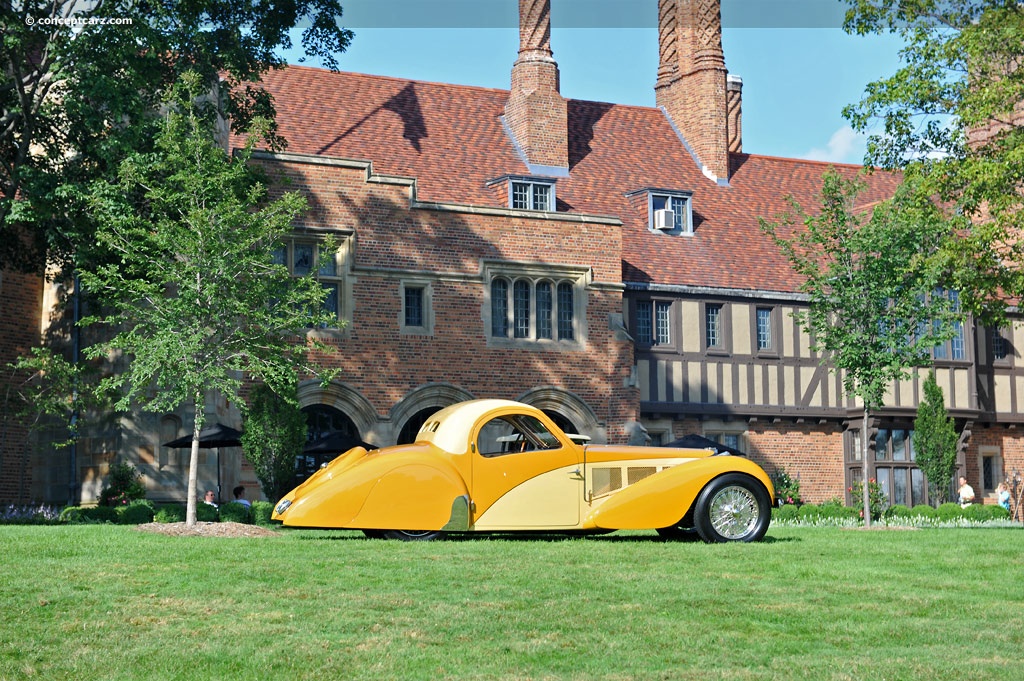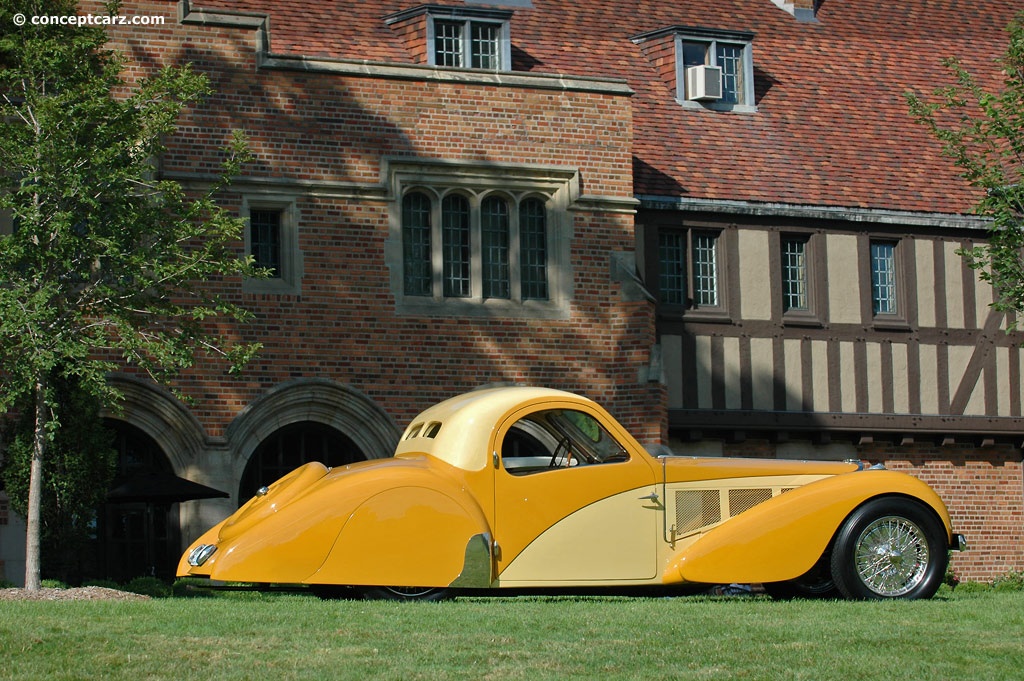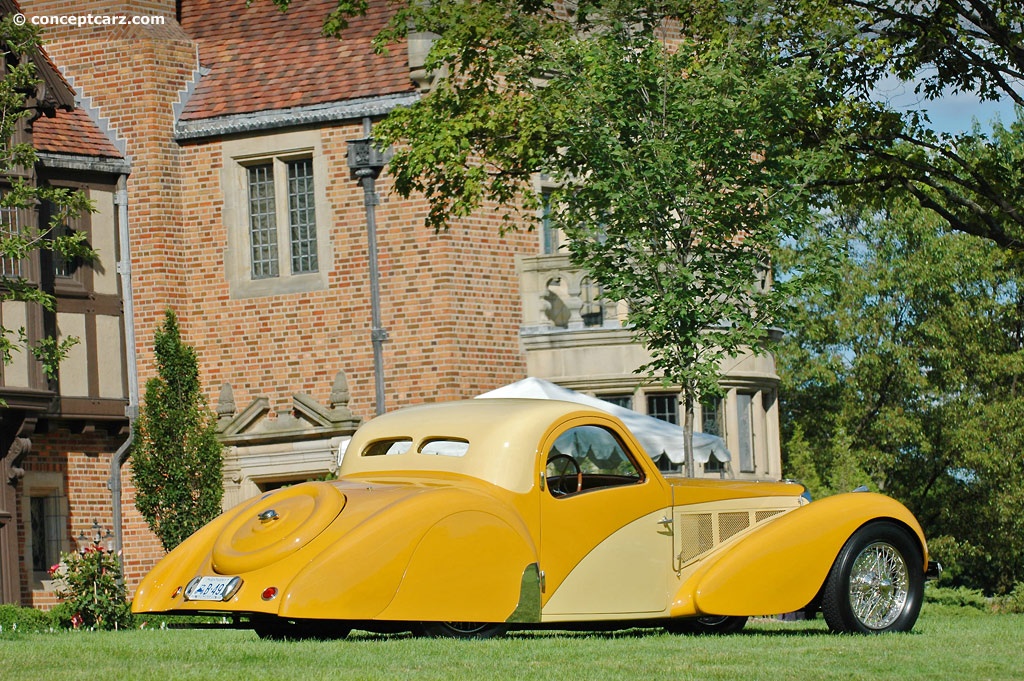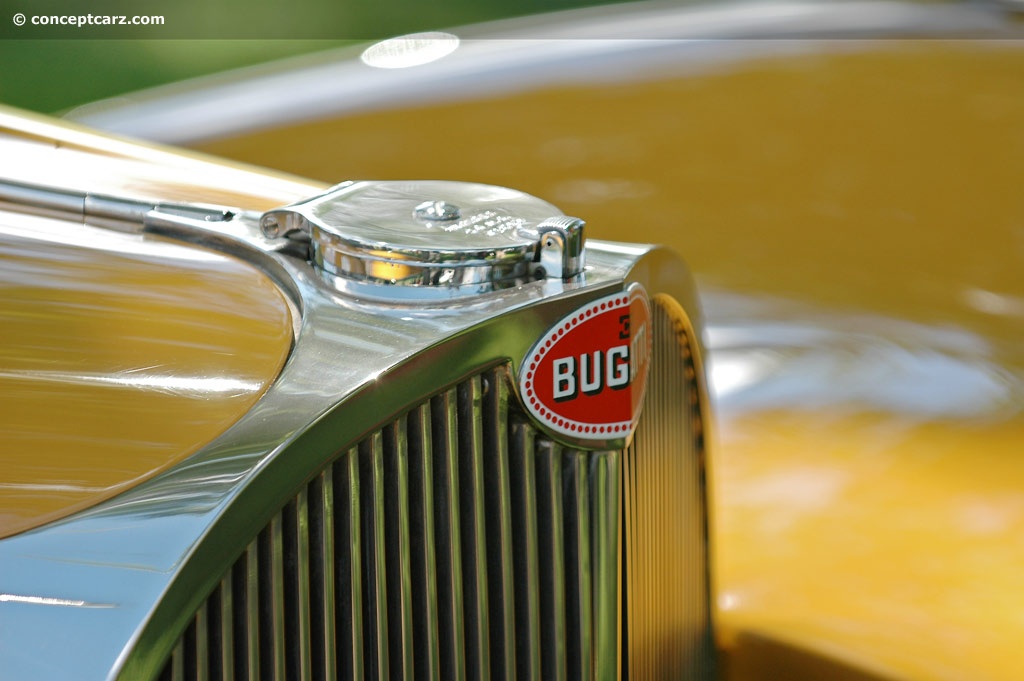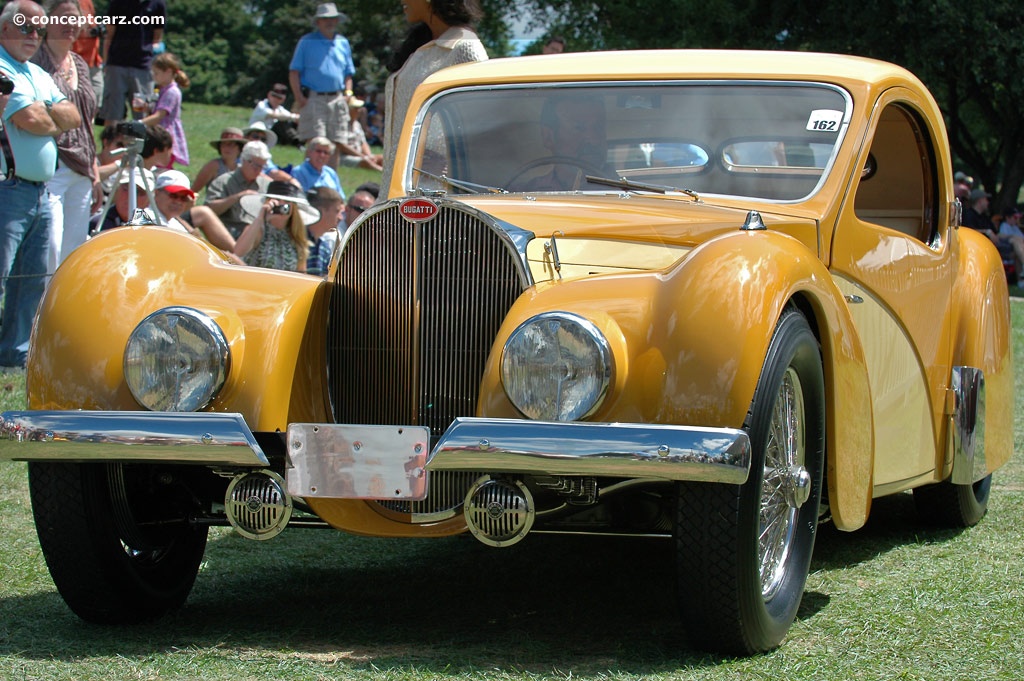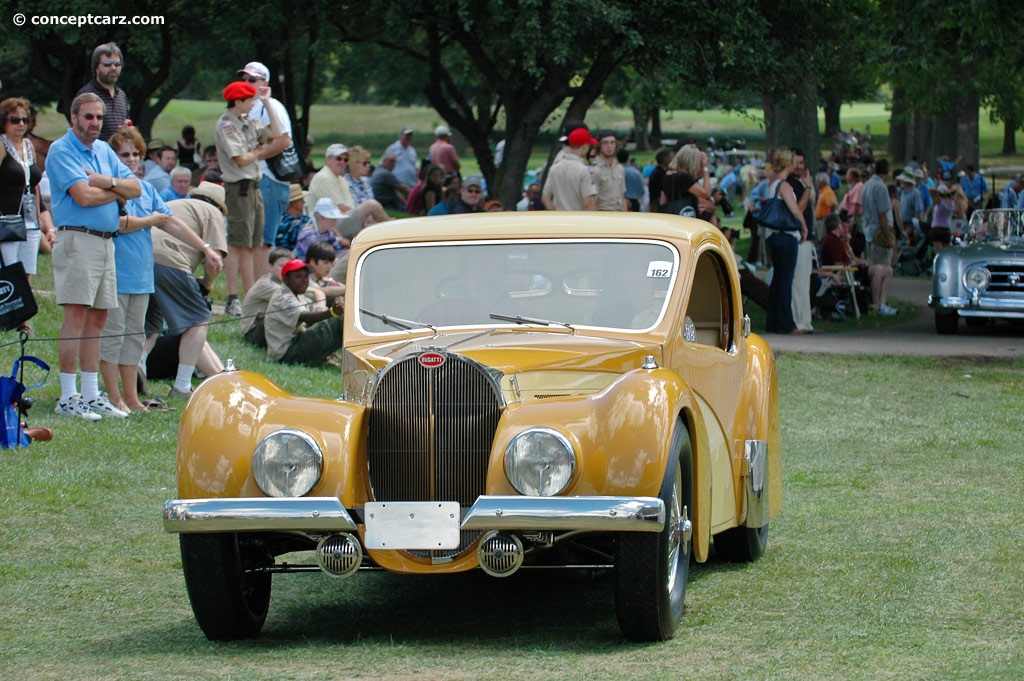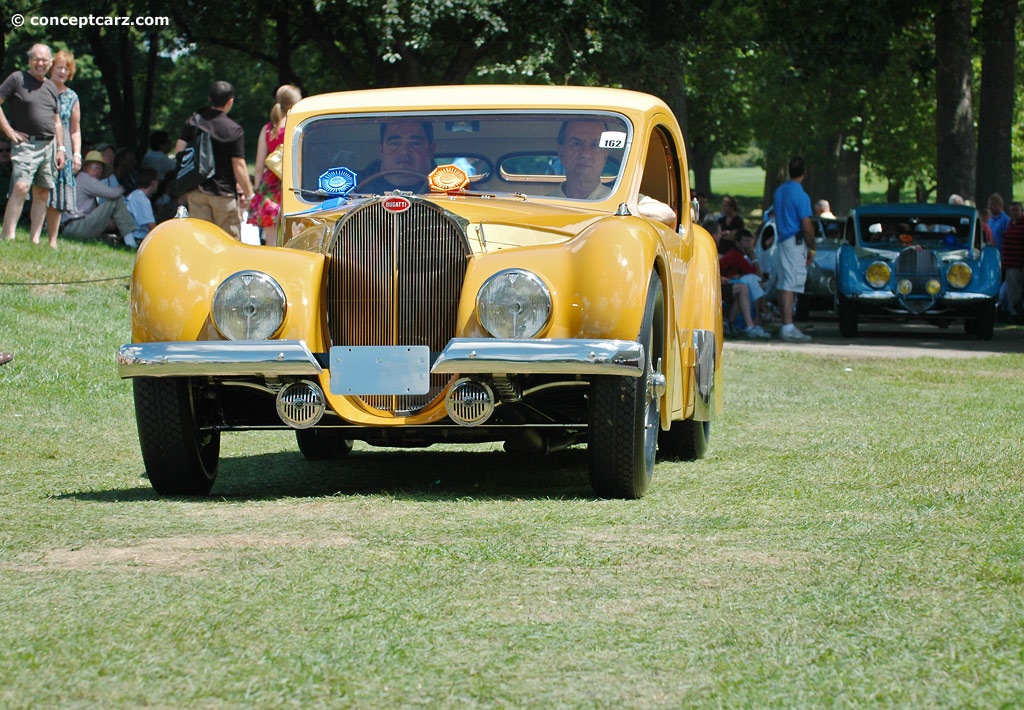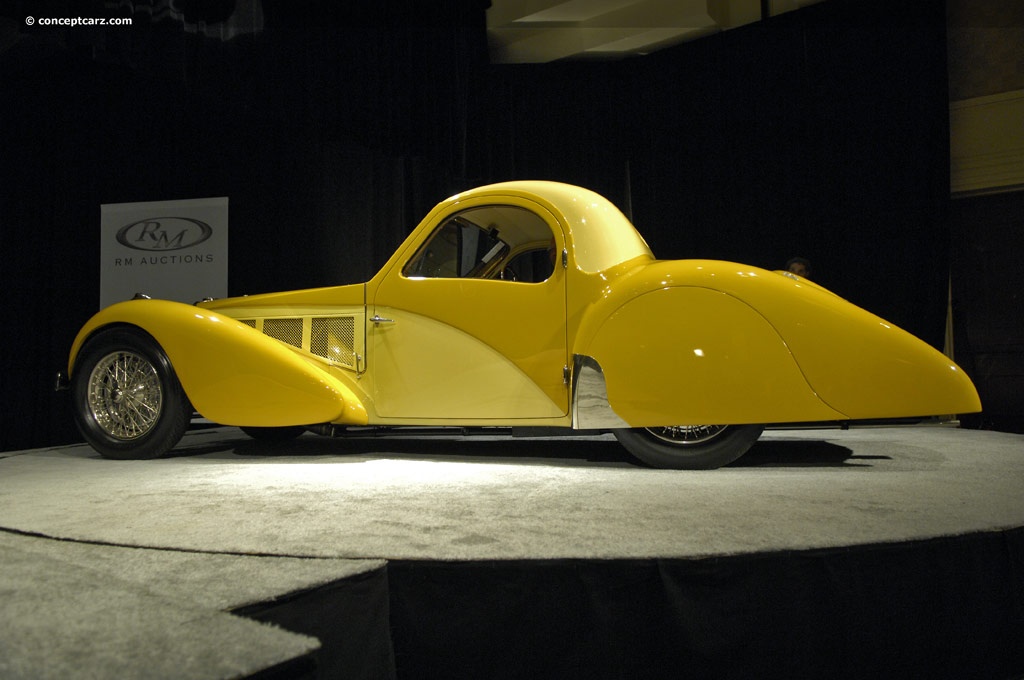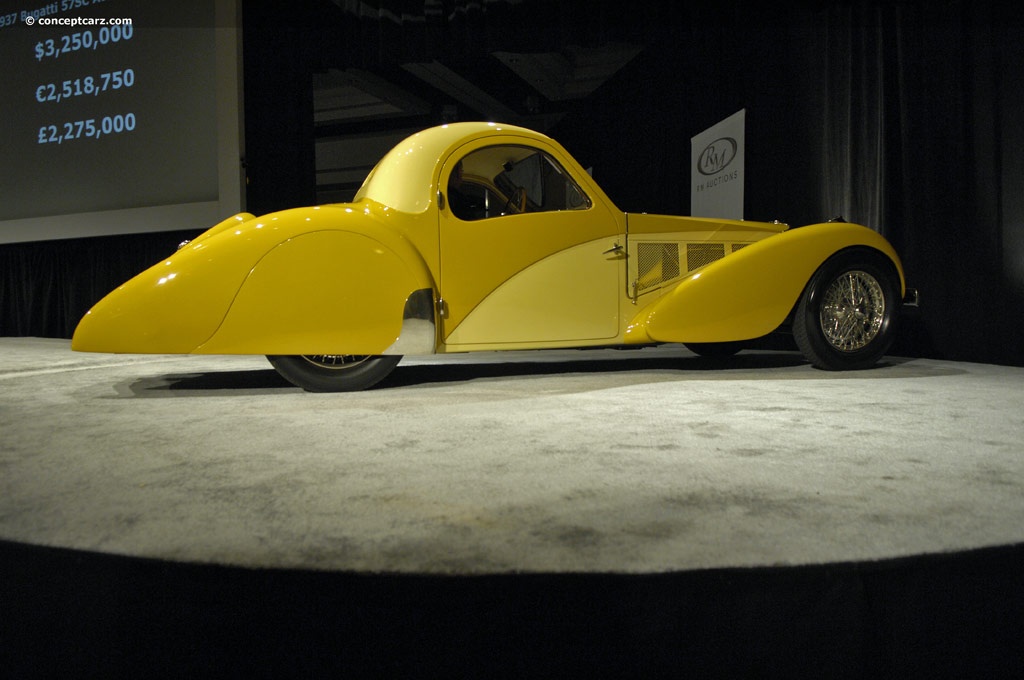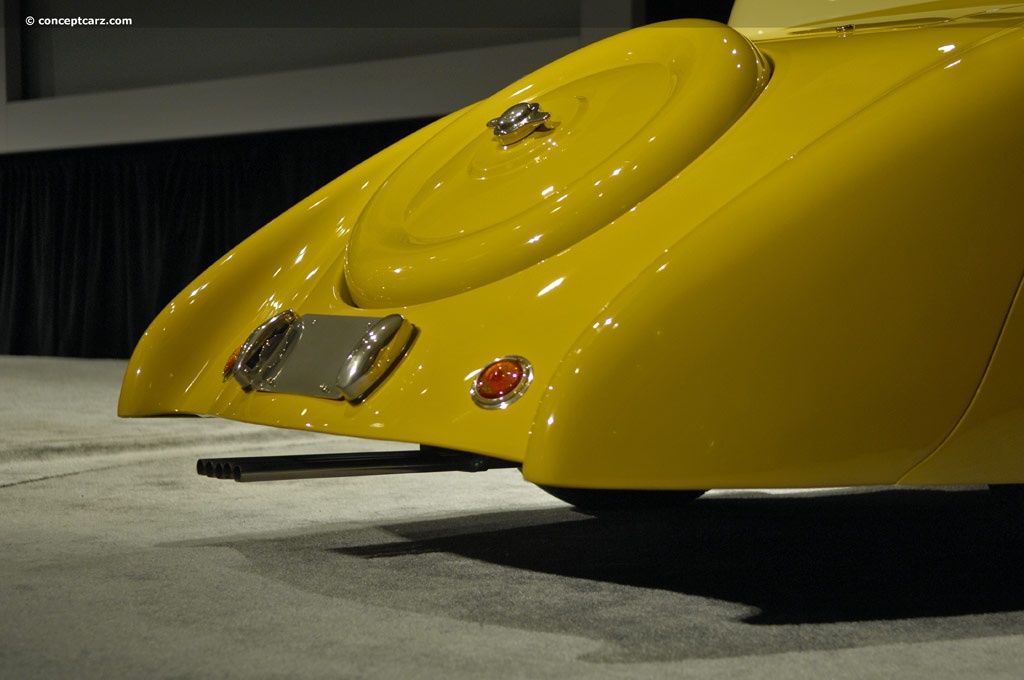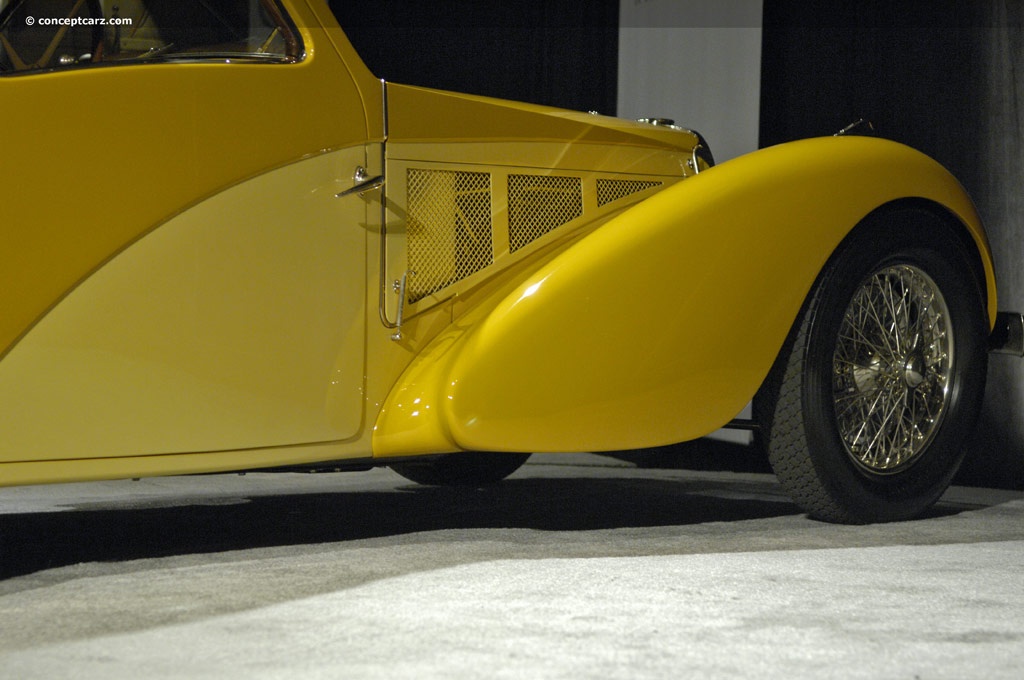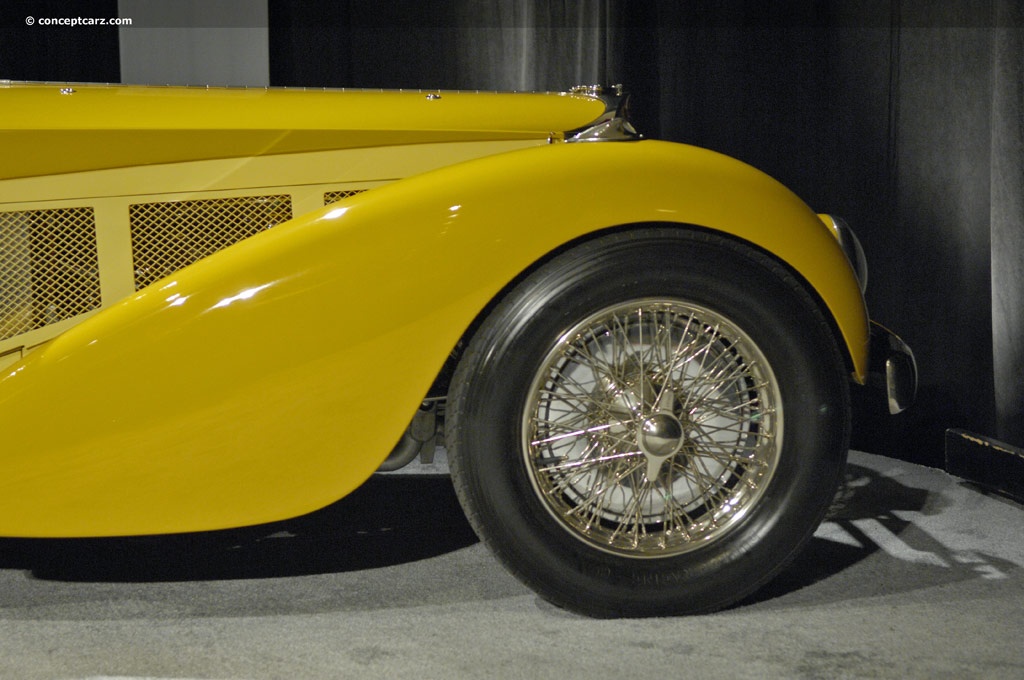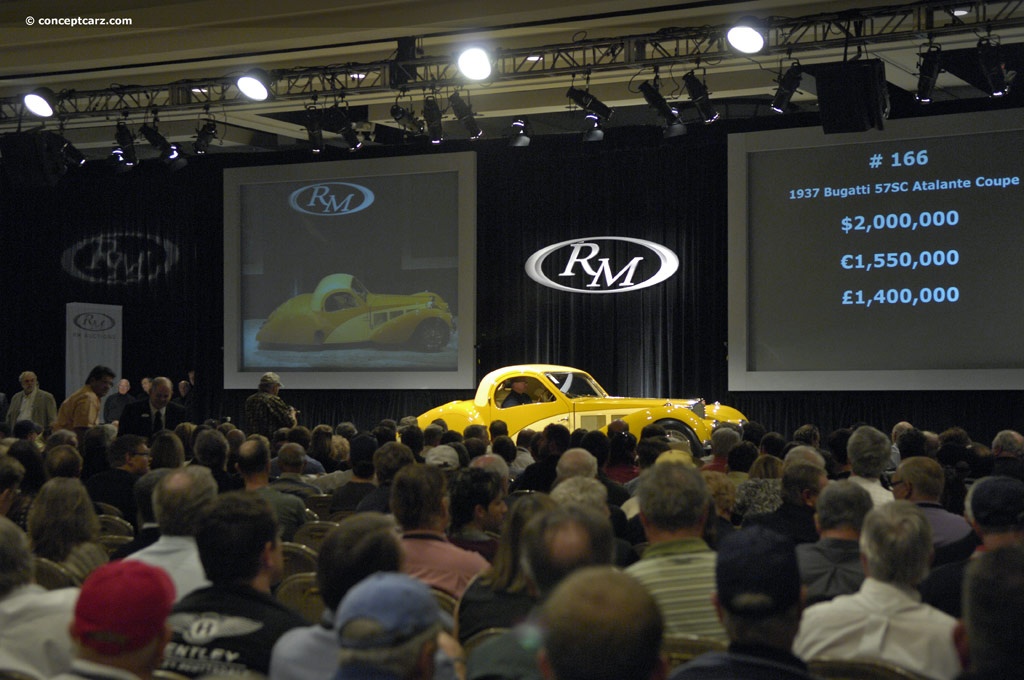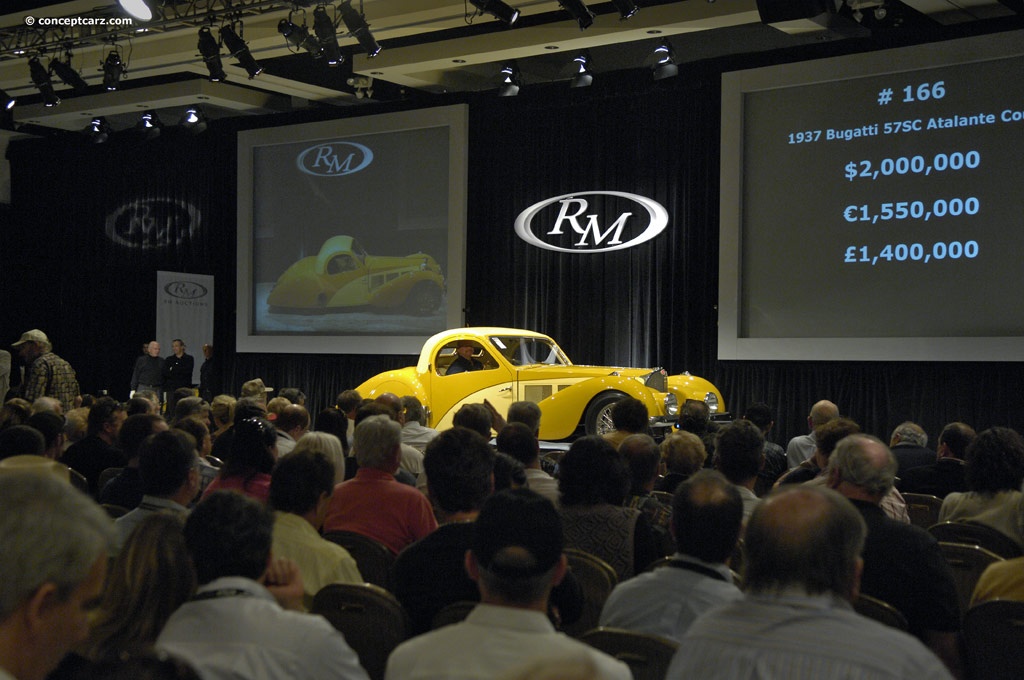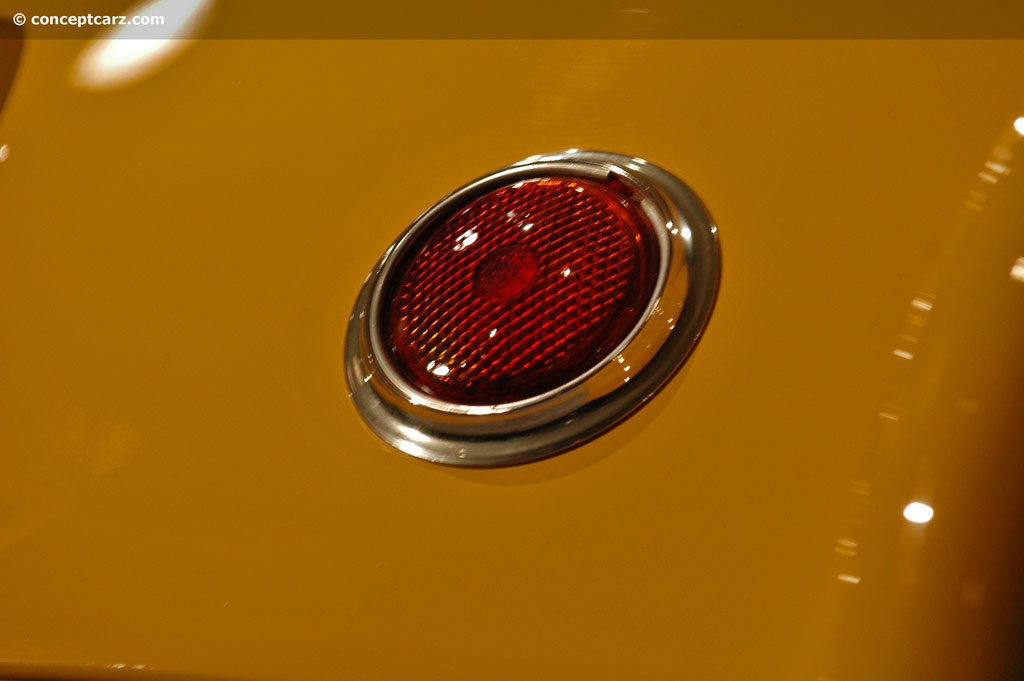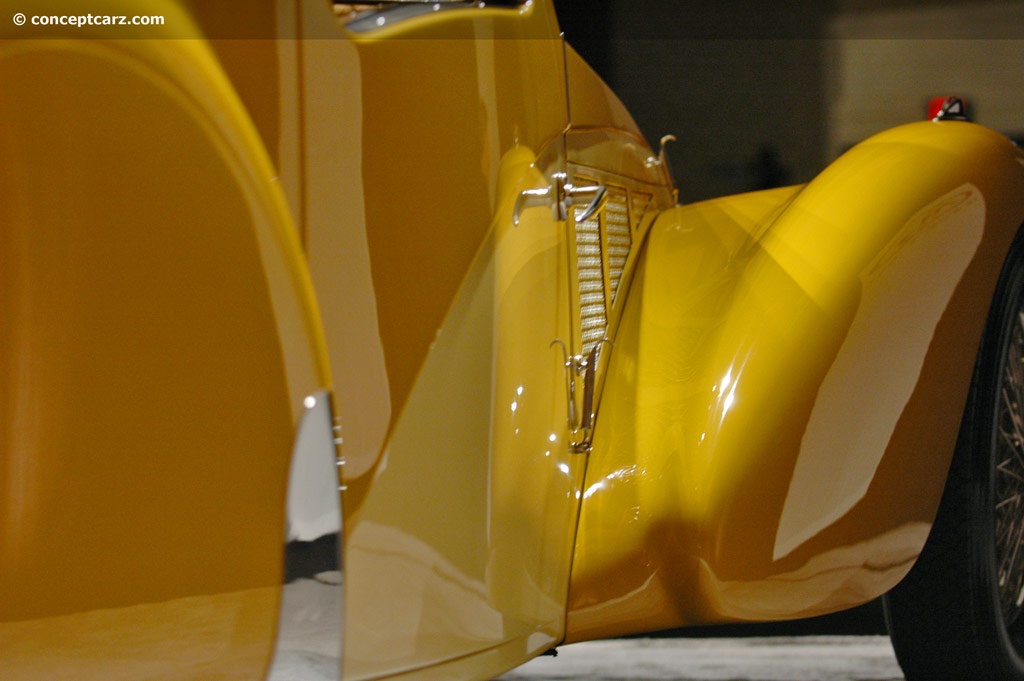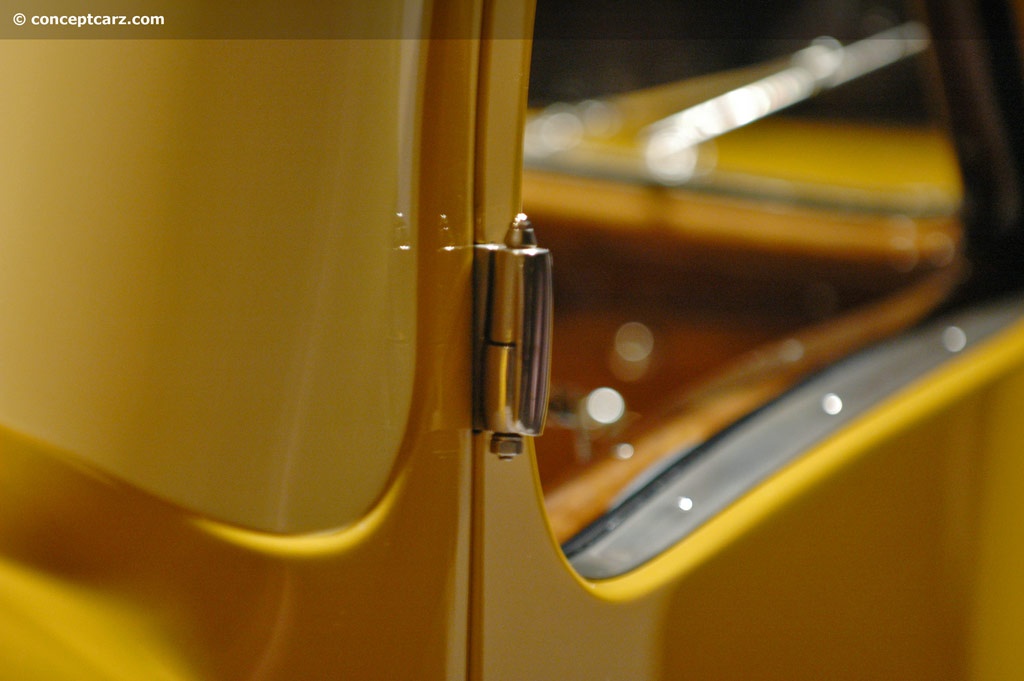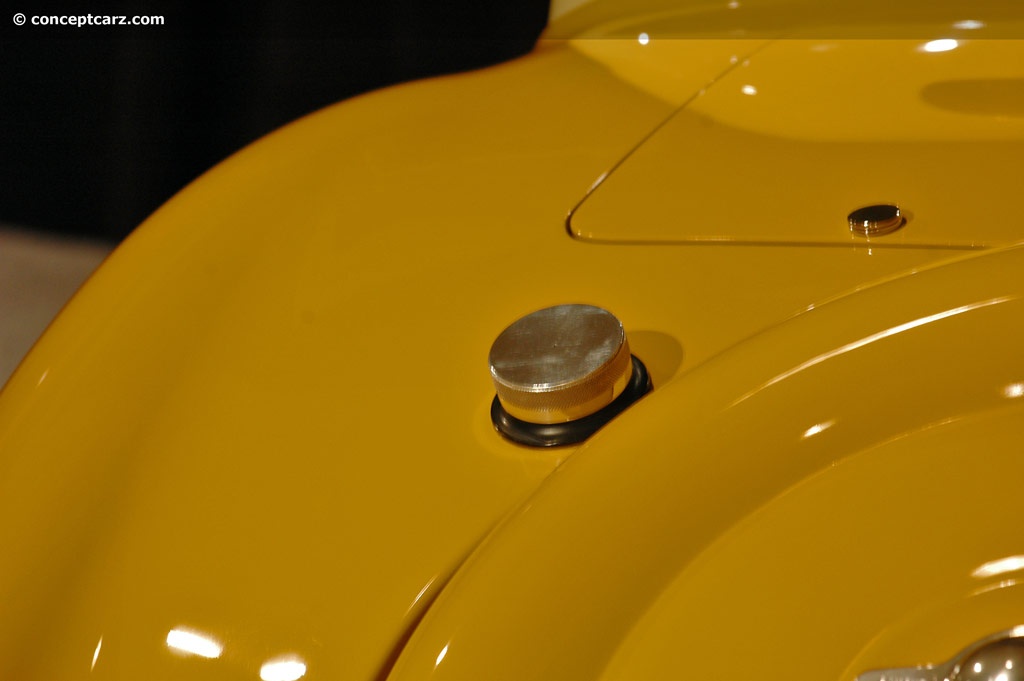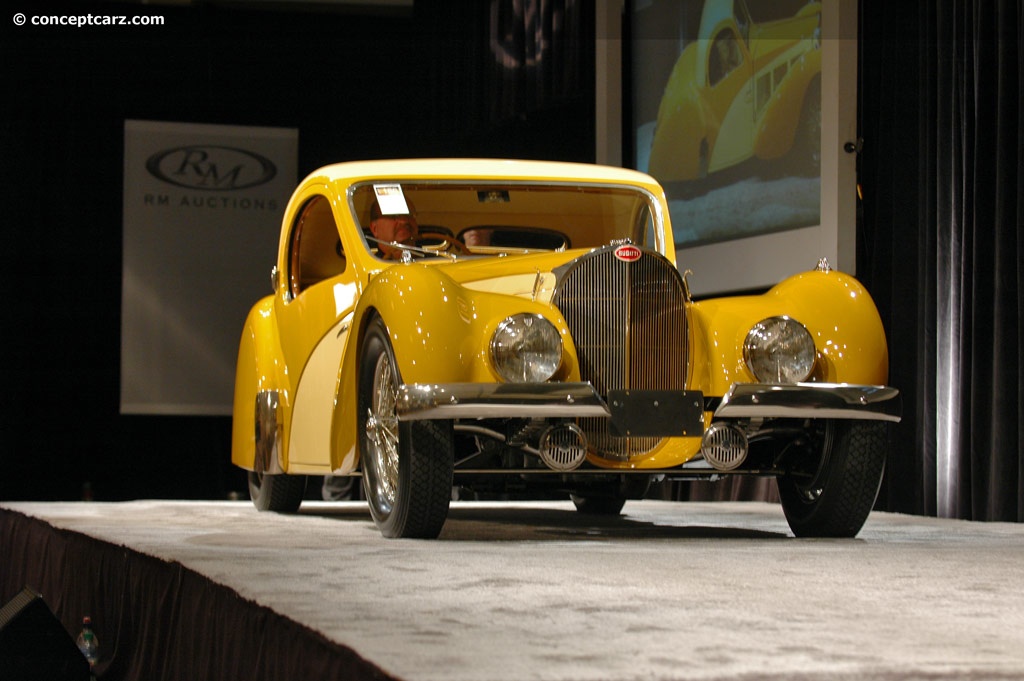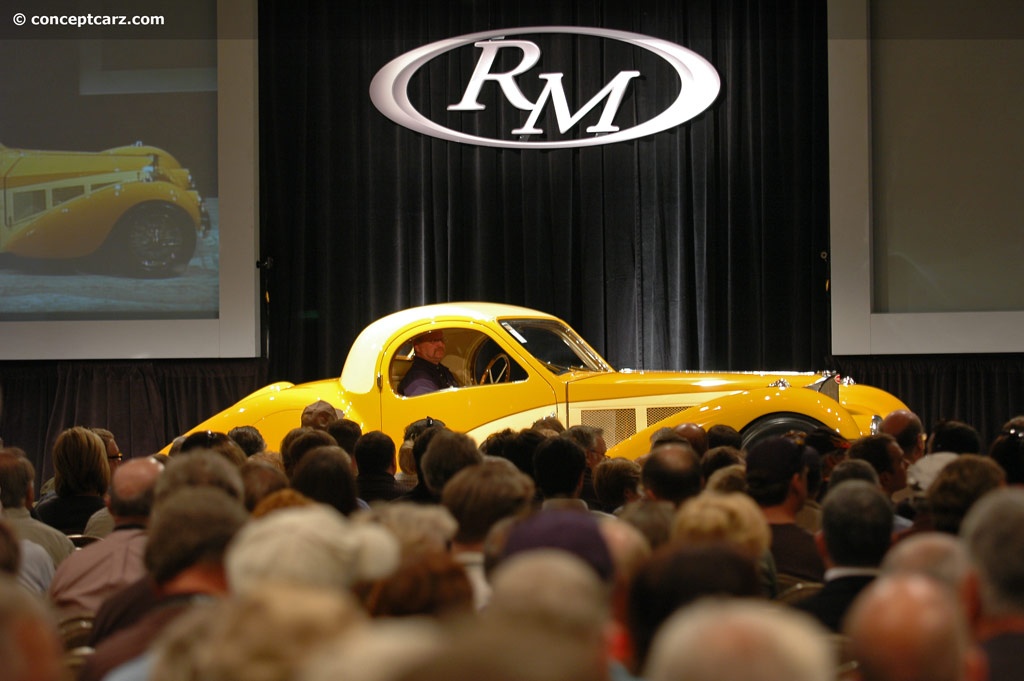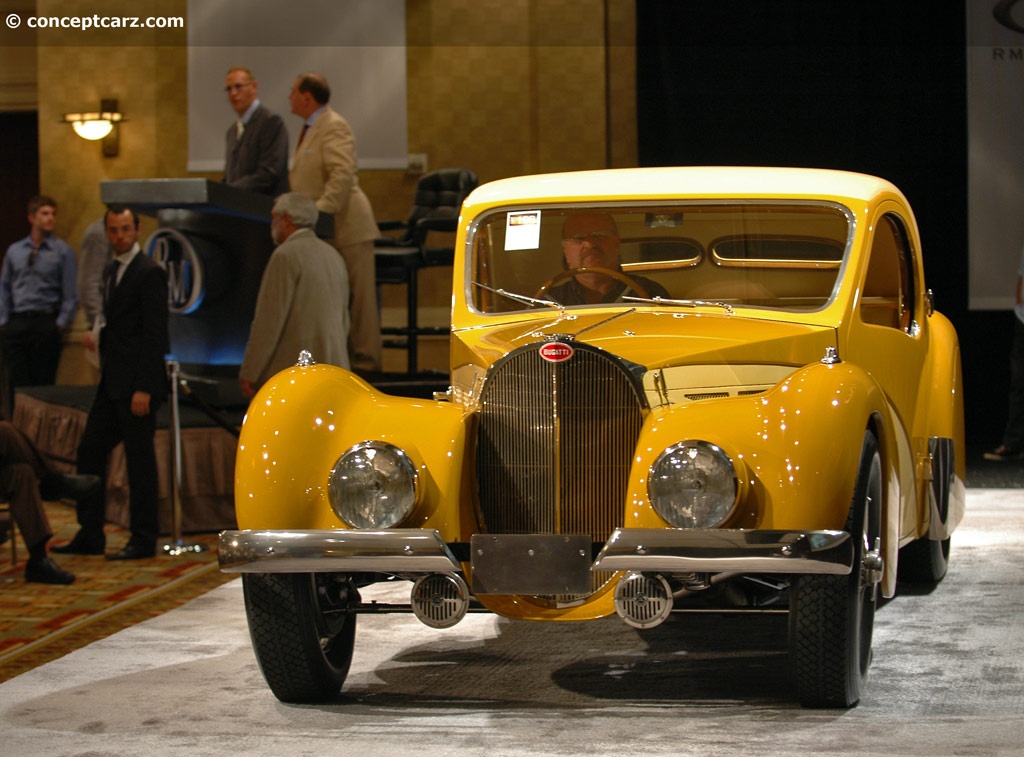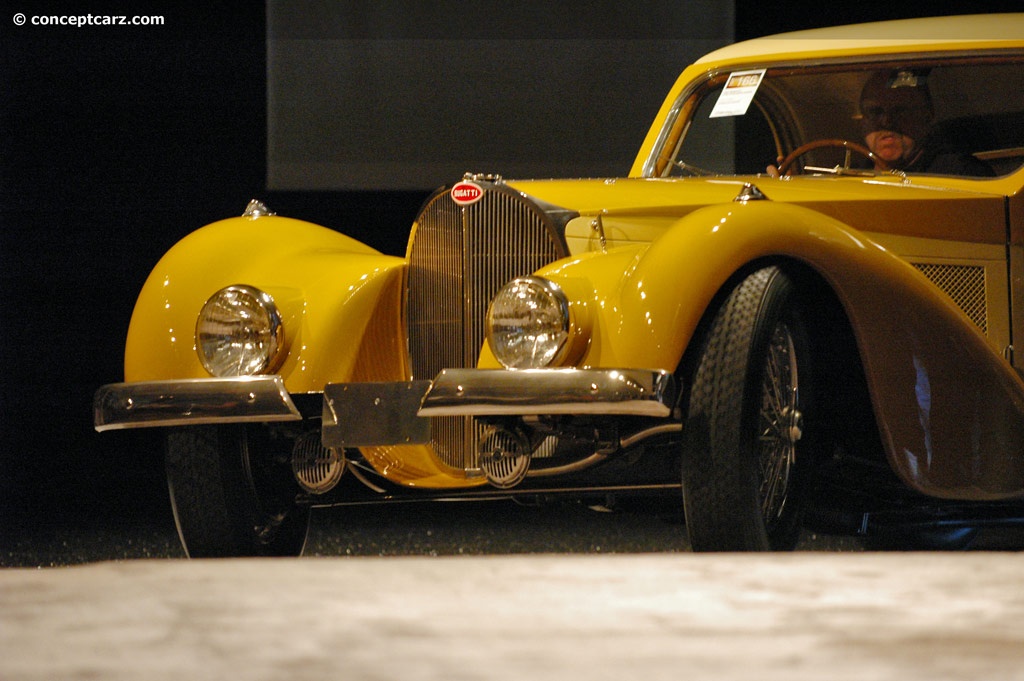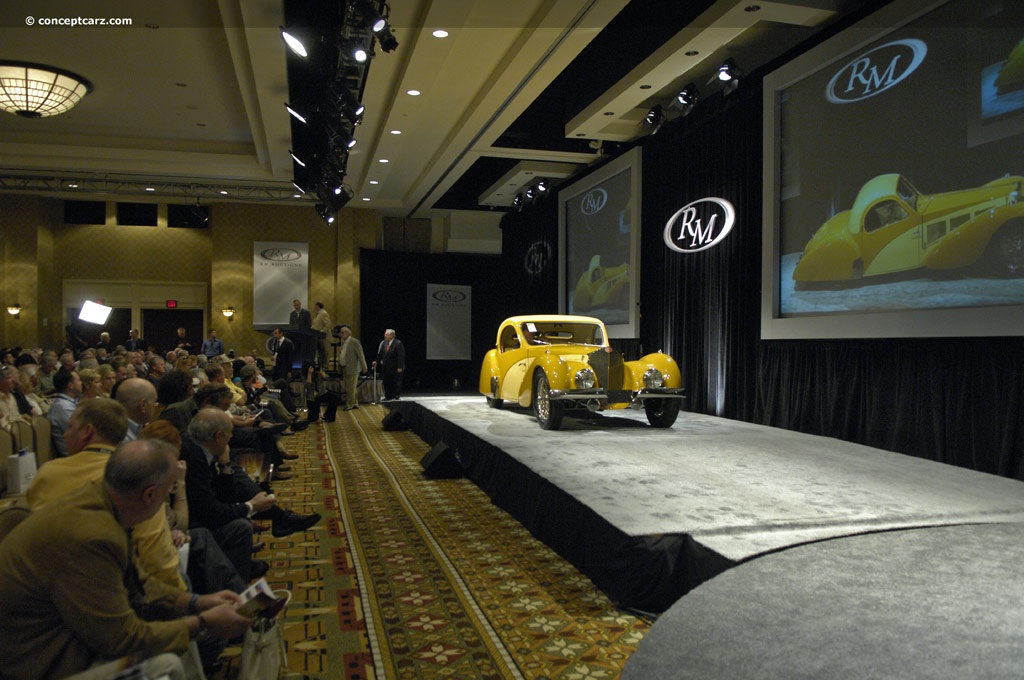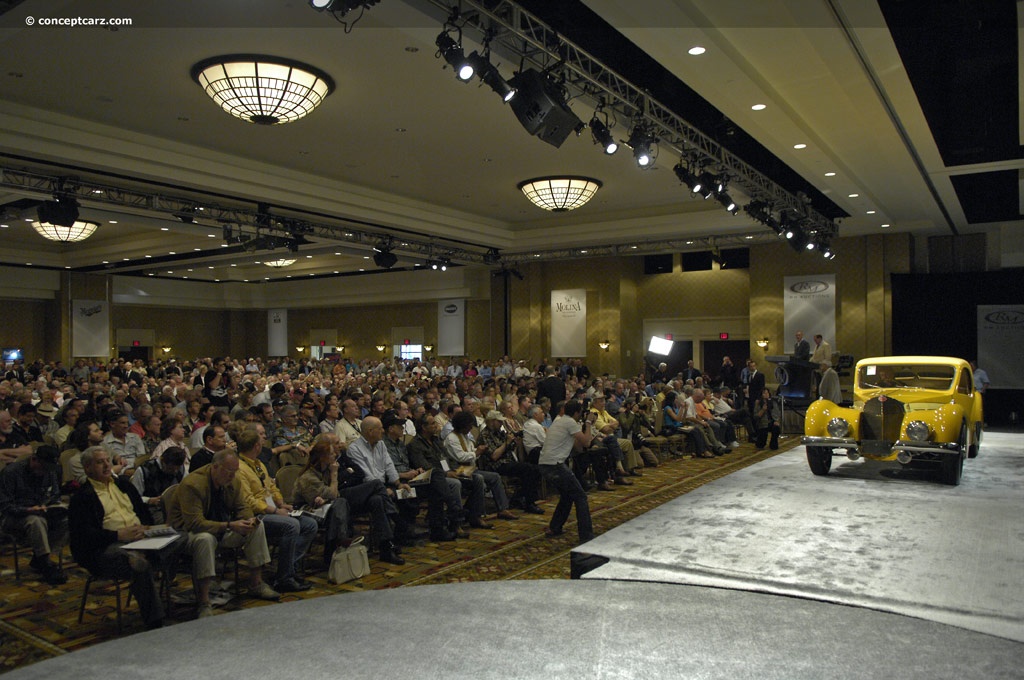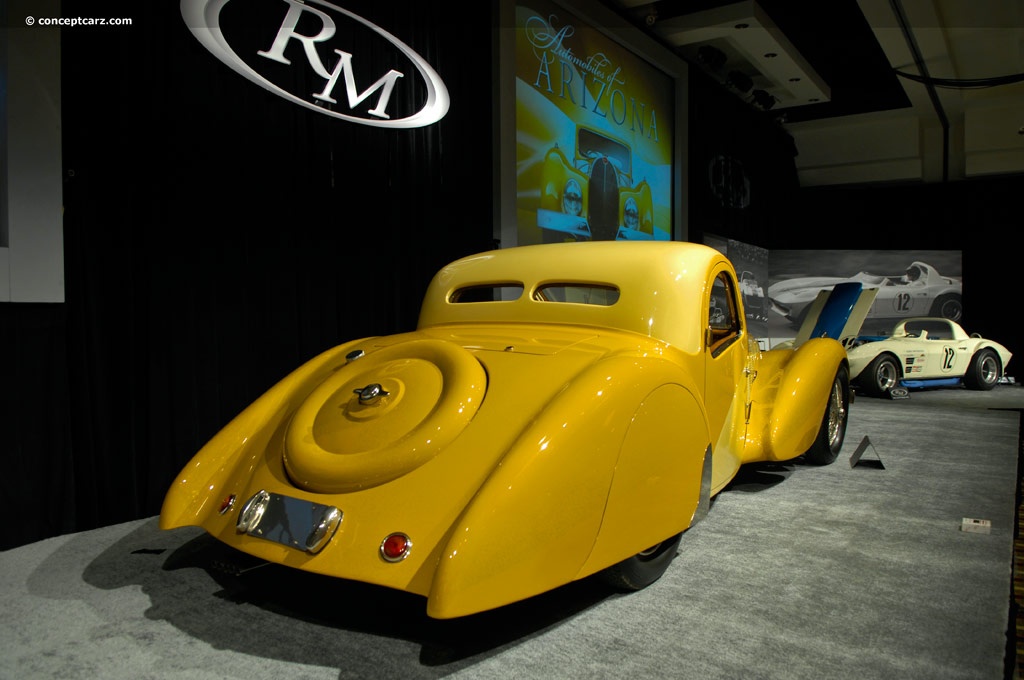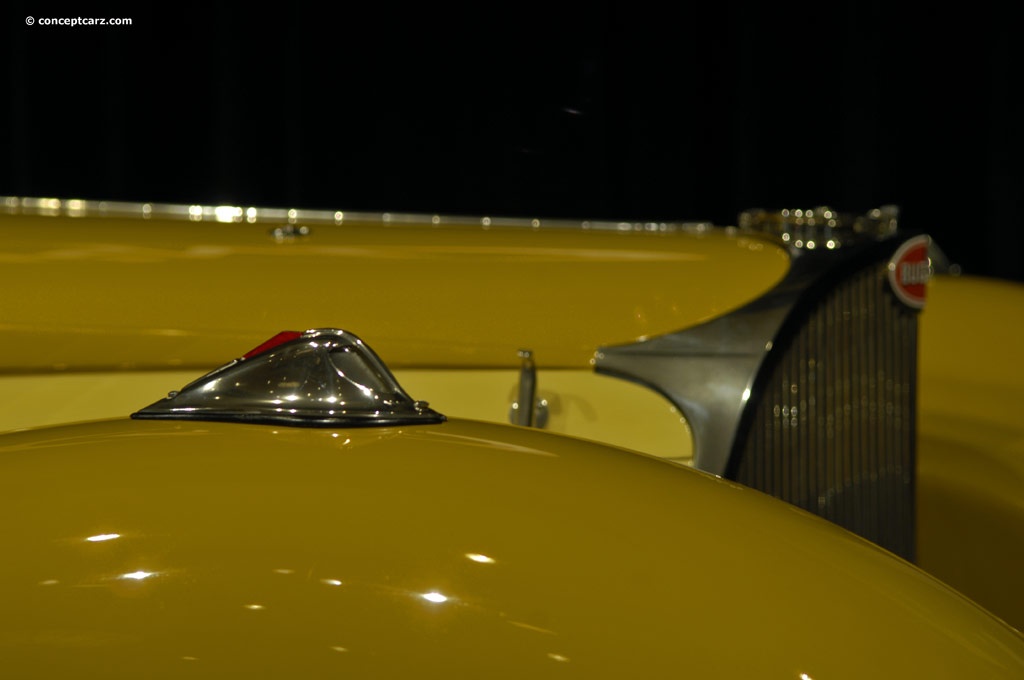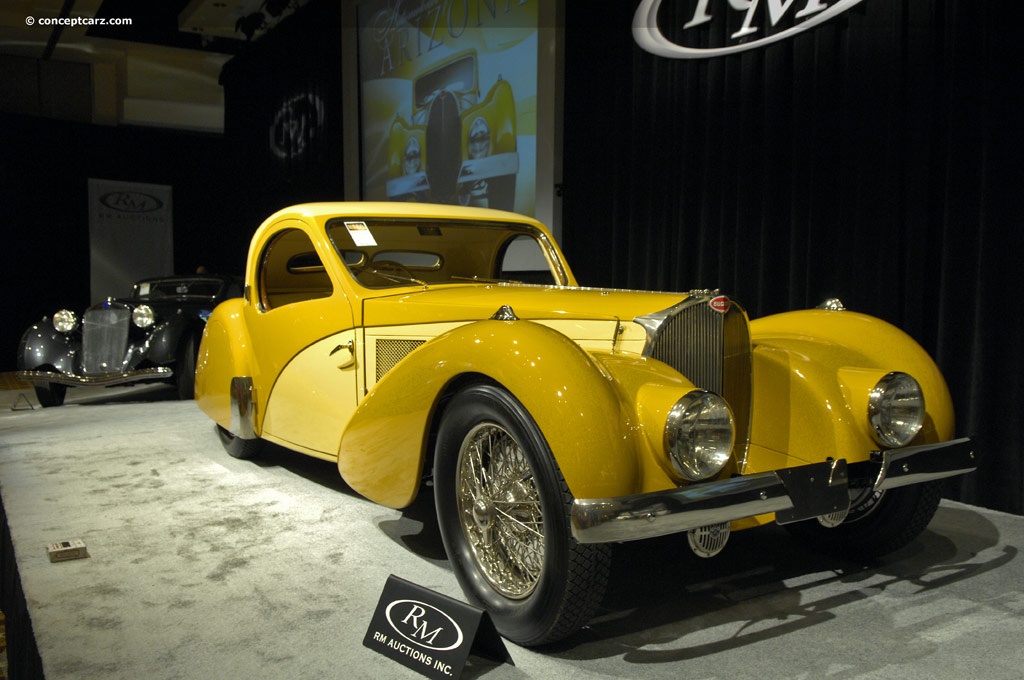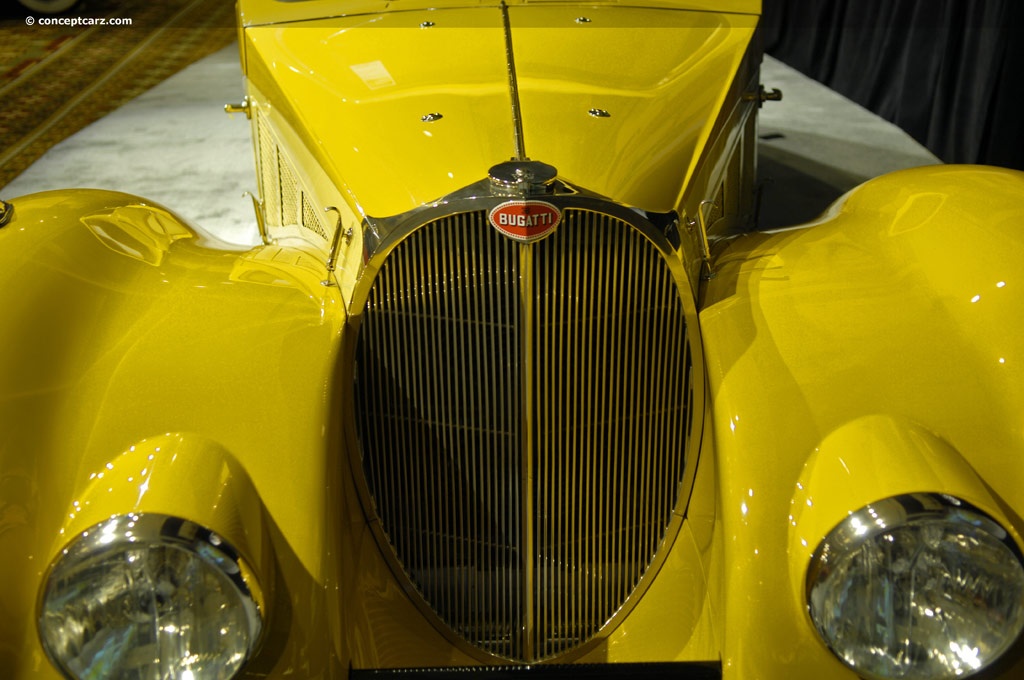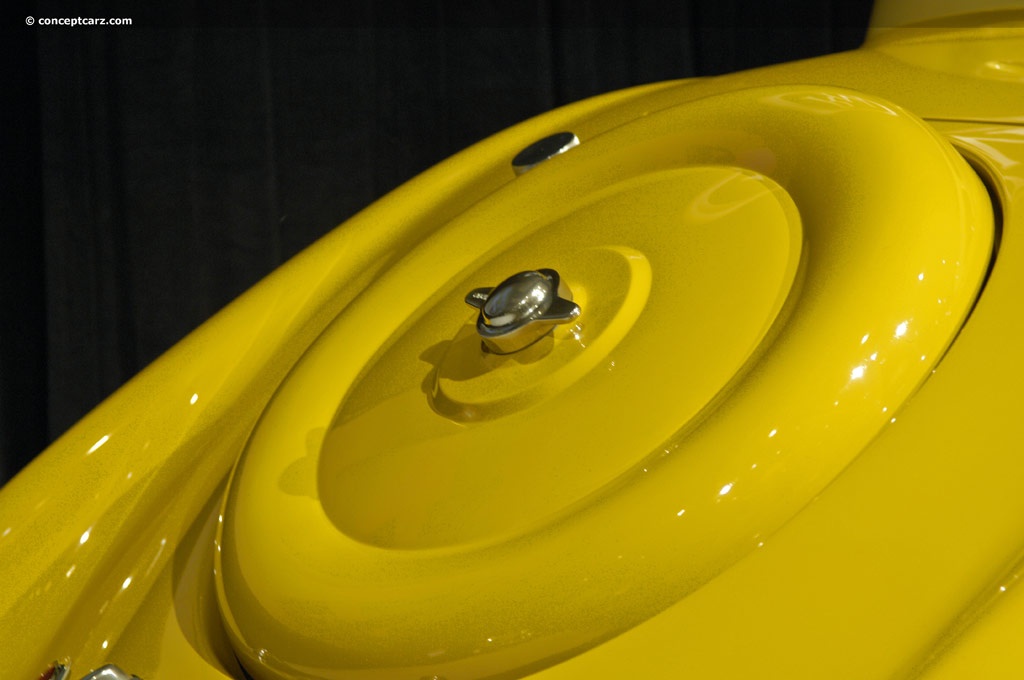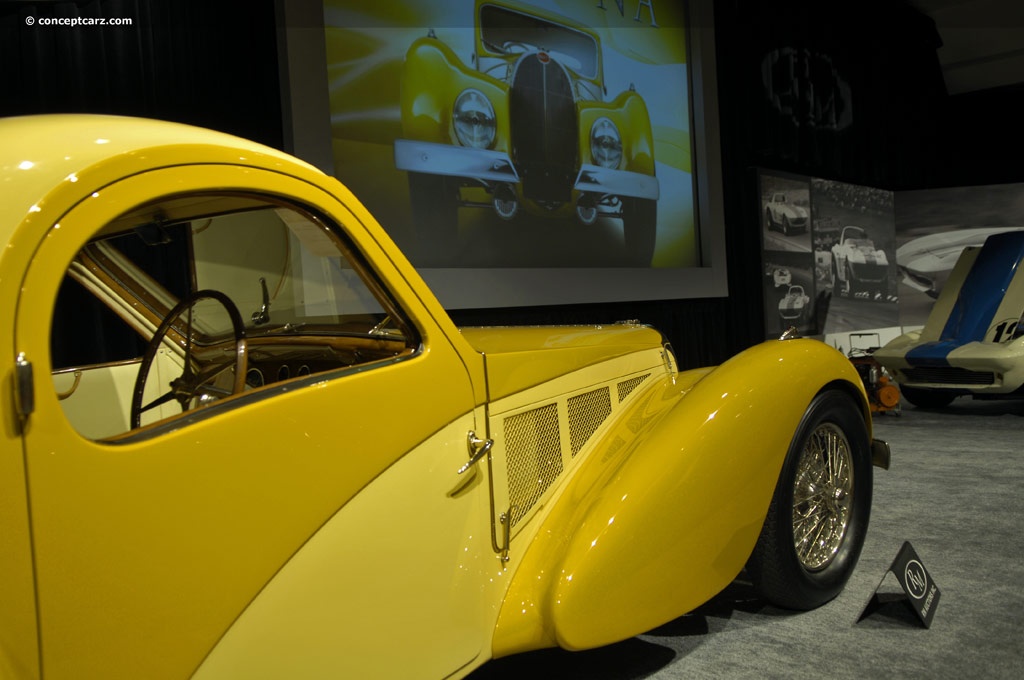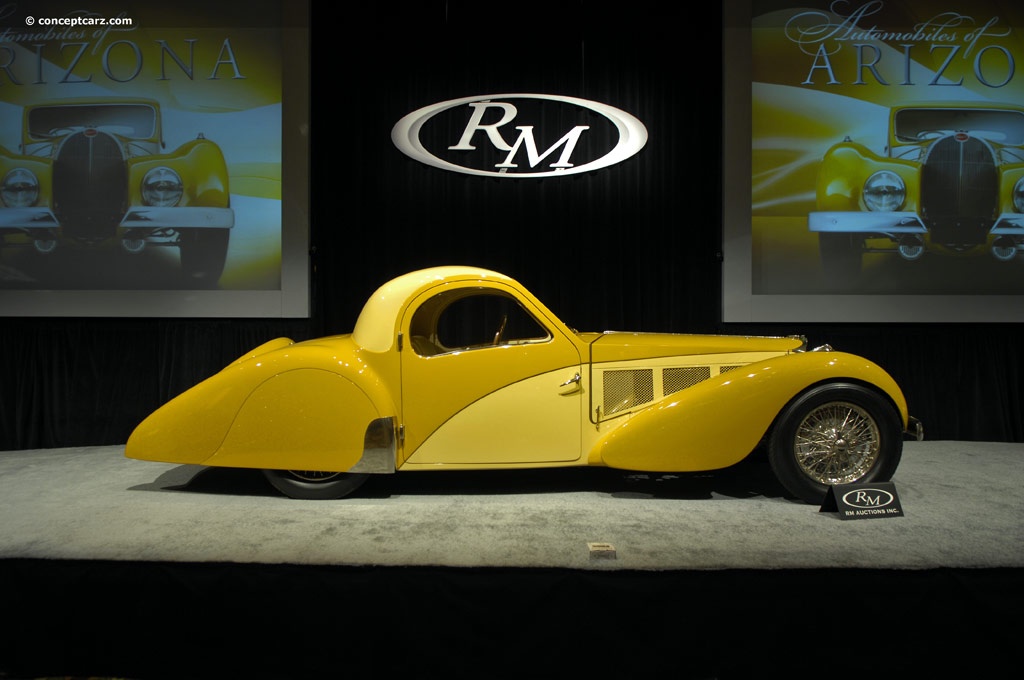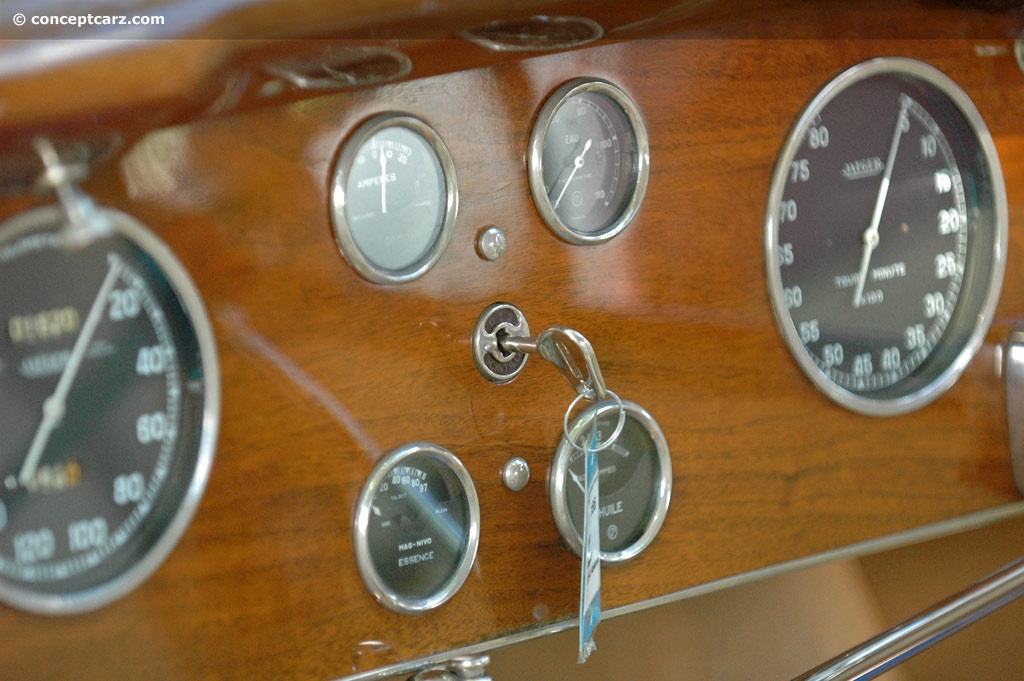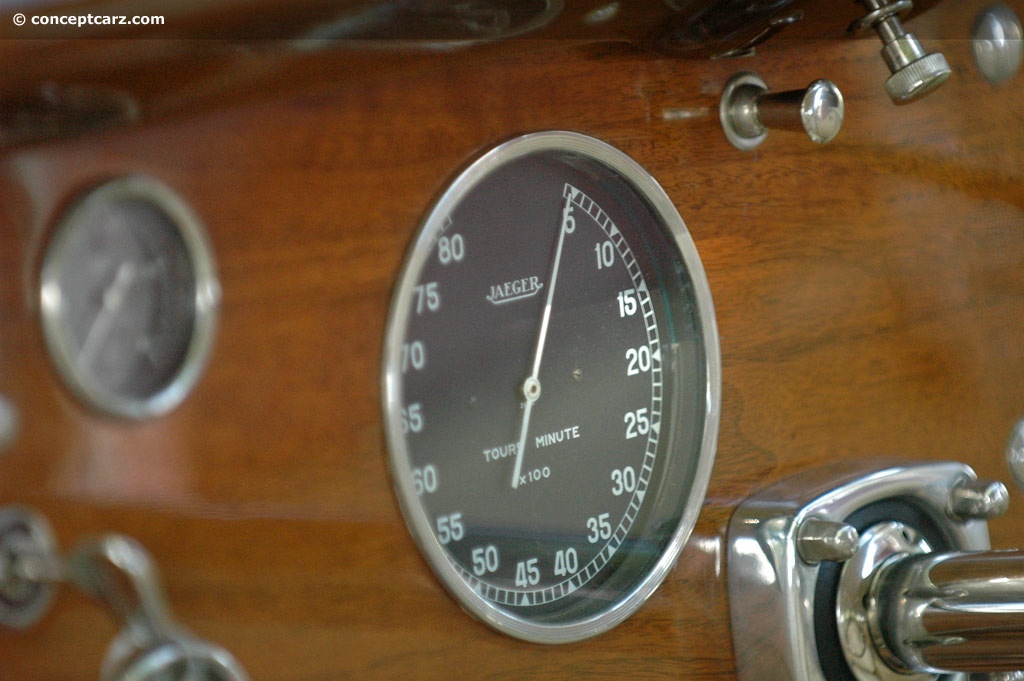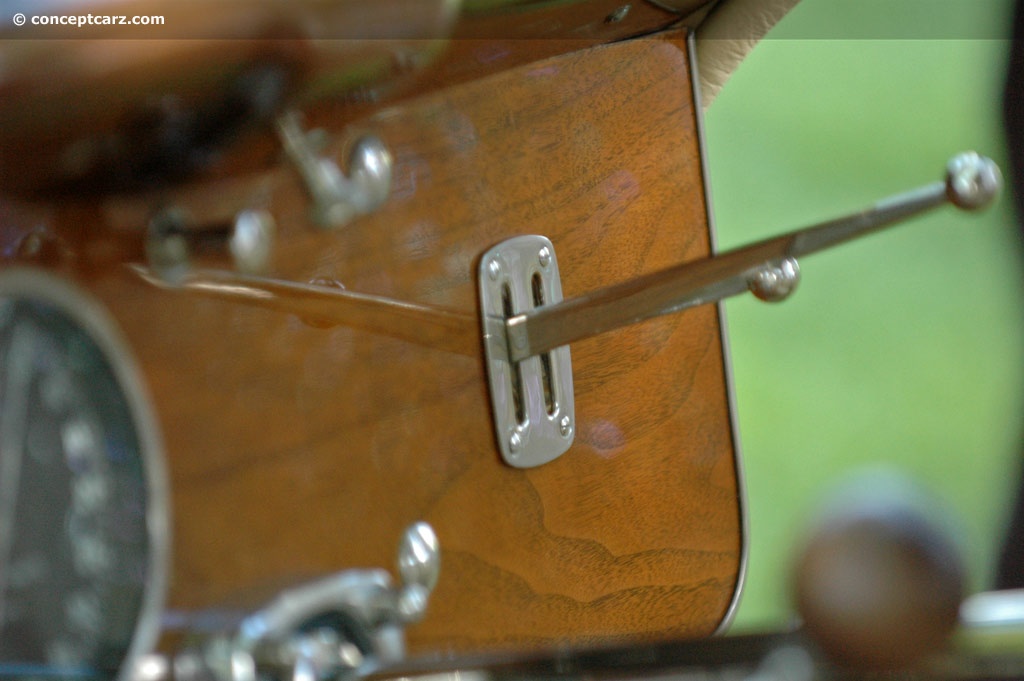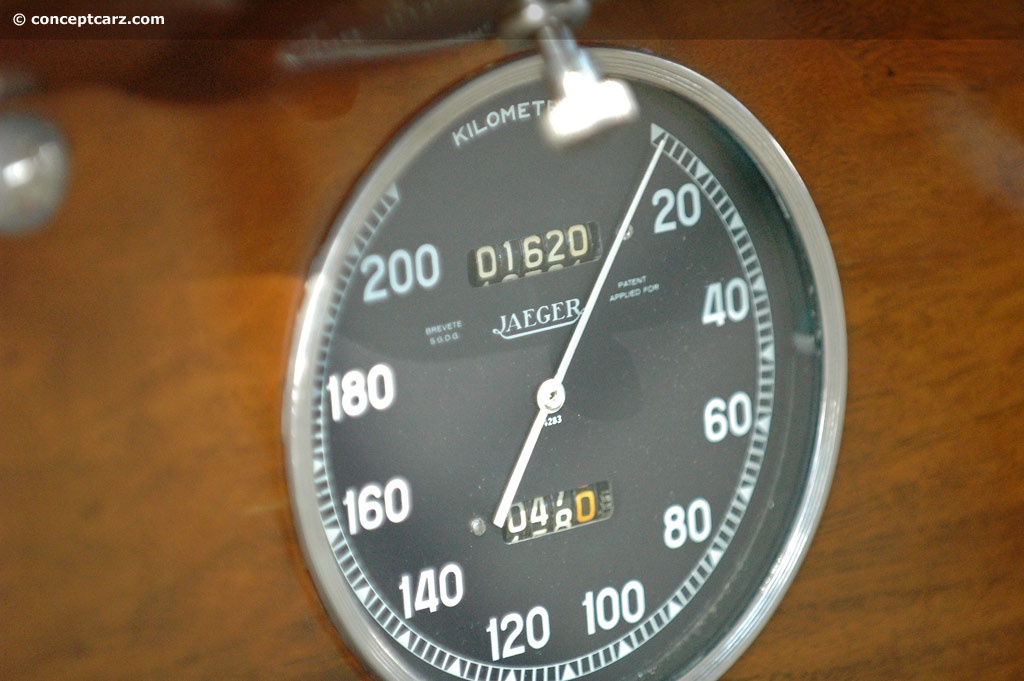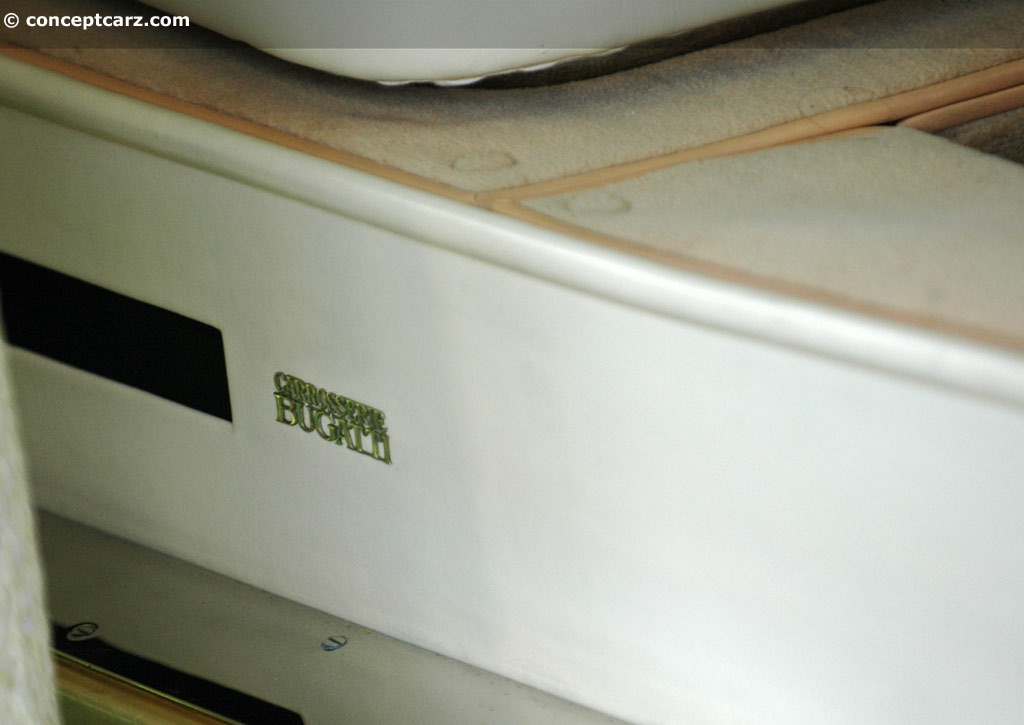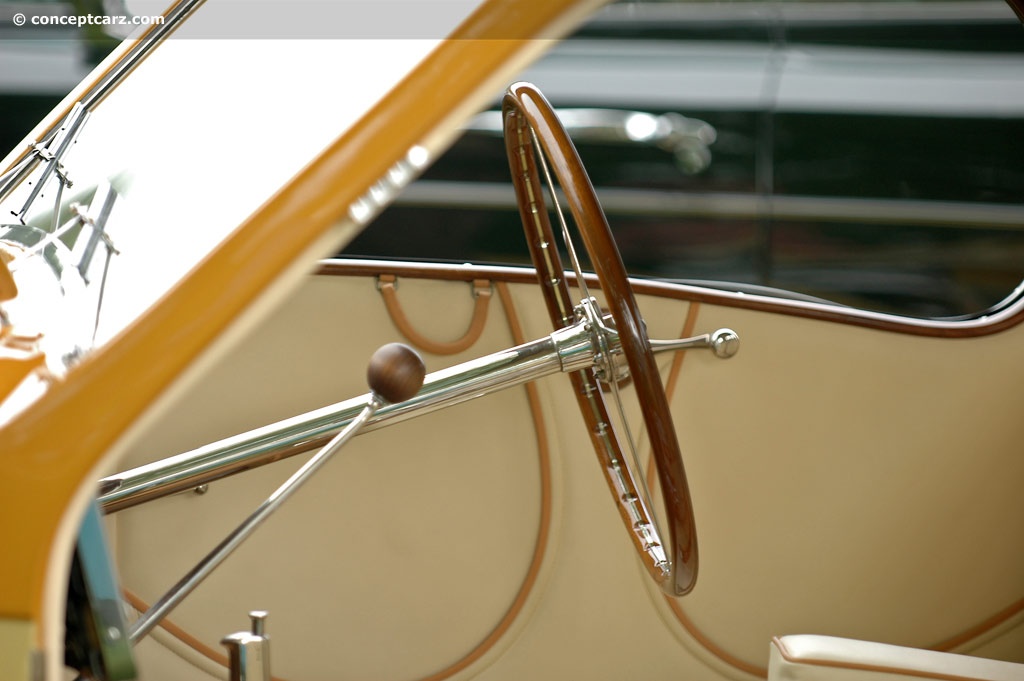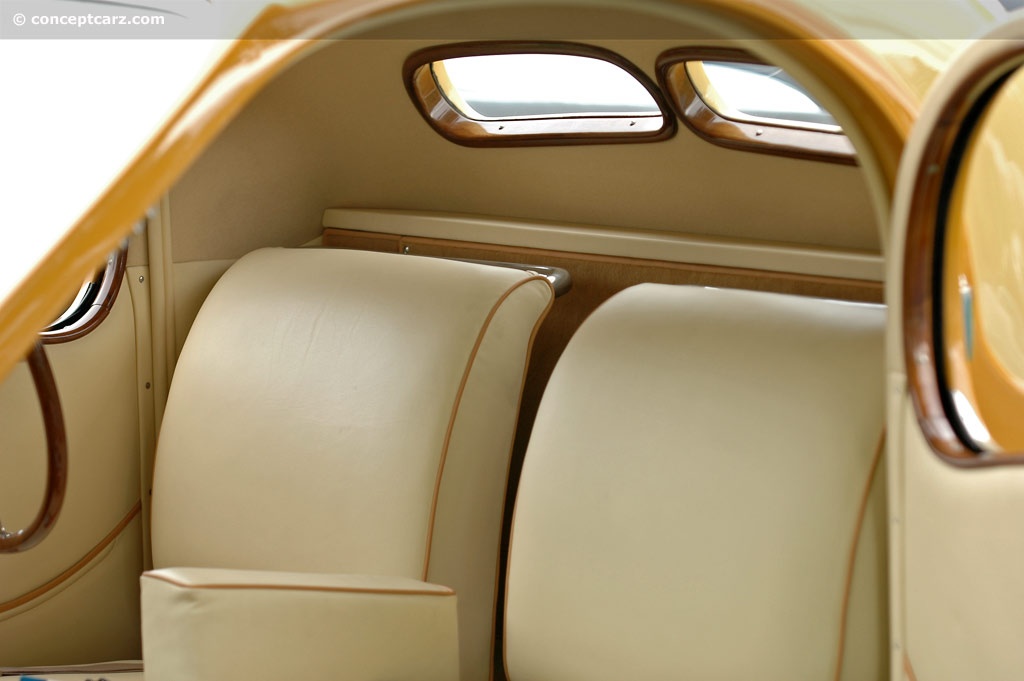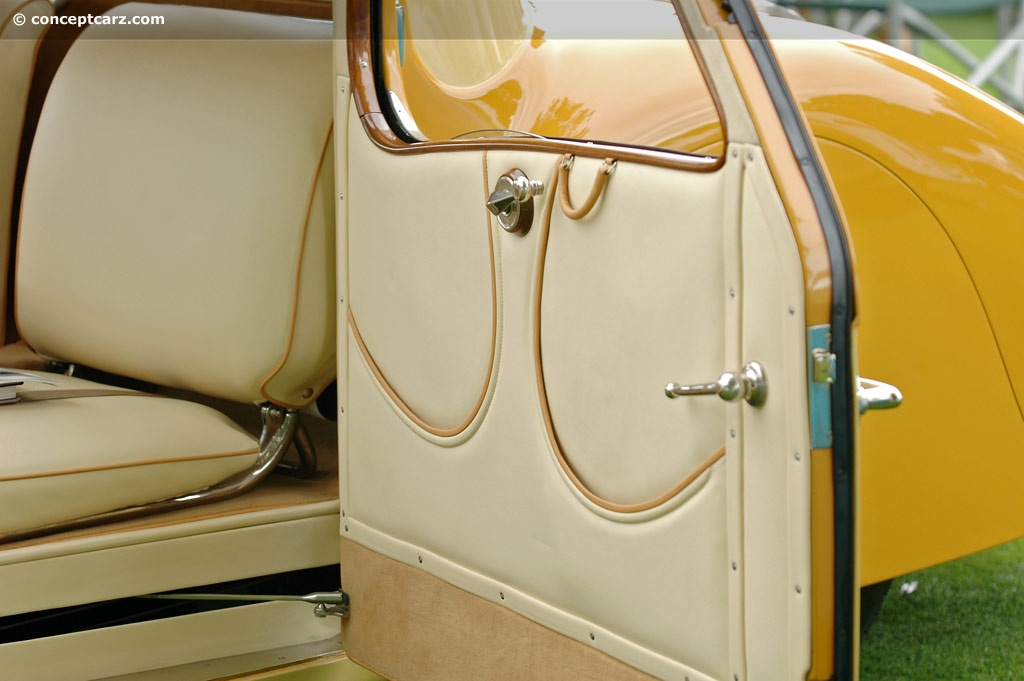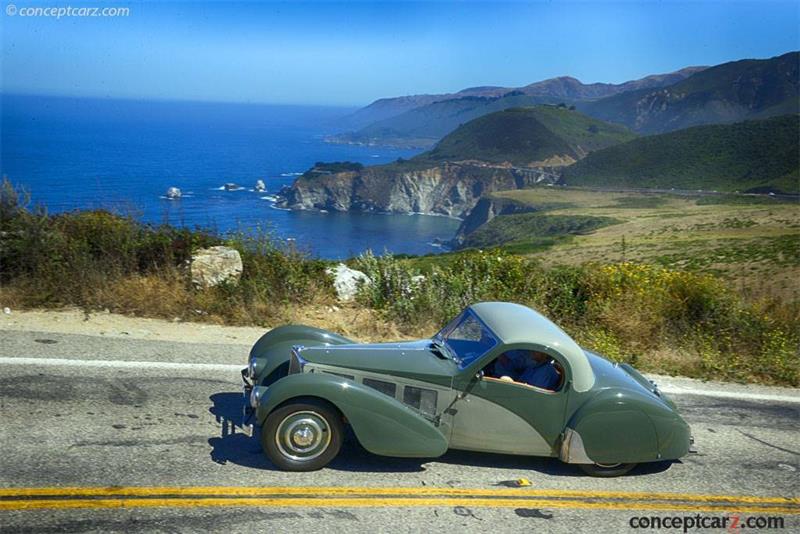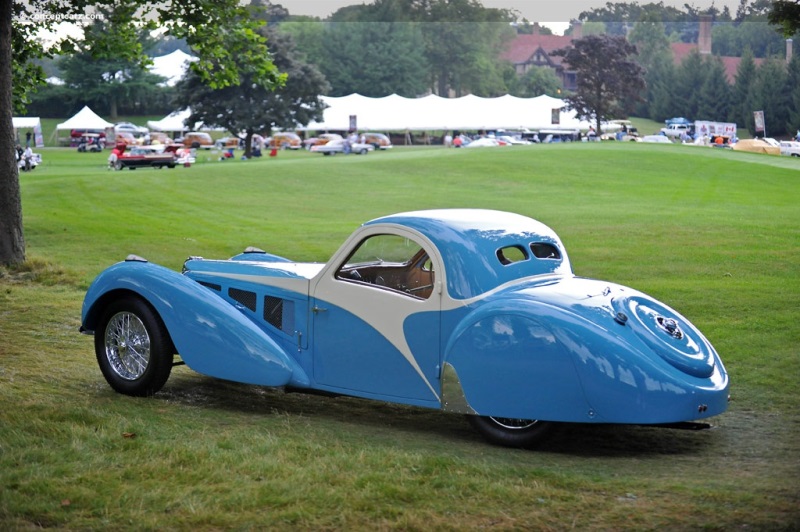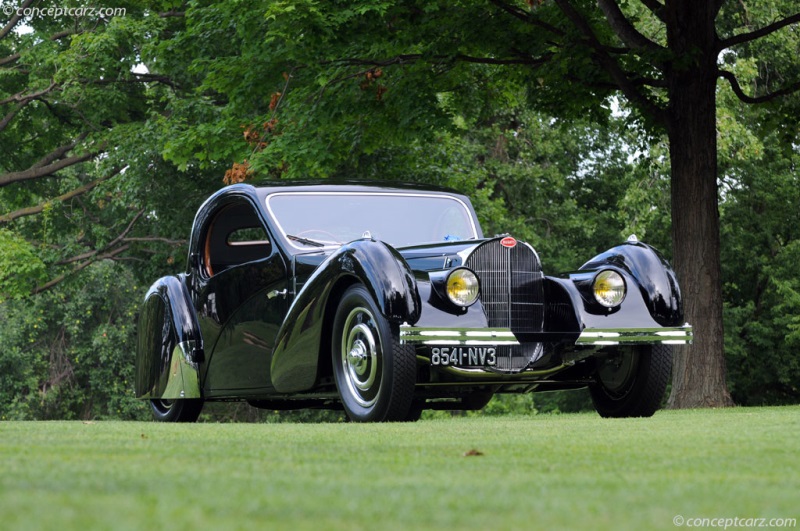Image credit: © conceptcarz.com (Reproduction Or reuse prohibited).
This Bugatti Type 57SC Atalante is the first of four built in the summer of 1937 with streamlined headlights. It was finished in black with pigskin upholstery. The body, with its low headlight placement between the radiator and front fenders, is identical to the car shown at the 1937 Paris Auto Salon. Its first owner used the Atalante until the beginning of the war and then stored it away. After the war, it was acquired by a Parisian owner and displayed at the 1949 concours on the Bois de Boulogne. After passing through several other owners, Colin Doane, a US Air Force officer, brought it to the United States. In 1961 he sold it to William Harrah, who restored the car and returned it to the original configuration, recreating the original small rear windows and removing some of the chrome embellishments that had been added. In addition to refinishing the Bugatti in its present colors of Patrol Cream and Lemon Oxide, a supercharger was installed, bringing it up to the ultimate Type 57SC specifications. Completed in 1976, it earned the ultimate accolade: Best of Show at the 26th Pebble Beach Concours d'Elegance.
For the first time, Bugatti mounted the 4-speed manual transmission integrally with the engine. The 3,257 cc (3.3-liter) twin overhead-cam, in-line, 8-cylinder engine developed 200 horsepower and had a top speed of 112 miles per hour. The coupe weighs 3,415 pounds.
After being in the care of the Patterson Collection for 13 years, the car was sent to RM for restoration in 2014. Amidst the restoration, some early body modifications were removed, the wood structure for its original tail was discovered, and the Atalante was returned to its original configuration.
For the first time, Bugatti mounted the 4-speed manual transmission integrally with the engine. The 3,257 cc (3.3-liter) twin overhead-cam, in-line, 8-cylinder engine developed 200 horsepower and had a top speed of 112 miles per hour. The coupe weighs 3,415 pounds.
After being in the care of the Patterson Collection for 13 years, the car was sent to RM for restoration in 2014. Amidst the restoration, some early body modifications were removed, the wood structure for its original tail was discovered, and the Atalante was returned to its original configuration.
The early and mid-thirties were a difficult time in France. The institutions and inward-looking society which had supported the country during the early years of the Great Depression began to crumble. Socialism gained the upper hand and social and labor unrest swept the country.
Bugatti in Molsheim was largely insulated by its remoteness, self-centered organization and the loyalty of its wealthy French clientele. Cracks began to appear in Le Patron's paternalistic fiefdom in the early thirties, however, as the economic malaise sweeping France and the world began to be seen in Bugatti production. From a high of 632 cars in 1930, mostly highly profitable and luxurious Type 44 and 46 models, it plummeted down to 376 in 1931, 136 in 1932, and cratered at just 61 cars in 1933. The factory shut down completely in the winter of 1933-34.
The medium of its survival were railcars for the French railways powered by the gigantic engines designed for the Type 41 Royale. Bugatti was able to survive on the strength of construction of the state-funded prototype in 1933 and production of 12, 30, 28 and 15 railcars in each of the subsequent years 1934-37, although the industrial workers who came to Molsheim for this project added a radical industrial element to the artisanal culture that resulted in Ettore Bugatti's being locked out of his own factory in 1936. It cemented his resolve to remain in Paris where he had set up a design office in the early 30's and where design work on the railcars had preoccupied him while his young son Jean managed the Molsheim factory.
Jean Bugatti had been brought up in the family tradition of artistry, passed down from his father, Ettore, and grandfather, Carlo. He had grown up among the craftsmen and artisans who created each Bugatti automobile to the high standards of Ettore. His driving skills were honed by constant exposure to the customers and team drivers who frequented Molsheim's Hostellerie du Pur Sang and tested the company's latest competition cars on the surrounding roads. He was an excellent high-speed driver and would have been successful in competition, except that his father, concerned for succession in the family business, forbade racing. Jean turned his talents to testing, a decision that would result in his premature demise.
As the thirties unfolded it became apparent that Bugatti's multi-model strategy was inappropriate both for the makeup of the market and for efficient procurement, manufacturing and production. Even as production declined in 1931 and 1932 Bugatti built seven different models. In the near-disastrous year of 1933 the 61 vehicles built were in five different models.
Jean Bugatti recognized that the problem's solution was design and development of a new single model that could serve all – or at least most – of Bugatti's markets for sedans, touring, sports and even sports-racing cars. The basis for this new model was the dual overhead camshaft Type 51 GP and Type 55 high performance road cars, themselves derived from Bugatti's exposure to the supercharged Miller 91s traded to Bugatti by Leon Duray in 1929. While related to Bugatti's traditional engines, however, the new model, the Bugatti Type 57, was a completely new design, drawn up from clean sheets of paper by Molsheim designers under Jean Bugatti's direction.
Ettore was busy in Paris on the railcars, leaving Jean in full charge of Molsheim subject only to regular communications with his father in writing and on weekly visits to Paris. The Type 57, then, took on a very different character, reflecting the maturation of Jean Bugatti, then only in his early twenties. The first Type 57 prototype included a split front axle which hinted at the driving characteristics of independent front suspension. It was a radical departure from established Bugatti practice, so radical that as soon as Ettore became aware of it he instructed Jean to abandon it.
The engine at the core of the Type 57 was a dual overhead camshaft inline eight-cylinder with the cylinder block and head cast in one piece and bolted to an aluminum crankcase with six main bearings for the one-piece crankshaft with plain bearings and full pressure lubrication. The camshafts, set at an included angle of 93 degrees and operating the valves directly, were powered by a helical gear train located at the rear of the engine. All earlier Bugattis had their camshaft drives at the front. Another major departure was the Type 57's transmission, a four-speed box with constant mesh helical gears in the top three speeds which mounted to the engine and clutch assembly. The clutch, too, marked a change in Bugatti practice, replacing Ettore's favored small diameter multi-plate clutch with a single plate design. Auxiliaries were placed on the side of the engine.
With 72mm bore and 100mm stroke, the Type 57 displaced 3,257cc. Initial single carburetor touring versions of the engine made 135 brake horsepower at 5,000 rpm.
The split front axle was superseded by a traditional Bugatti-style forged solid axle with semi-elliptical leaf springs balanced at the rear with a live axle that also followed established Molsheim precedent with a torque arm for location and reversed quarter-elliptical leaf springs for support. Robustly designed and built, the frame itself gained additional rigidity from the engine mounts. Brakes continued to be cable operated with elaborate and effective compensation adjustments.
Serious production began in 1934 and continued through the end of operations with the onset of war in 1939. A number of variations were developed including supercharging on the Type 57C introduced in 1937. Most notably, however, the Type 57 provided the basis upon which Jean Bugatti could display his formidable talent as a designer of coachwork. Most of the Type 57s built – and all of the important ones – carried Jean Bugatti-designed coachwork, noted for its fluidity, elegance, balance, proportion and creative use of color. The Galibier sedan, Ventoux coach (two-door sedan) and Stelvio drophead coupé were the bulk of Type 57 production. Later joined by the Atalante coupé, Bugatti coachwork was built in Molsheim's own coachworks or at nearby Gangloff of Colmar.
Bugatti's clients soon sought sports versions of the Type 57 to which Bugatti responded with the Grand Raid Roadster in 1934 and the modified and uprated Type 57T with torpedo coachwork in 1935. These special factory-modified Type 57s demonstrated both the adaptability of the basic Type 57 design and the market for a high performance Type 57, sending Jean Bugatti and his designers back to the board to create the ultimate Bugatti, the Type 57S.
The basis of the Type 57S was a dramatically revised chassis frame with deep section rails through which the rear axle passed. Described by Bugatti as surbaissé, the low chassis design enabled Bugatti to further streamline his coachwork and reduce frontal area. Driver and passenger sit within the frame rails with their heels on the same level as the lower extremity of the frame rails. The front axle is a split hollow forging joined at the center with a collar and internal bushing which allows the two halves to rotate independently but is otherwise like a solid axle. The Type 57S engine had to be modified due to its lower chassis and was converted to dry sump with separate scavenge and pressure pumps and supply from a 20-liter (21-quart) tank.
By now Bugatti had adopted flexible engine mounts and added provisions for mounting the deRam hydraulic shock absorbers directly to the front of the engine block and also for installing a Roots supercharger driven from the camshaft drive system at the rear of the engine. Running at 1.17 times engine speed at 5-6psi boost pressure, it kicked the Type 57C engine up to a very lively 170 horsepower and brought top speeds to the region of 120 mph. The supercharger was an option from the inception of the Type 57S but is believed to have been installed on only one or two of the first models delivered. The factory, however, did a lively business in upgrading unblown Type 57S chassis with superchargers right through the fifties.
The first Type 57S debuted at the 1935 London Motor Show bodied with dramatic fastback Aérolithe coachwork, a style which was eventually refined into the Atlantic coupé. Eventually only 48 of the exclusive, sophisticated, rapid and beautifully constructed Type 57S Bugattis would be built of which only seventeen were bodied with the beautiful, elegant, athletic Atalante coupé style.
Bugatti Type 57S chassis 57551 with engine number 30S was completed on July 23, 1937, with an Atalante body finished in black with pigskin upholstery. The body configuration, with its low headlight placement between the radiator and front fenders, was identical to the October 1937 Paris show car. It was delivered by the factory just a week later to its first owner, Jean Lévy of Strasbourg, Deputy Administrator of the family-owned 'Grands Moulins de Strasbourg', a successful grain milling company established by his father, which is still in business today.
Lévy used his Atalante until the beginning of the war and transferred it to Maurice Weber, manager of the livestock feed operation at the Grands Moulin, in 1941, presumably for safekeeping. In 1946 the Atalante was sold by Weber, ending up in the summer of 1947 with Pierre Pruvost in Bezons. A year later it was acquired by a Paris owner and displayed at the June 15, 1949 concours in the Bois de Boulogne.
It was registered in 1951 to the well-known French artist André Derain, a contemporary of Matisse and Vlaminck with whom Derain exhibited in 1905 in a Salon where their exhibit area was described as la Cage aux Fauves (the cage of wild beasts) at the birth of the style known as Fauvism. He and Pablo Picasso were later colleagues. After World War II Derain was actively engaged in designing theatrical productions and illustrating books, but before following the career of an artist Derain had trained as an engineer, no doubt adding to his appreciation for the design, handling and performance of the Type 57S Atalante.
In 1959 the Nice dealership of Ernest Friderich sold the car to Jean-Louis Fatio, then through Fatio's associate Robert Baer to Colin Doane, an U.S. Air Force officer who brought it to the United States. Doane drove it three thousand miles over the next two years, including a 500 mile trip from Boston to Watkins Glen.
In 1961 Doane sold it to the fabled collection of casino magnate William Harrah. While in the Harrah's Collection it received a comprehensive restoration with the chassis and running gear restored by O.A. 'Bunny' Phillips and the body in the Harrah's shops. Several aspects of the Atalante were returned to the original configuration including re-creating the original pair of small rear windows and removing some of the chrome embellishments which had been added in France in the late forties.
In addition to refinishing the Bugatti in its present colors of Patrol Cream and Lemon Oxide during its time in the Harrah's Collection, the present supercharger was installed, bringing it to the ultimate Type 57SC specifications. With the usual thoroughness and extensive research which characterized cars restored for Harrah's, the hydraulic brakes that had been installed at some point were replaced with a set of original Bugatti Type 57 mechanical brakes obtained from Howard Greene. Chromium plating was stripped and replated with the correct nickel. Completed in 1976, it earned the ultimate accolade for quality, appearance, design and performance: Best of Show at the 26th Pebble Beach Concours d'Elegance.
It was acquired during the disposition of the Harrah's Collection by Dr. Herbert Boyer and later was acquired from him by the present owner who has continued to maintain it carefully and meticulously as restored by Harrah's over thirty years ago. During the current gentleman's ownership, further work was executed including a complete engine rebuild by noted specialist Mr. Phil Reilly in the mid-1990s. Since then the Bugatti has been exercised regularly, but for limited distances only and it remains in virtual break-in condition. Notably, the Bugatti's next owner will have the further distinction of carefully breaking in the engine to their personal specifications.
The colors chosen by Harrah's to highlight Bugatti's design and win Best of Show at Pebble Beach in 1976 are still attractive, handsome and harmonize with the lines of Jean Bugatti's coachwork. It is one of the most beautiful, desirable and advanced of all Bugattis, with Jean Bugatti's lean, sleek, aggressive Atalante coachwork perfectly complemented by the low Type 57S surbaissé chassis. In 2002 the present owner also commissioned a professional refurbishment of the cosmetics on the car, removing much of the spidering from age and returning it to its fully restored original glory. Today the Atalante looks as good as it runs and drives, a true testament to the recent meticulous care of a peerless original restoration.
Bugatti Type 57SC Atalante coupé number 57551 is the first of only four built in the summer of 1937 with streamlined headlights. It has a well-documented history from new and is one of the most attractive, desirable and best-performing of all Bugatti road cars. It is capable of a true 120mph on the road, but its appearance, history, rarity and design will accelerate its owner's heart rate even higher. Without question, these stunning Bugattis remain the very definition of art in motion, and this particular example, exemplified by its noteworthy provenance is the very pinnacle of their limited production.Source - RM Auctions
Bugatti in Molsheim was largely insulated by its remoteness, self-centered organization and the loyalty of its wealthy French clientele. Cracks began to appear in Le Patron's paternalistic fiefdom in the early thirties, however, as the economic malaise sweeping France and the world began to be seen in Bugatti production. From a high of 632 cars in 1930, mostly highly profitable and luxurious Type 44 and 46 models, it plummeted down to 376 in 1931, 136 in 1932, and cratered at just 61 cars in 1933. The factory shut down completely in the winter of 1933-34.
The medium of its survival were railcars for the French railways powered by the gigantic engines designed for the Type 41 Royale. Bugatti was able to survive on the strength of construction of the state-funded prototype in 1933 and production of 12, 30, 28 and 15 railcars in each of the subsequent years 1934-37, although the industrial workers who came to Molsheim for this project added a radical industrial element to the artisanal culture that resulted in Ettore Bugatti's being locked out of his own factory in 1936. It cemented his resolve to remain in Paris where he had set up a design office in the early 30's and where design work on the railcars had preoccupied him while his young son Jean managed the Molsheim factory.
Jean Bugatti had been brought up in the family tradition of artistry, passed down from his father, Ettore, and grandfather, Carlo. He had grown up among the craftsmen and artisans who created each Bugatti automobile to the high standards of Ettore. His driving skills were honed by constant exposure to the customers and team drivers who frequented Molsheim's Hostellerie du Pur Sang and tested the company's latest competition cars on the surrounding roads. He was an excellent high-speed driver and would have been successful in competition, except that his father, concerned for succession in the family business, forbade racing. Jean turned his talents to testing, a decision that would result in his premature demise.
As the thirties unfolded it became apparent that Bugatti's multi-model strategy was inappropriate both for the makeup of the market and for efficient procurement, manufacturing and production. Even as production declined in 1931 and 1932 Bugatti built seven different models. In the near-disastrous year of 1933 the 61 vehicles built were in five different models.
Jean Bugatti recognized that the problem's solution was design and development of a new single model that could serve all – or at least most – of Bugatti's markets for sedans, touring, sports and even sports-racing cars. The basis for this new model was the dual overhead camshaft Type 51 GP and Type 55 high performance road cars, themselves derived from Bugatti's exposure to the supercharged Miller 91s traded to Bugatti by Leon Duray in 1929. While related to Bugatti's traditional engines, however, the new model, the Bugatti Type 57, was a completely new design, drawn up from clean sheets of paper by Molsheim designers under Jean Bugatti's direction.
Ettore was busy in Paris on the railcars, leaving Jean in full charge of Molsheim subject only to regular communications with his father in writing and on weekly visits to Paris. The Type 57, then, took on a very different character, reflecting the maturation of Jean Bugatti, then only in his early twenties. The first Type 57 prototype included a split front axle which hinted at the driving characteristics of independent front suspension. It was a radical departure from established Bugatti practice, so radical that as soon as Ettore became aware of it he instructed Jean to abandon it.
The engine at the core of the Type 57 was a dual overhead camshaft inline eight-cylinder with the cylinder block and head cast in one piece and bolted to an aluminum crankcase with six main bearings for the one-piece crankshaft with plain bearings and full pressure lubrication. The camshafts, set at an included angle of 93 degrees and operating the valves directly, were powered by a helical gear train located at the rear of the engine. All earlier Bugattis had their camshaft drives at the front. Another major departure was the Type 57's transmission, a four-speed box with constant mesh helical gears in the top three speeds which mounted to the engine and clutch assembly. The clutch, too, marked a change in Bugatti practice, replacing Ettore's favored small diameter multi-plate clutch with a single plate design. Auxiliaries were placed on the side of the engine.
With 72mm bore and 100mm stroke, the Type 57 displaced 3,257cc. Initial single carburetor touring versions of the engine made 135 brake horsepower at 5,000 rpm.
The split front axle was superseded by a traditional Bugatti-style forged solid axle with semi-elliptical leaf springs balanced at the rear with a live axle that also followed established Molsheim precedent with a torque arm for location and reversed quarter-elliptical leaf springs for support. Robustly designed and built, the frame itself gained additional rigidity from the engine mounts. Brakes continued to be cable operated with elaborate and effective compensation adjustments.
Serious production began in 1934 and continued through the end of operations with the onset of war in 1939. A number of variations were developed including supercharging on the Type 57C introduced in 1937. Most notably, however, the Type 57 provided the basis upon which Jean Bugatti could display his formidable talent as a designer of coachwork. Most of the Type 57s built – and all of the important ones – carried Jean Bugatti-designed coachwork, noted for its fluidity, elegance, balance, proportion and creative use of color. The Galibier sedan, Ventoux coach (two-door sedan) and Stelvio drophead coupé were the bulk of Type 57 production. Later joined by the Atalante coupé, Bugatti coachwork was built in Molsheim's own coachworks or at nearby Gangloff of Colmar.
Bugatti's clients soon sought sports versions of the Type 57 to which Bugatti responded with the Grand Raid Roadster in 1934 and the modified and uprated Type 57T with torpedo coachwork in 1935. These special factory-modified Type 57s demonstrated both the adaptability of the basic Type 57 design and the market for a high performance Type 57, sending Jean Bugatti and his designers back to the board to create the ultimate Bugatti, the Type 57S.
The basis of the Type 57S was a dramatically revised chassis frame with deep section rails through which the rear axle passed. Described by Bugatti as surbaissé, the low chassis design enabled Bugatti to further streamline his coachwork and reduce frontal area. Driver and passenger sit within the frame rails with their heels on the same level as the lower extremity of the frame rails. The front axle is a split hollow forging joined at the center with a collar and internal bushing which allows the two halves to rotate independently but is otherwise like a solid axle. The Type 57S engine had to be modified due to its lower chassis and was converted to dry sump with separate scavenge and pressure pumps and supply from a 20-liter (21-quart) tank.
By now Bugatti had adopted flexible engine mounts and added provisions for mounting the deRam hydraulic shock absorbers directly to the front of the engine block and also for installing a Roots supercharger driven from the camshaft drive system at the rear of the engine. Running at 1.17 times engine speed at 5-6psi boost pressure, it kicked the Type 57C engine up to a very lively 170 horsepower and brought top speeds to the region of 120 mph. The supercharger was an option from the inception of the Type 57S but is believed to have been installed on only one or two of the first models delivered. The factory, however, did a lively business in upgrading unblown Type 57S chassis with superchargers right through the fifties.
The first Type 57S debuted at the 1935 London Motor Show bodied with dramatic fastback Aérolithe coachwork, a style which was eventually refined into the Atlantic coupé. Eventually only 48 of the exclusive, sophisticated, rapid and beautifully constructed Type 57S Bugattis would be built of which only seventeen were bodied with the beautiful, elegant, athletic Atalante coupé style.
Bugatti Type 57S chassis 57551 with engine number 30S was completed on July 23, 1937, with an Atalante body finished in black with pigskin upholstery. The body configuration, with its low headlight placement between the radiator and front fenders, was identical to the October 1937 Paris show car. It was delivered by the factory just a week later to its first owner, Jean Lévy of Strasbourg, Deputy Administrator of the family-owned 'Grands Moulins de Strasbourg', a successful grain milling company established by his father, which is still in business today.
Lévy used his Atalante until the beginning of the war and transferred it to Maurice Weber, manager of the livestock feed operation at the Grands Moulin, in 1941, presumably for safekeeping. In 1946 the Atalante was sold by Weber, ending up in the summer of 1947 with Pierre Pruvost in Bezons. A year later it was acquired by a Paris owner and displayed at the June 15, 1949 concours in the Bois de Boulogne.
It was registered in 1951 to the well-known French artist André Derain, a contemporary of Matisse and Vlaminck with whom Derain exhibited in 1905 in a Salon where their exhibit area was described as la Cage aux Fauves (the cage of wild beasts) at the birth of the style known as Fauvism. He and Pablo Picasso were later colleagues. After World War II Derain was actively engaged in designing theatrical productions and illustrating books, but before following the career of an artist Derain had trained as an engineer, no doubt adding to his appreciation for the design, handling and performance of the Type 57S Atalante.
In 1959 the Nice dealership of Ernest Friderich sold the car to Jean-Louis Fatio, then through Fatio's associate Robert Baer to Colin Doane, an U.S. Air Force officer who brought it to the United States. Doane drove it three thousand miles over the next two years, including a 500 mile trip from Boston to Watkins Glen.
In 1961 Doane sold it to the fabled collection of casino magnate William Harrah. While in the Harrah's Collection it received a comprehensive restoration with the chassis and running gear restored by O.A. 'Bunny' Phillips and the body in the Harrah's shops. Several aspects of the Atalante were returned to the original configuration including re-creating the original pair of small rear windows and removing some of the chrome embellishments which had been added in France in the late forties.
In addition to refinishing the Bugatti in its present colors of Patrol Cream and Lemon Oxide during its time in the Harrah's Collection, the present supercharger was installed, bringing it to the ultimate Type 57SC specifications. With the usual thoroughness and extensive research which characterized cars restored for Harrah's, the hydraulic brakes that had been installed at some point were replaced with a set of original Bugatti Type 57 mechanical brakes obtained from Howard Greene. Chromium plating was stripped and replated with the correct nickel. Completed in 1976, it earned the ultimate accolade for quality, appearance, design and performance: Best of Show at the 26th Pebble Beach Concours d'Elegance.
It was acquired during the disposition of the Harrah's Collection by Dr. Herbert Boyer and later was acquired from him by the present owner who has continued to maintain it carefully and meticulously as restored by Harrah's over thirty years ago. During the current gentleman's ownership, further work was executed including a complete engine rebuild by noted specialist Mr. Phil Reilly in the mid-1990s. Since then the Bugatti has been exercised regularly, but for limited distances only and it remains in virtual break-in condition. Notably, the Bugatti's next owner will have the further distinction of carefully breaking in the engine to their personal specifications.
The colors chosen by Harrah's to highlight Bugatti's design and win Best of Show at Pebble Beach in 1976 are still attractive, handsome and harmonize with the lines of Jean Bugatti's coachwork. It is one of the most beautiful, desirable and advanced of all Bugattis, with Jean Bugatti's lean, sleek, aggressive Atalante coachwork perfectly complemented by the low Type 57S surbaissé chassis. In 2002 the present owner also commissioned a professional refurbishment of the cosmetics on the car, removing much of the spidering from age and returning it to its fully restored original glory. Today the Atalante looks as good as it runs and drives, a true testament to the recent meticulous care of a peerless original restoration.
Bugatti Type 57SC Atalante coupé number 57551 is the first of only four built in the summer of 1937 with streamlined headlights. It has a well-documented history from new and is one of the most attractive, desirable and best-performing of all Bugatti road cars. It is capable of a true 120mph on the road, but its appearance, history, rarity and design will accelerate its owner's heart rate even higher. Without question, these stunning Bugattis remain the very definition of art in motion, and this particular example, exemplified by its noteworthy provenance is the very pinnacle of their limited production.Source - RM Auctions
2011 RM Auctions - Villa d'Este
Pre-Auction Estimates :
€3,250,000-€4,250,000
High Bid (Lot was not sold)
€2,100,000
2009 Automobiles of Arizona
High Bid (Lot was not sold)
USD $4,500,000
1937 Bugatti Type 57SC Atalante Auction Sales
Recent Sales of the Bugatti Type 57SC Atalante
(Data based on Model Year 1937 sales)
| 1937 BUGATTI TYPE 57SC ATALANTE Chassis#: 57523 Sold for USD$10,345,000 2022 Gooding & Company : Pebble Beach |   |
| 1937 Bugatti Type 57SC Atalante Chassis#: 57523 Sold for USD$8,745,000 2013 Gooding and Company - Pebble Beach |   |
| 1937 Bugatti Type 57S Atalante Coupé Chassis#: 57502 Sold for USD$4,382,944 2009 Bonhams - Automobiles d'Exception à Retromobile | |
| 1937 Bugatti Type 57SC Atalante Chassis#: 57511 Sold for USD$7,920,000 2008 Gooding & Company |   |
Bugatti Type 57SC Atalantes That Failed To Sell At Auction
1937 Bugatti Type 57SC Atalante's that have appeared at auction but did not sell.
| Vehicle | Chassis | Event | High Bid | Est. Low | Est. High |
|---|---|---|---|---|---|
| 1937 Bugatti Type 57SC Atalante Coupe | 57551 | 2011 RM Auctions Villa d'Este | $2,100,000 | $3,250,000 | $4,250,000 |
| 1937 Bugatti Type 57SC Atalante | 2009 Automobiles of Arizona | $4,500,000 |
Vehicles With Comparable Market Values
Similar sales to the $7,848,236 range.
| 1953 Ferrari 375 MM Spider by Scaglietti Chassis#:0366AM Sold for $7,485,000 2022 RM Sothebys : Monterey |   |
| 1954 Ferrari 375 America Vignale Cabriolet Chassis#:0353 AL Sold for $7,595,000 2022 RM Sothebys : Monterey |  |
| 1966 Ferrari 275 GTB/C by Scaglietti Chassis#:09067 Sold for $7,595,000 2022 RM Sothebys : Monterey |   |
| 1957 Ferrari 500 TRC Spider by Scaglietti Chassis#:0706 MDTR Sold for $7,815,000 2022 RM Sothebys : Monterey |   |
| 1962 Ferrari 268 SP by Fantuzzi Chassis#:0798 Sold for $7,705,000 2021 RM Sothebys : Monterey |   |
| 1966 Ferrari 275 GTB Competizione by Scaglietti Chassis#:09079 Sold for $7,705,000 2021 RM Sothebys : Monterey |   |
| 1962 Ferrari 250 GT SWB Berlinetta by Scaglietti Chassis#:3359 GT Sold for $8,145,000 2019 RM Sothebys : Monterey |   |
| 1965 Ford GT40 Roadster Prototype Chassis#:GT/108 Sold for $7,650,000 2019 RM Sothebys : Monterey |   |
| 1963 Ferrari 250 GT SWB Berlinetta Chassis#:4037 GT Sold for $7,595,000 2019 Gooding & Company : Scottsdale Arizona | |
| 1965 Ferrari 275 GTB Speciale Chassis#:06437 Sold for $8,085,000 2018 Gooding & Company : Scottsdale, Az. |   |
| 1937 Bugatti Type 57S Cabriolet by Vanvooren Chassis#:57513 Sold for $7,700,000 2017 RM Auctions : Amelia Island |   |
| 1951 Ferrari 340 America Barchetta by Touring Chassis#:0116/A Sold for $8,226,400 2016 RM Sotheby's : Monaco | |
| 1953 Jaguar XK120C Chassis#:XKC 011 Sold for $8,204,231 2016 Bonhams : The Monaco Sale | |
| 1950 Ferrari 275S/340 America Barchetta by Scaglietti Chassis#:0030MT Sold for $7,975,000 2015 RM Sotheby's : Monterey |   |
| 1962 Ferrari 400 Superamerica SWB Cabriolet by Pininfarina Chassis#:3309 SA Sold for $7,645,000 2015 RM Sotheby's : The Andrews Collection |   |
| 1959 Ferrari 250 GT LWB California Spider Chassis#:1425 GT Sold for $7,700,000 2015 Gooding & Company - Arizona |   |
| 1956 Ferrari 250 GT Berlinetta Competizione 'Tour de France' by Scaglietti Chassis#:0563 GT Sold for $8,087,520 2014 RM Auctions - London |   |
| 1966 Ferrari 275 GTB/C by Scaglietti Chassis#:09067 Sold for $7,859,998 2014 RM Auctions : Monaco |   |
| 1939 Mercedes-Benz 540K Special Roadster by Sindelfingen Chassis#:408383 Sold for $7,480,000 2013 RM Auctions - Monterey |   |
| 1960 Ferrari 250 GT SWB Berlinetta 'Competizione' by Carrozzeria Scaglietti Chassis#:1905GT Sold for $8,140,000 2013 RM Auctions - Arizona |   |
1937 Bugatti Type 57SC Atalante
• Additional valuation insight and sales data• History
• Specifications
• Image gallery
• Other Bugatti Type 57SC Atalante model years
